Allison Collection Photos
March, 1943
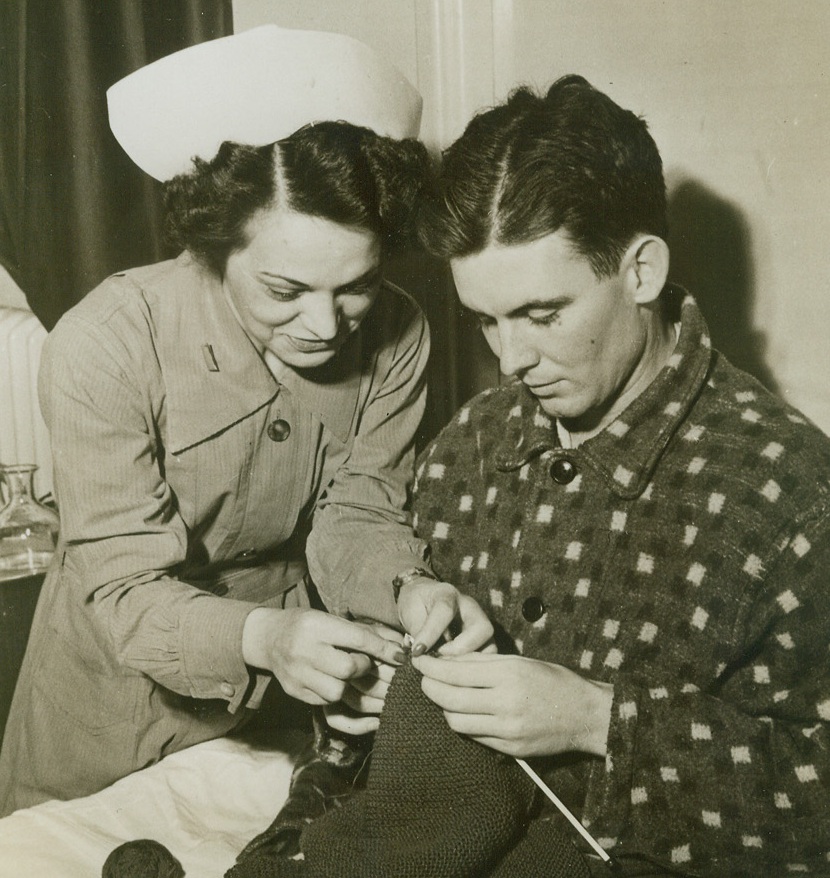
Turnabout, 3/6/1943. ENGLAND – The womenfolks back home in Kansas, have probably been knitting sweaters and socks for him since he went into the Army, but now Pfc. Huey H. Stidham is taking a hand at the needles. 2nd Lt. Gladys Swayze, of Long Island City, N.Y., is giving him the lowdown on the knit one’s, purl two’s in the occupational therapy ward of an American Army Hospital somewhere in England. (Passed by Army Censor) Credit: ACME;
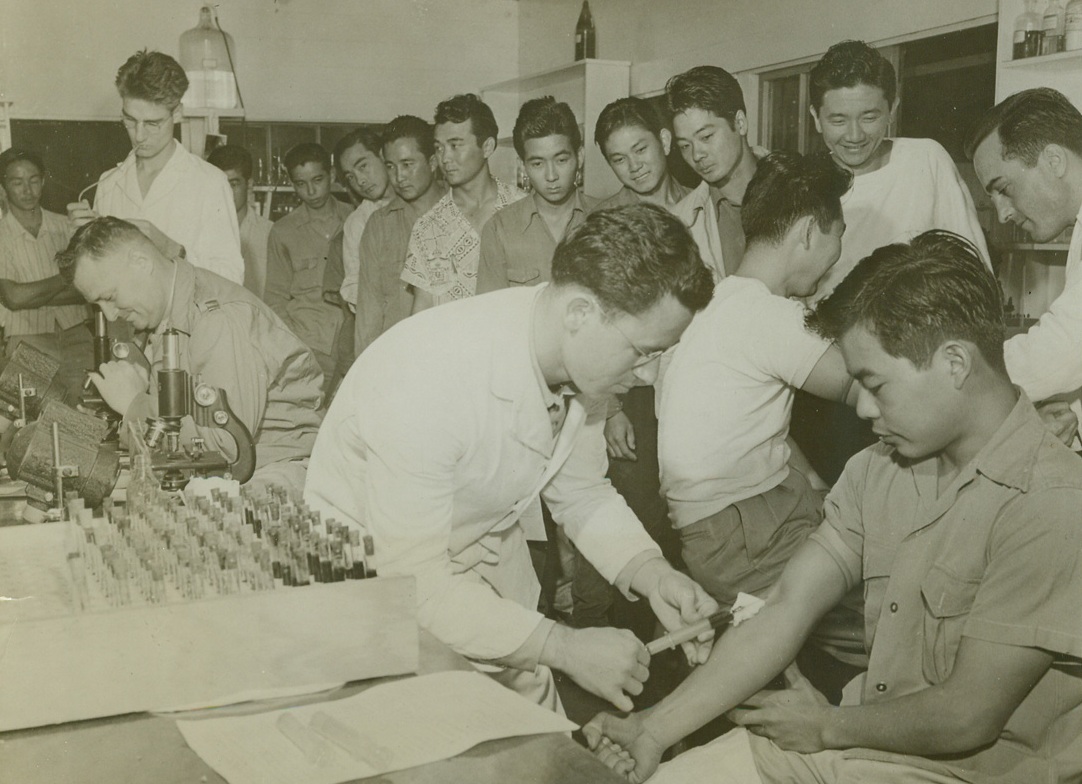
JAP MEMBERS OF NEW HAWAIIAN REGIMENT, 3/20/1943. LIHUE, KAUAI, HAWAII—these Japanese youths are shown taking their physical examinations prior to their induction into a U.S. Army combat regiment which is now being formed on the islands. While the others await their turns, this young man gets his blood test.Credit: US Army Signal Corps photo from Acme;
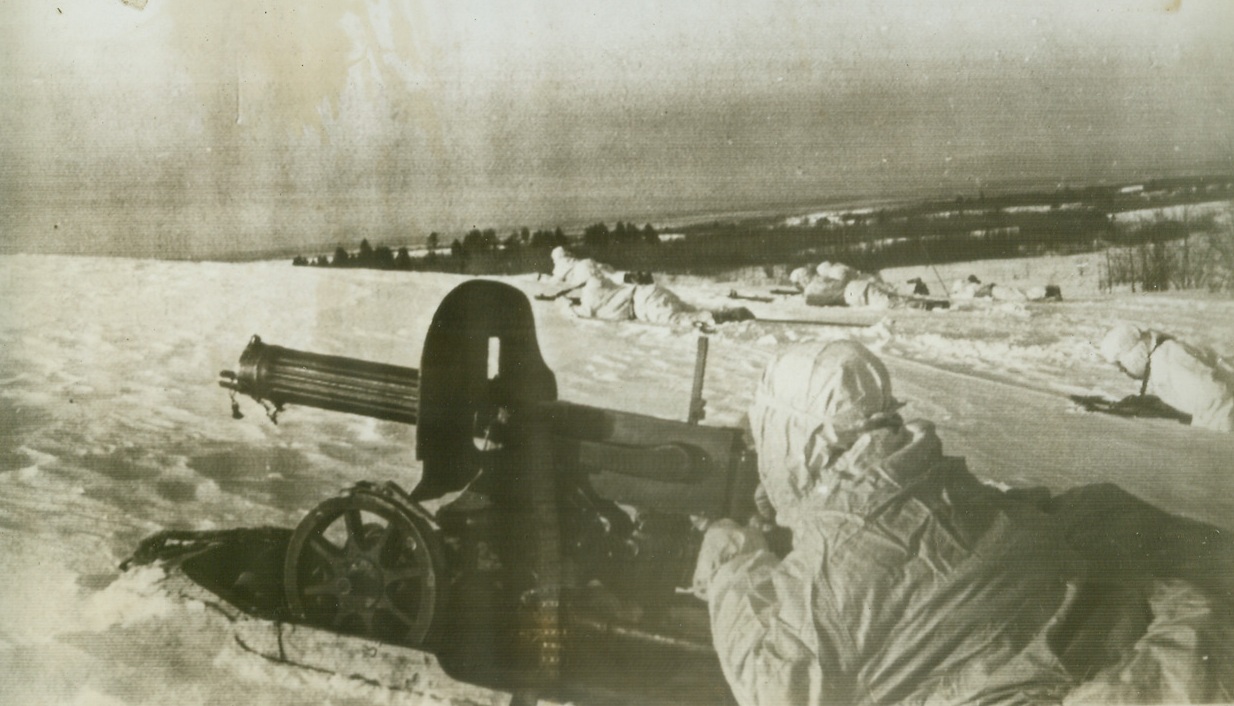
WHITE-CLAD REDS OUST NAZIS FROM DEMYANSK, 3/7/1943. DEMYANSK AREA—Far from the thawing Ukraine, white-clad Russian skiers drive back the Nazis in the Demyansk area. After ousting the Germans from this northern strongpoint, the Soviets who are skilled in the ways of winter thrust west to frozen land bordering Lake Ilmen. The Russians are apparently determined to force Hitler from the cold country before Spring sets in.Credit: Acme;
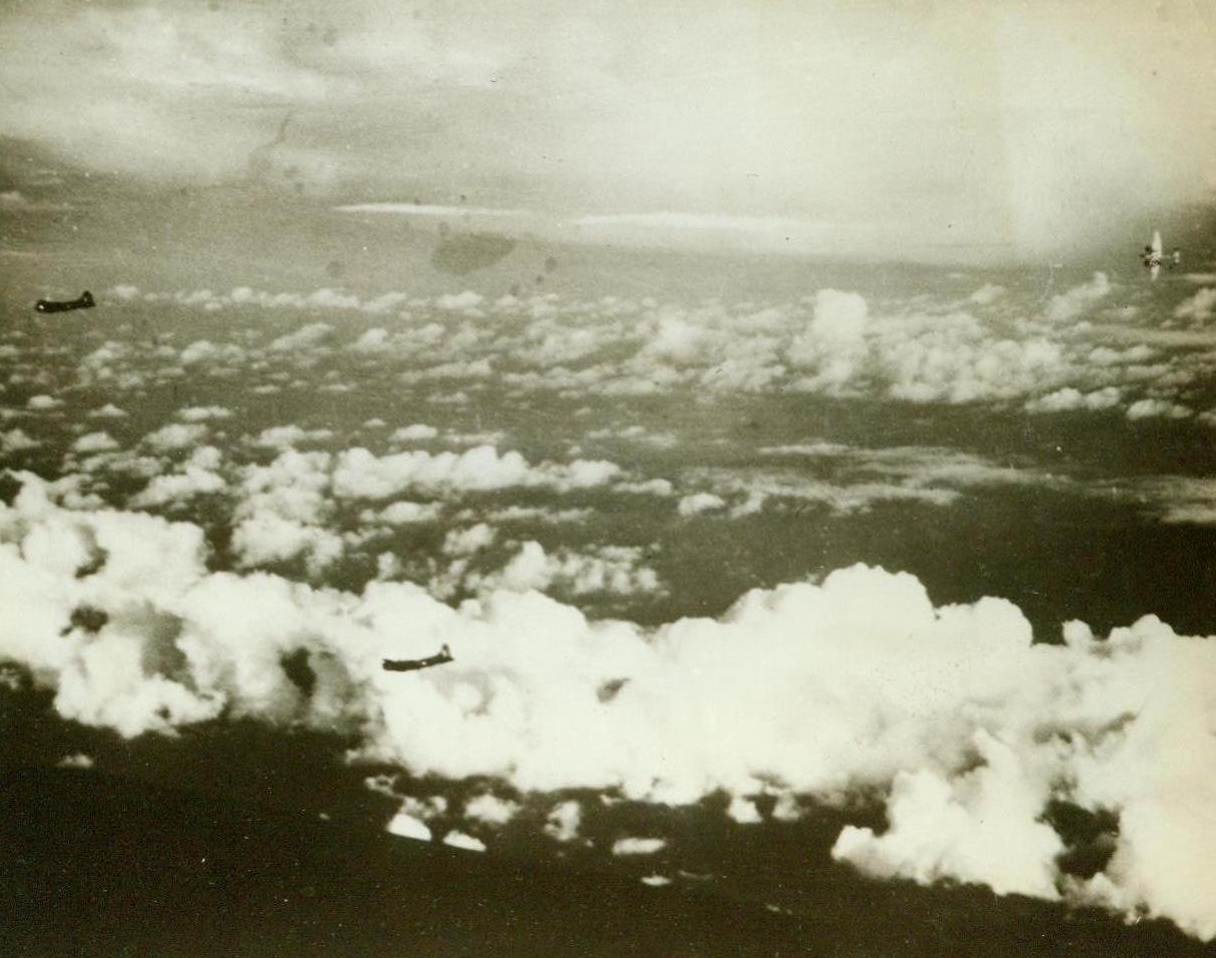
GERMAN KEPT AT DISTANCE BY FORTRESSES’ GUNS, 3/22/1943. GERMAN KEPT AT DISTANCE BY FORTRESSES’ GUNS
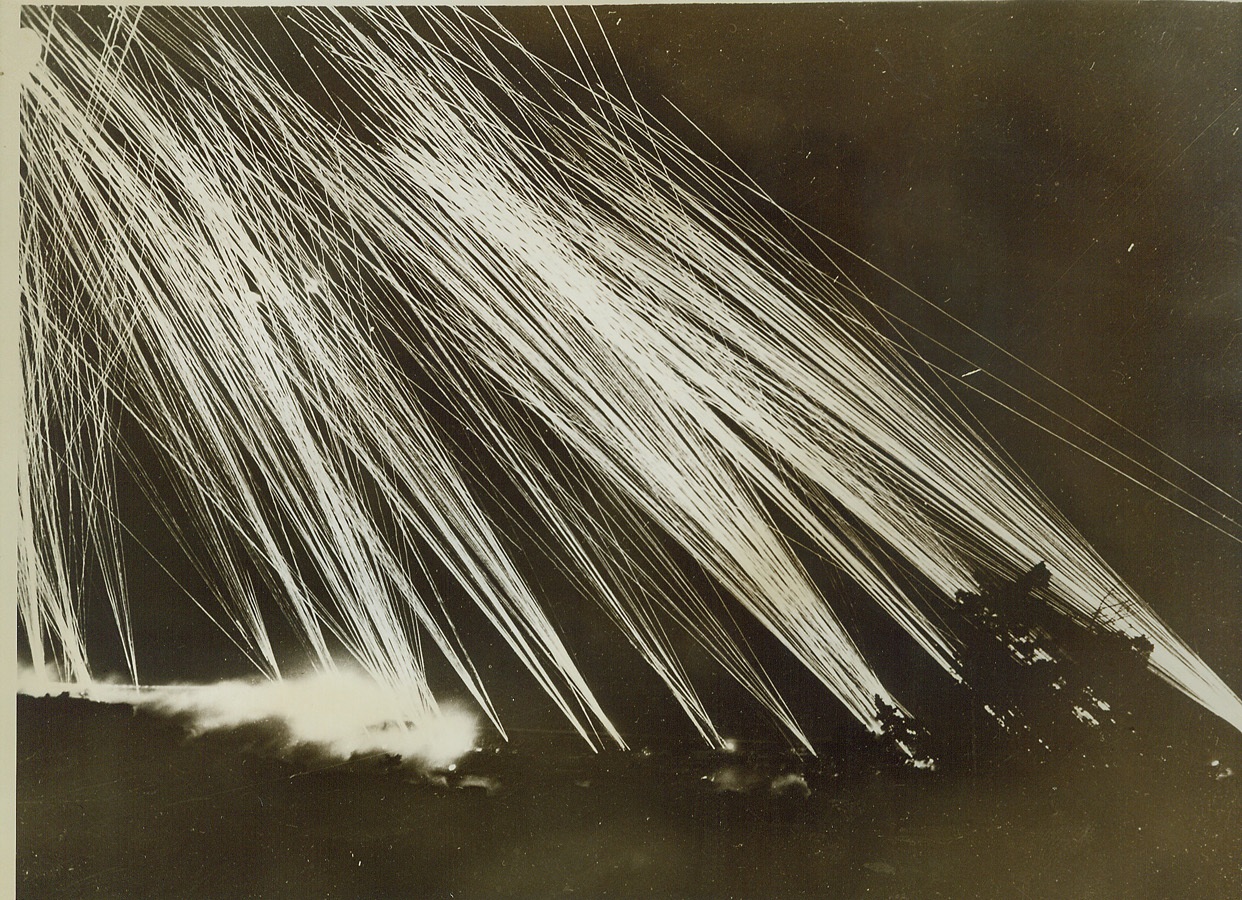
Pillar of Fire Against Foe, 3/2/1943. Algiers – Enemy planes which recently raided Algiers were met by this veritable wall of fire sent up by a massed battery of anti-aircraft guns. Needless to say, few Axis planes broke through. Credit: (ACME);
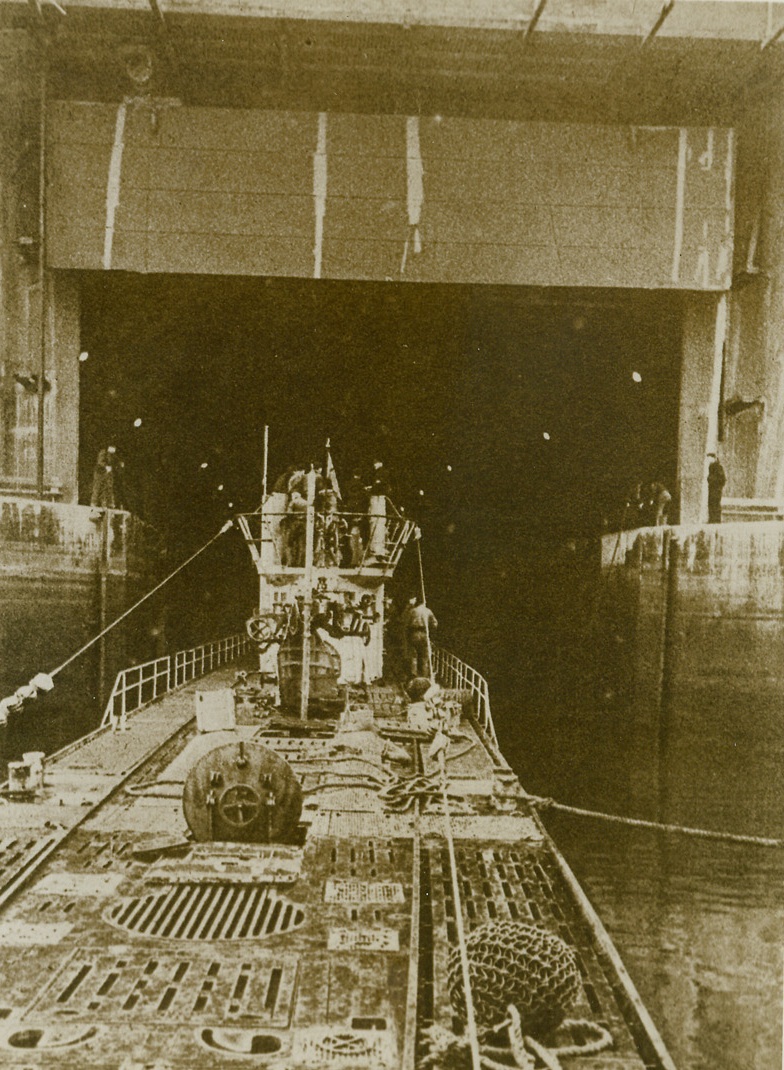
Nazi Sea Wolf Comes Home to its Den, 3/11/1943. A Nazi sub towed by tugs with French pilots moves slowly into a concrete bomb-proof shelter where it is lifted out of the water into a dry-dock in preparation for repair work. This photo was copied from a German propaganda magazine received through a neutral source. Credit: ACME.;
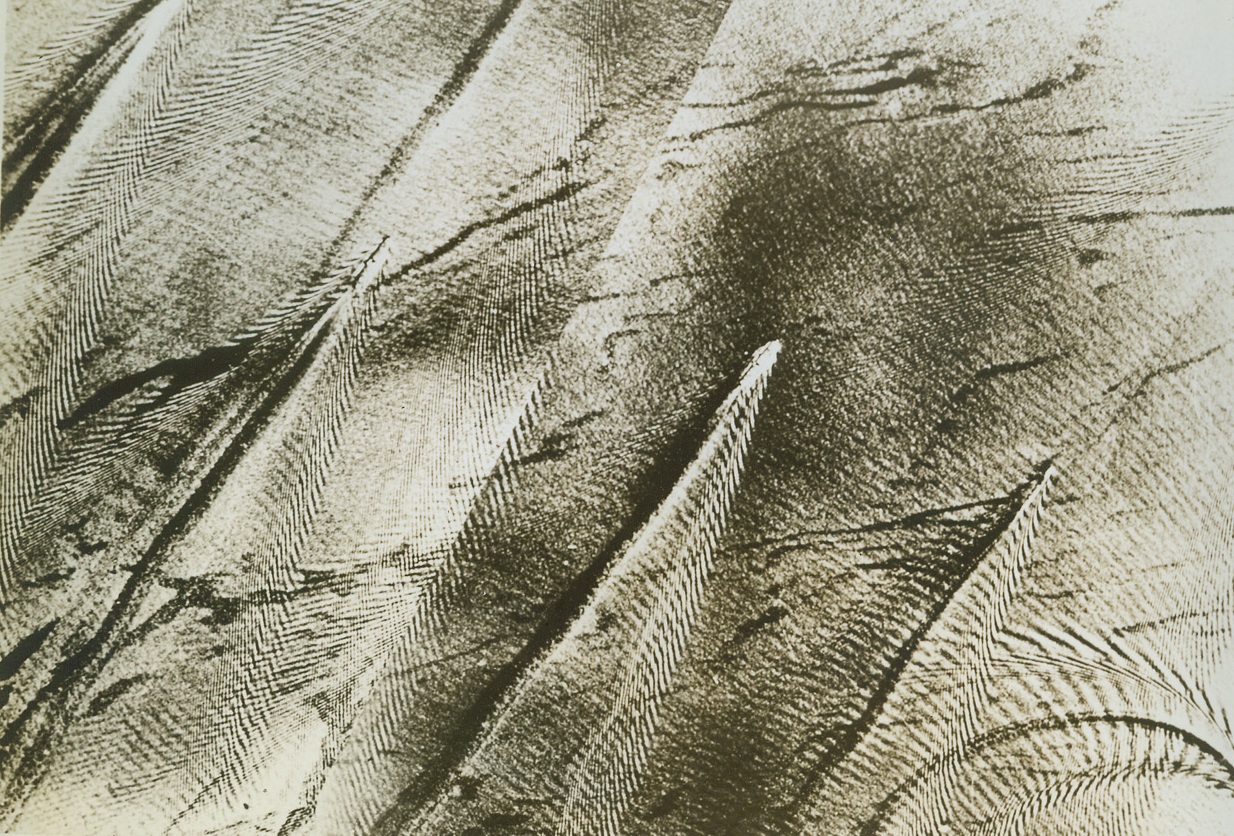
Sea of Patterns, 3/1/1943. This strange Herringbone pattern is etched by ships of an enemy convoy off the Island of Pxis in the Ionian Sea. Anticipating an air attack, which presumably followed, they began to disperse at full speed ahead to make the target more difficult. Notice at upper left, one vessel has started to spin a circle in an evasive tactic. The three center ships are merchantmen laden with deck cargo. Credit: BRITISH INFORMATION SERVICE FROM ACME.;
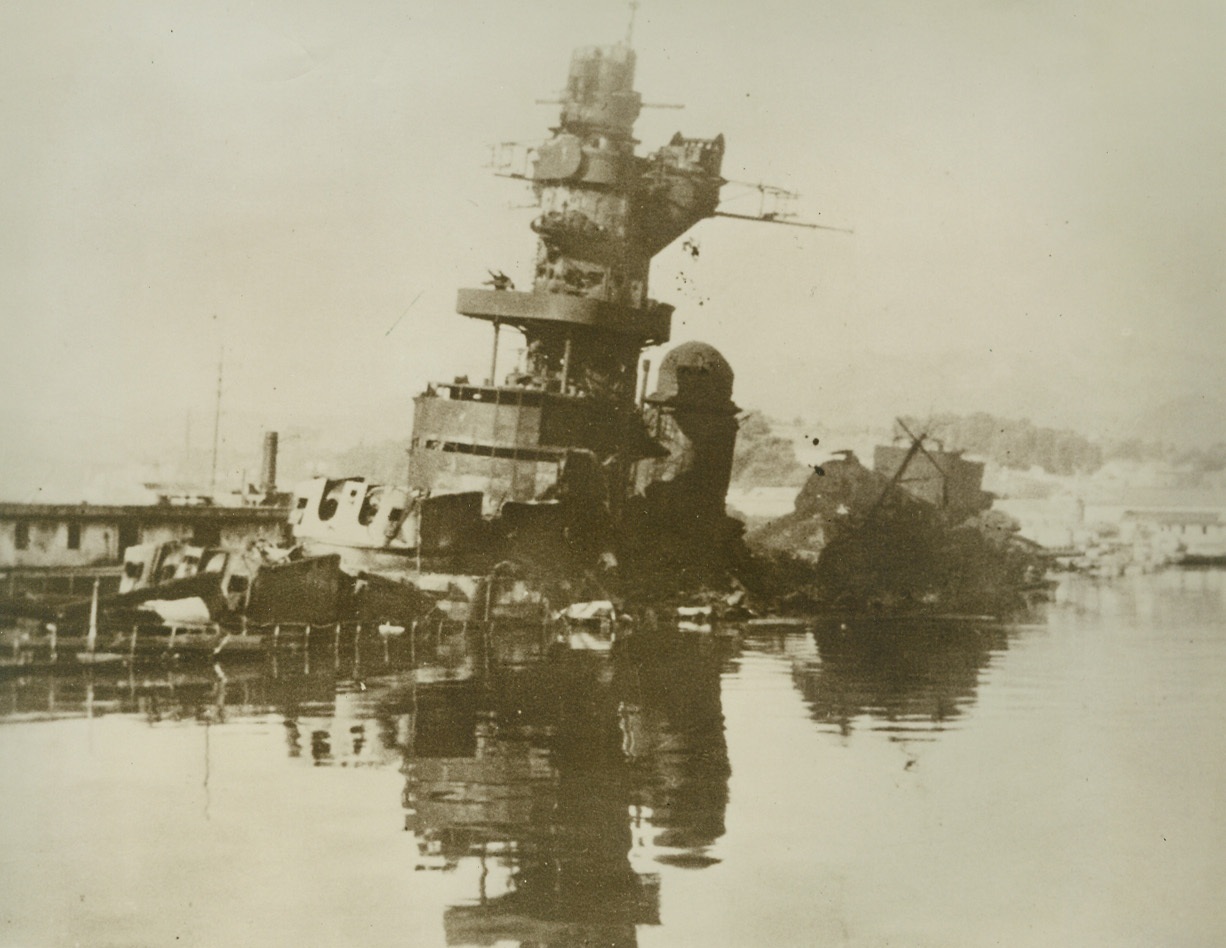
The Mighty Dunquerque at Rest, 3/2/1943. Toulon Harbor -- The battleship Dunquerque lies scuttled in Toulon Harbor with the French Fleet, from lesser auxiliary craft to destroyers and battle-cruisers -- now crewless and derelict. The RAF reported a few hours after the scuttling on November 27th that more than fifty ships were damaged or partly submerged. Ships which were not actually sunk had been dismantled by French sailors before scuttling. Credit: (ACME);
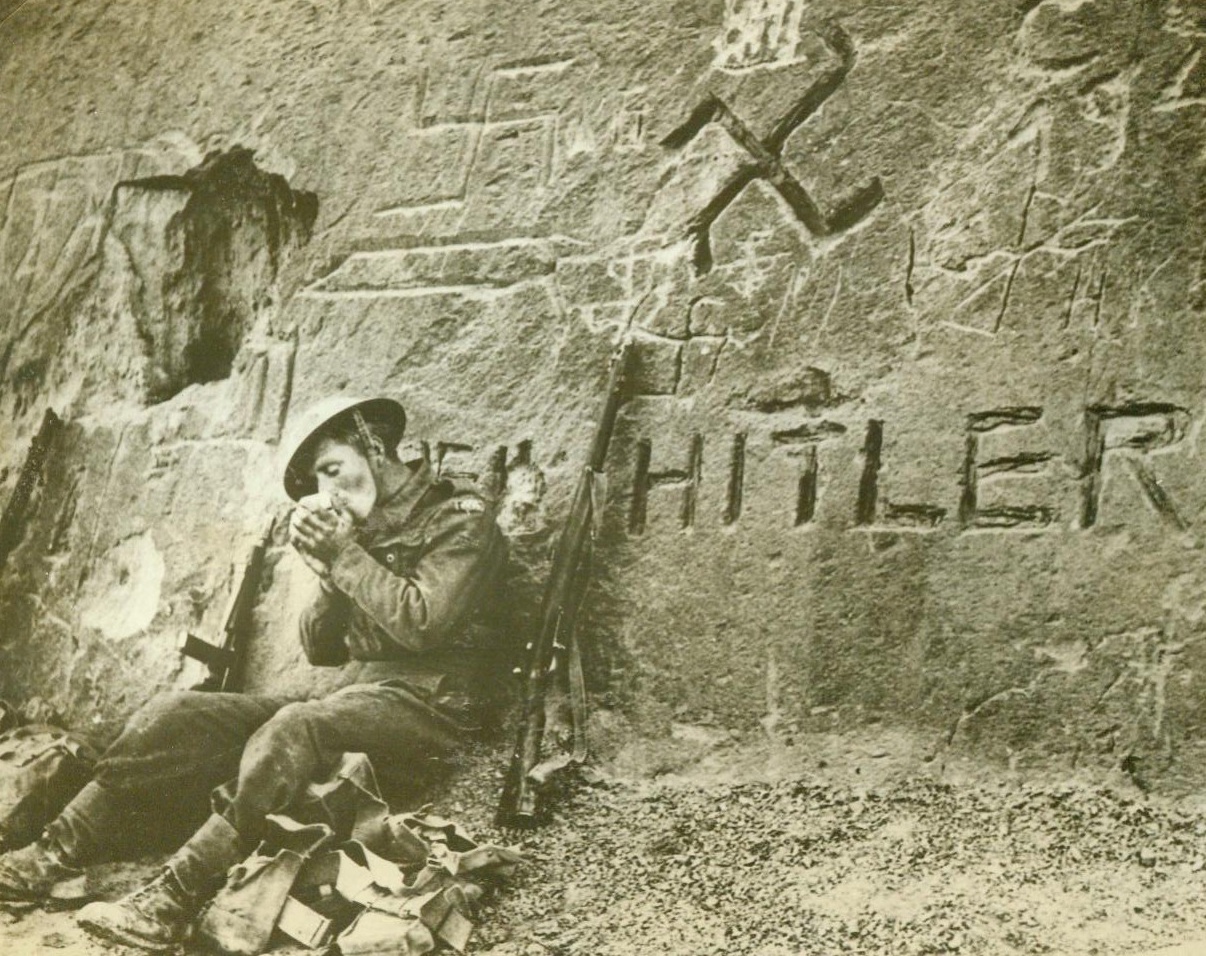
A Bit of Chiselling for Der Fueher, 3/2/1943. WESTERN DESERT - Some exponents of Nazi art, with more enthusiasm than ability, had time to decorate this rock wall with Hitlerian homelies before the British 8th Army chased the Germans out of Libya. None of the artists, however, seemed to know the correct way to reproduce the swastika - they're all wrong. A British Tommy nonchalantly lights a "fag" as he leans against the wall, which is "on the way to Tripoli.";
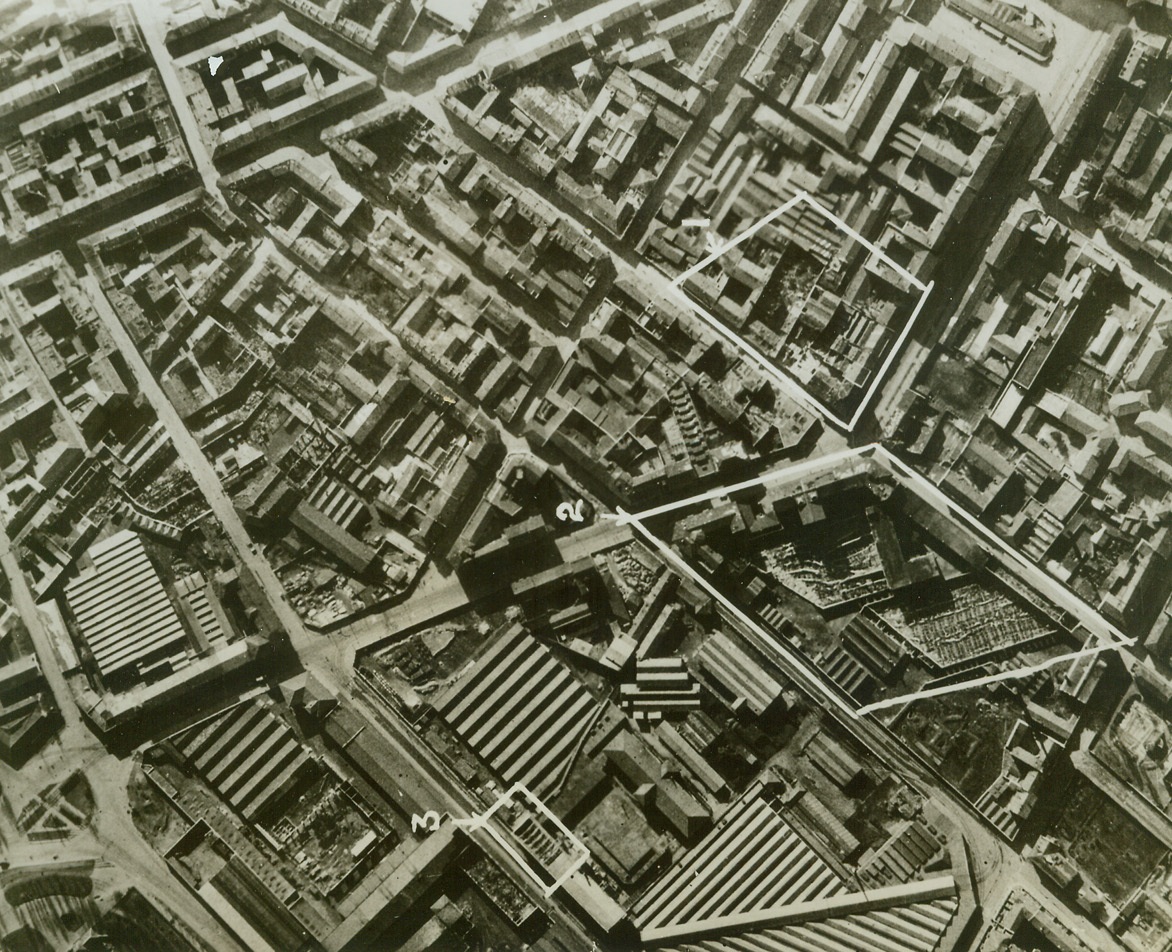
Bombed Milan, 3/24/1943. MILAN, ITALY – This low aerial photo clearly shows the damage resulting from R.A.F. raid on the night of February 14/15. Outlined areas show: (1) Destruction by high explosive of industrial buildings in Via Paolo Lomazzo, (2) two sheds destroyed and another partly gutted in elastic manufacturing establishment in Via Paolo Lomazzo, (3) Recently repaired building of Municipal Tram Depot in Via Messina again damaged.Credit Line (ACME);
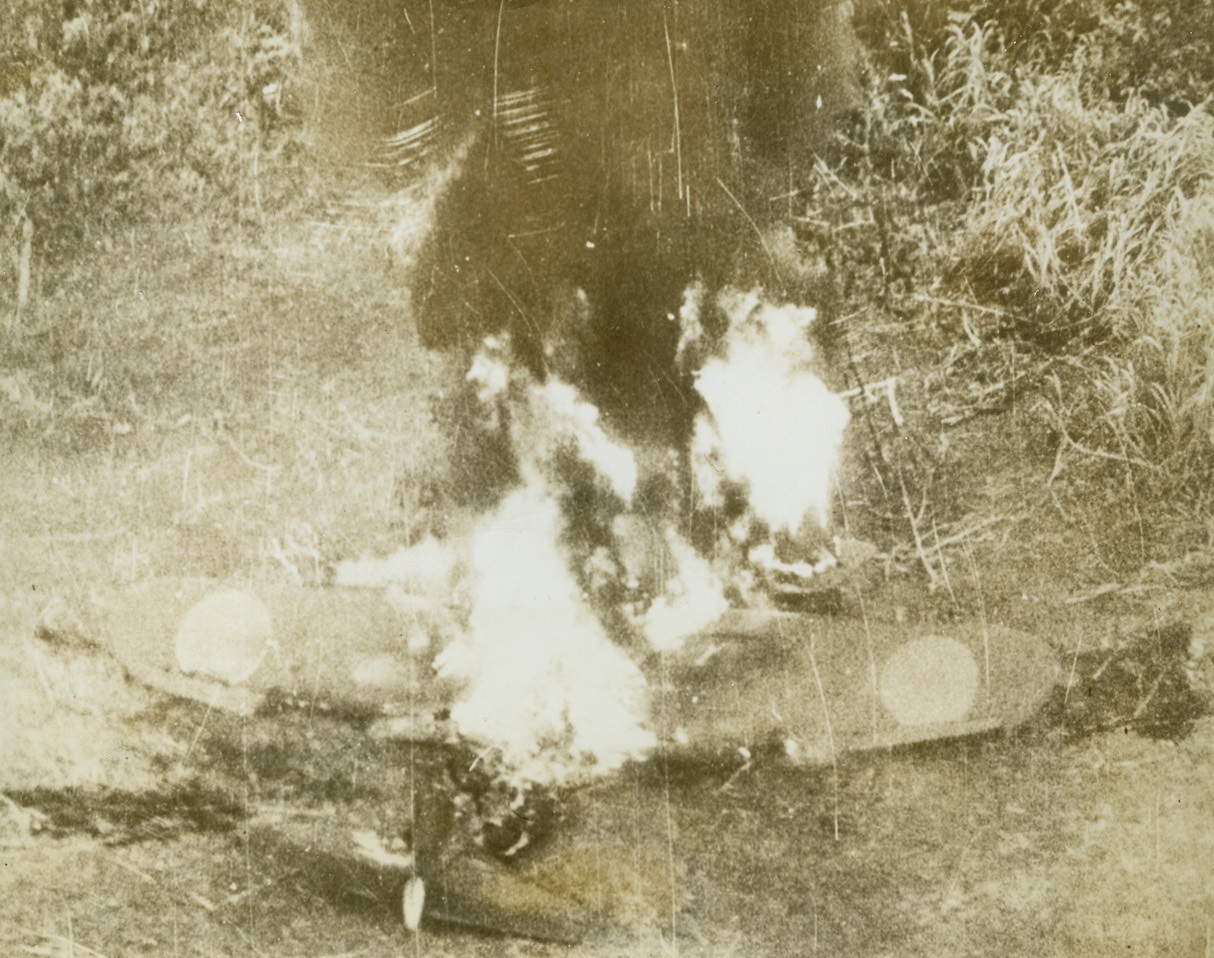
“SCRATCH ONE ZERO!”, 3/23/1943. This photo, taken during the Battle of the Bismarck Sea, shows a Jap Zero plane, caught on the ground at Lae, New Guinea, by Allied bombers, as it burns fiercely. Picture was taken from a RAAF plane flying close to the ground. In the battle, the Allies wiped out a convoy of 22 Japanese ships. Credit: U.S. Army Air Forces photo from Acme;
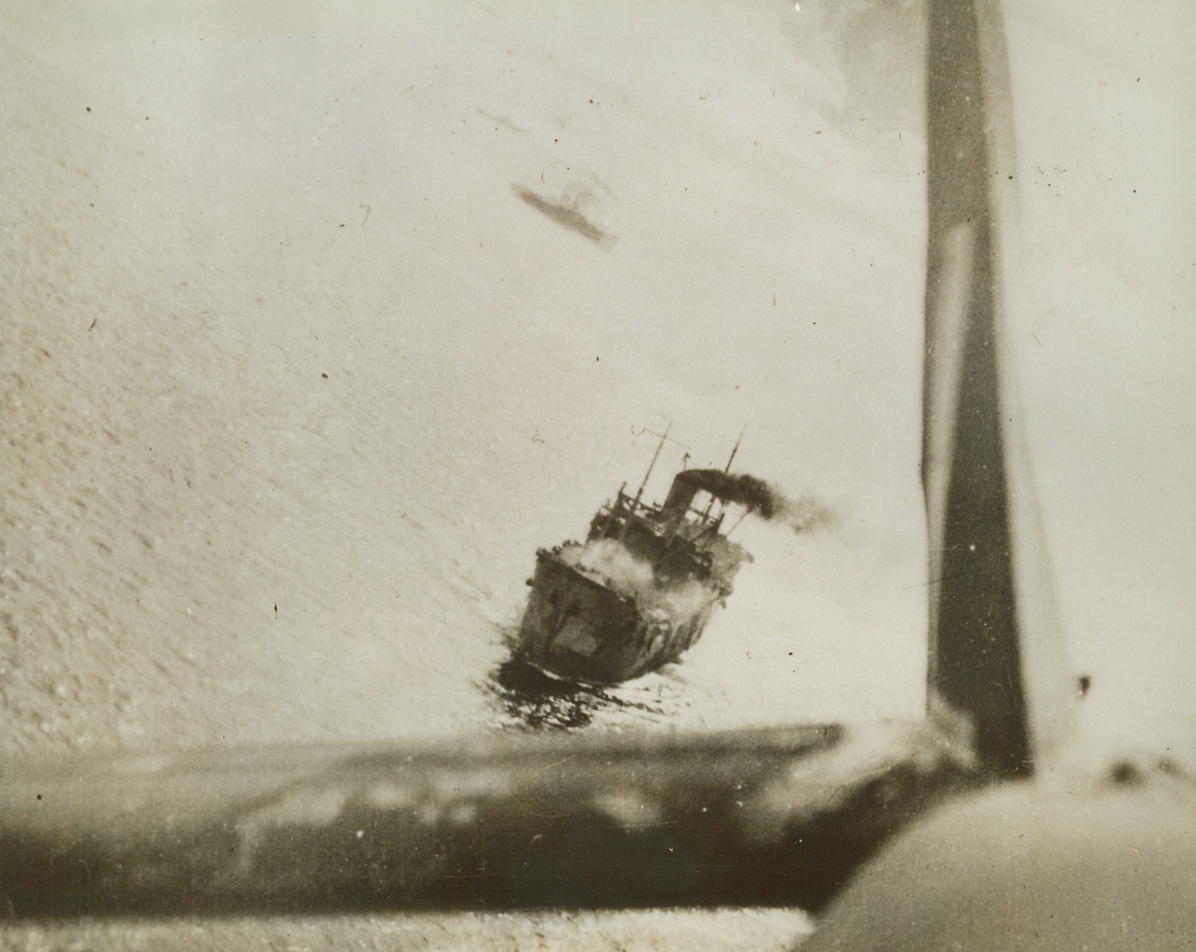
You’re Looking at a Strafed Jap Ship, 3/20/1943. “Somewhere in the Bismarck Sea” in the South Pacific war zone, this photo was made of a 10,000-ton Jap transport vessel that had just been strafed during the recent naval-air battle in which a 22-ship enemy convoy was wiped out. The tail of the long-range fighter plane which did the strafing is shown in the picture. Other ships in the Jap convoy can be seen in the distance. Credit: Official Royal Australian Air Force photo from ACME;
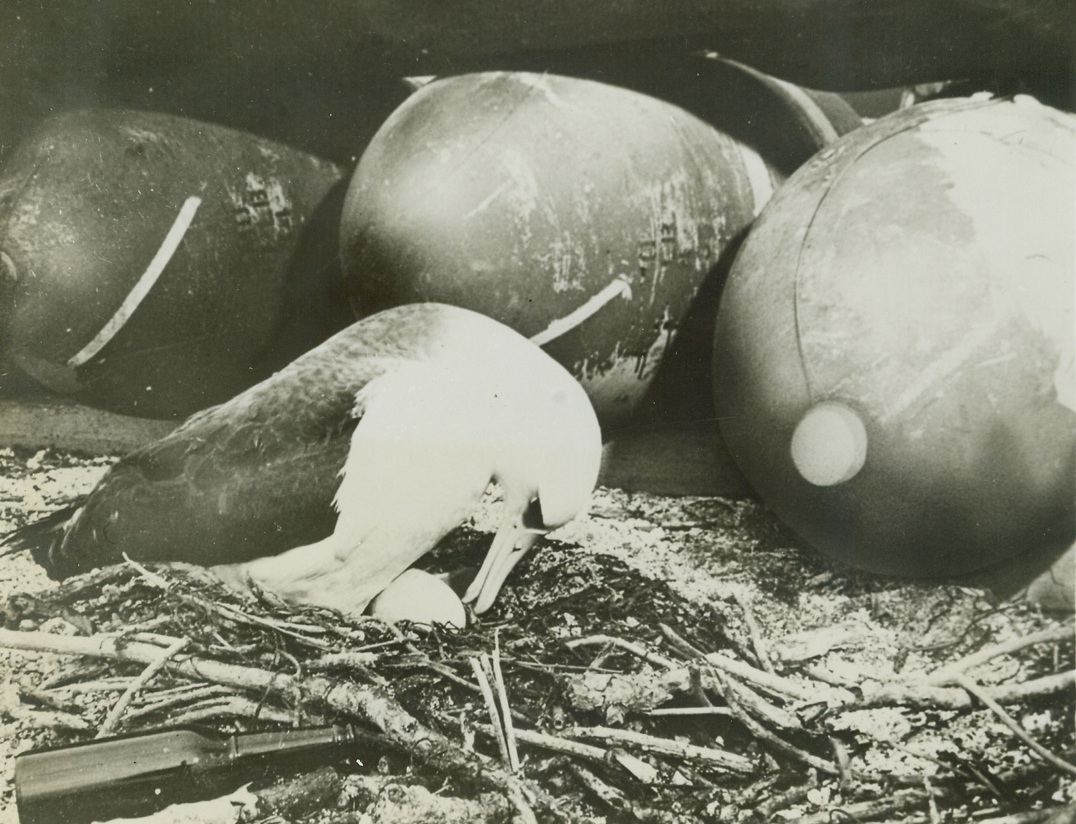
CONTRAST IN EGGS, 3/1/1943. SOMEWHERE IN THE MID-PACIFIC—A goonie bird, nesting in the shelter of a row of bombs, looks down to compare the size of its egg with those big “eggs”, destined to blast at Jap positions somewhere in the Pacific. Unaware, the bird proves again that “ignorance is bliss.” Credit: ARMY AIR FORCE PHOTO FROM ACME.;
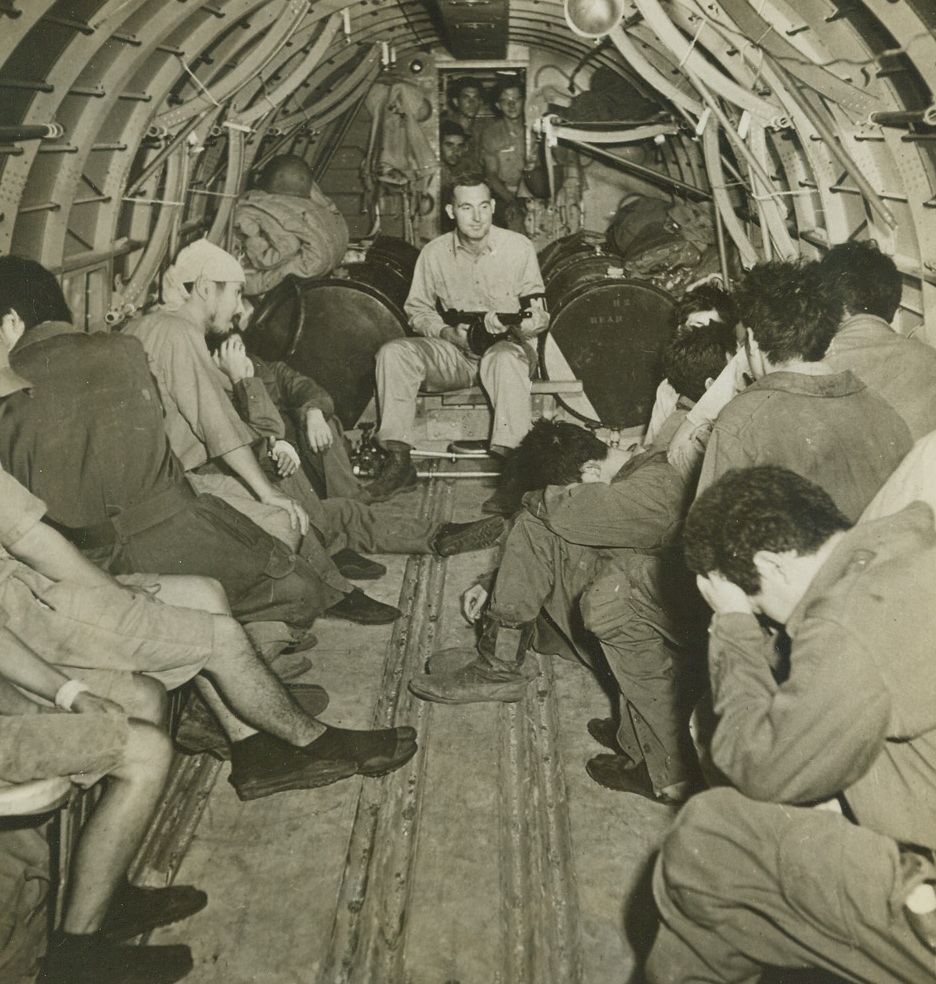
LAMENTING THEIR FATE, 3/7/1943. SOUTH PACIFIC—Japanese airmen and sailors bow their heads as they seem to lament their fate of being prisoners of war. They were captured by the natives on one of the outer islands of the Solomon group and were brought to Guadalcanal by plane, motor torpedo boat and landing boat. From there they were flown to USA headquarters in the South Pacific. Credit: ACME.;
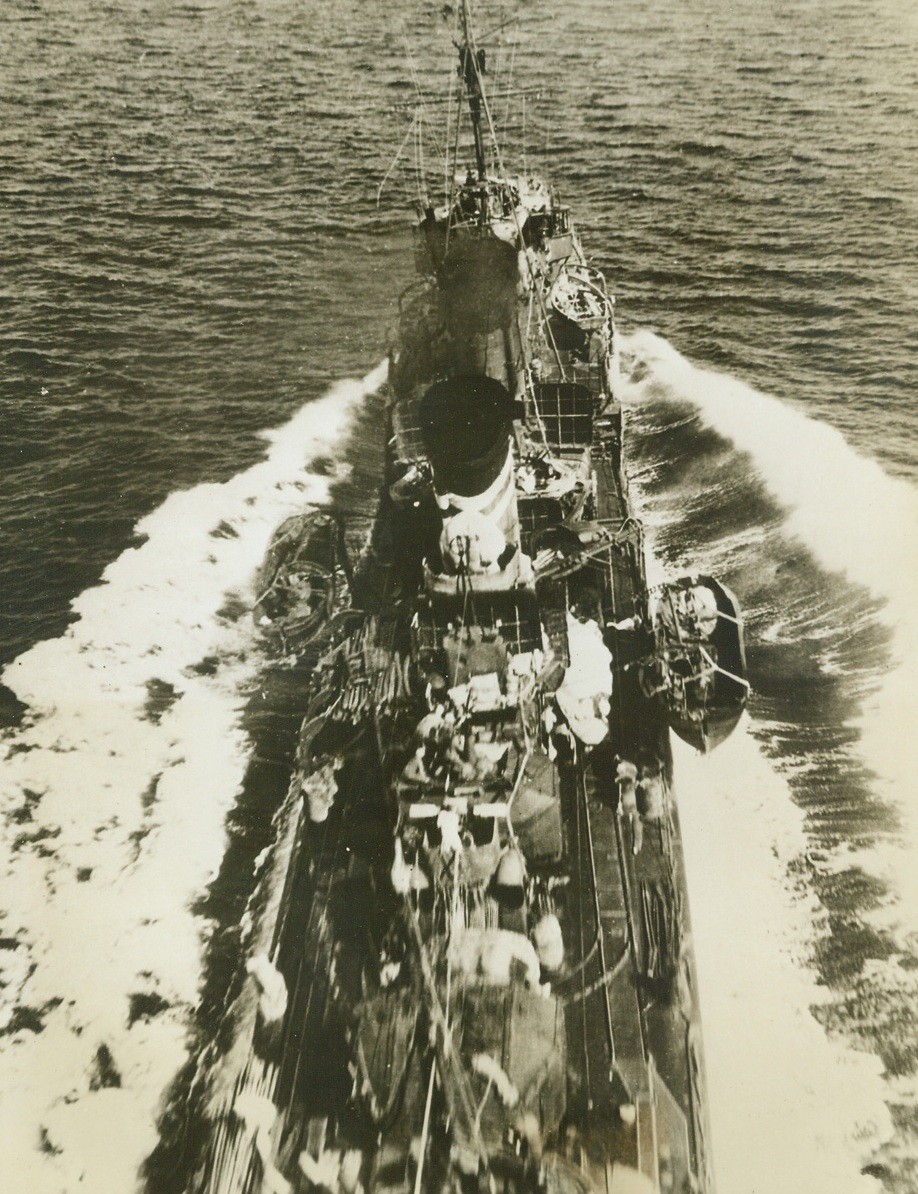
One Way to Get a Jap Destroyer! 3/23/1943. The Allied plane from which this remarkable photo was taken made sure of scoring a “kill” on this Jap destroyer, during the Battle of the Bismarck Sea, by almost scraping the warships smokestacks as it dropped its lethal load. A short time later, the Jap vessel kept a date with “Davy Jones.” Note crew scurrying for cover from the plane they must have thought was going to crash on top of them. Also note logs on the vessel’s decks, which were meant for an invasion attempt that never materialized. The destroyer was one ship of a Jap convoy of 22 vessels completely wiped out in the battle. Credit: U.S. ARMY AIR FORCES PHOTO FROM ACME.;
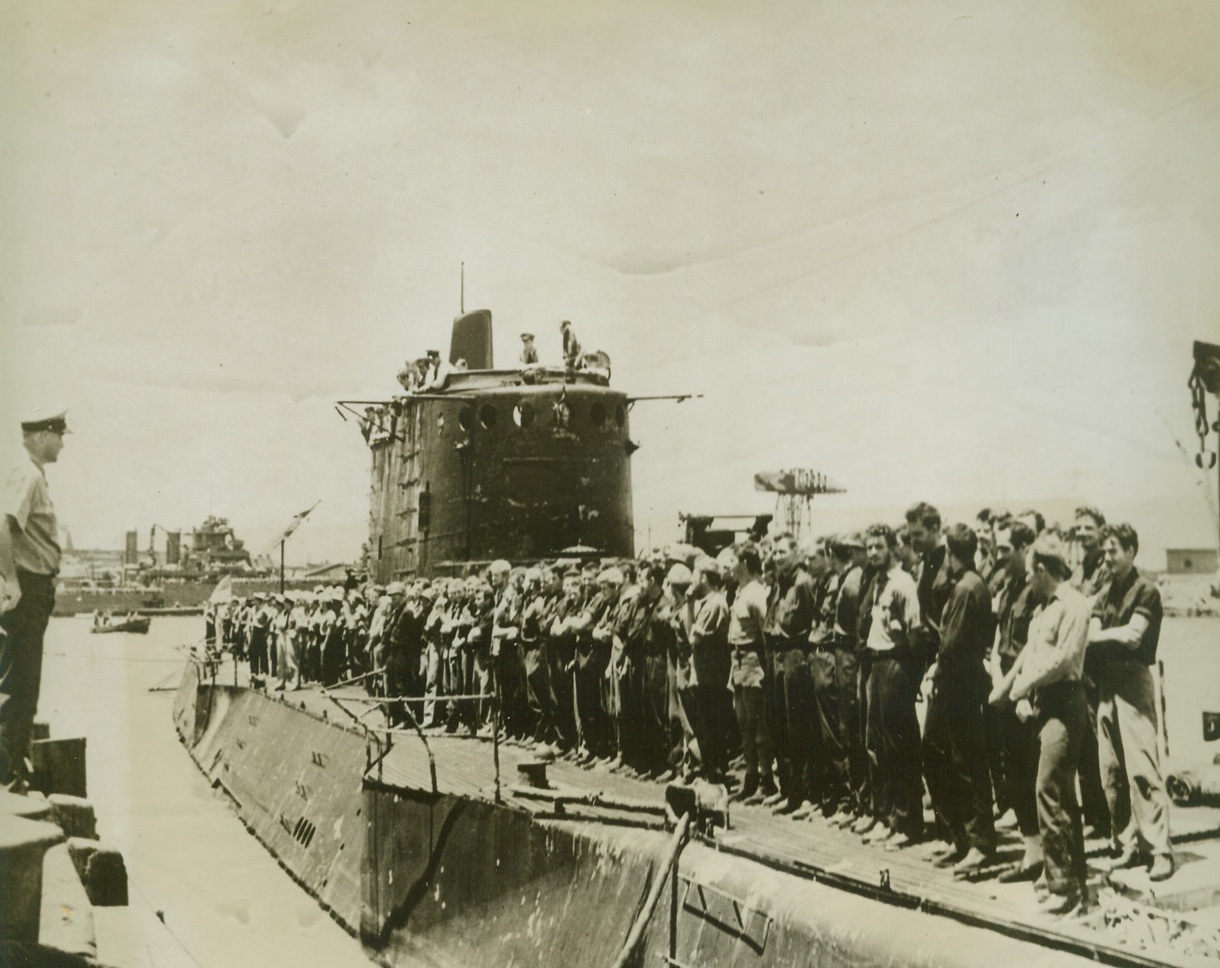
HEROES RETURN, 3/15/1943. This photo, released in Washington today, shows Marine raiders lining the deck of the U.S. submarine from which they conducted their surprise raid on Makin Island last August 17-18, as the ship pulled into Pearl Harbor. Submarine officers who took part in the successful attack, are shown looking down from the conning tower as they came into the harbor to receive the “well done” accolade from their commander-in-chief in the Pacific, Admiral Chester W. Nimitz. Credit: U.S. NAVY PHOTO FROM ACME.;
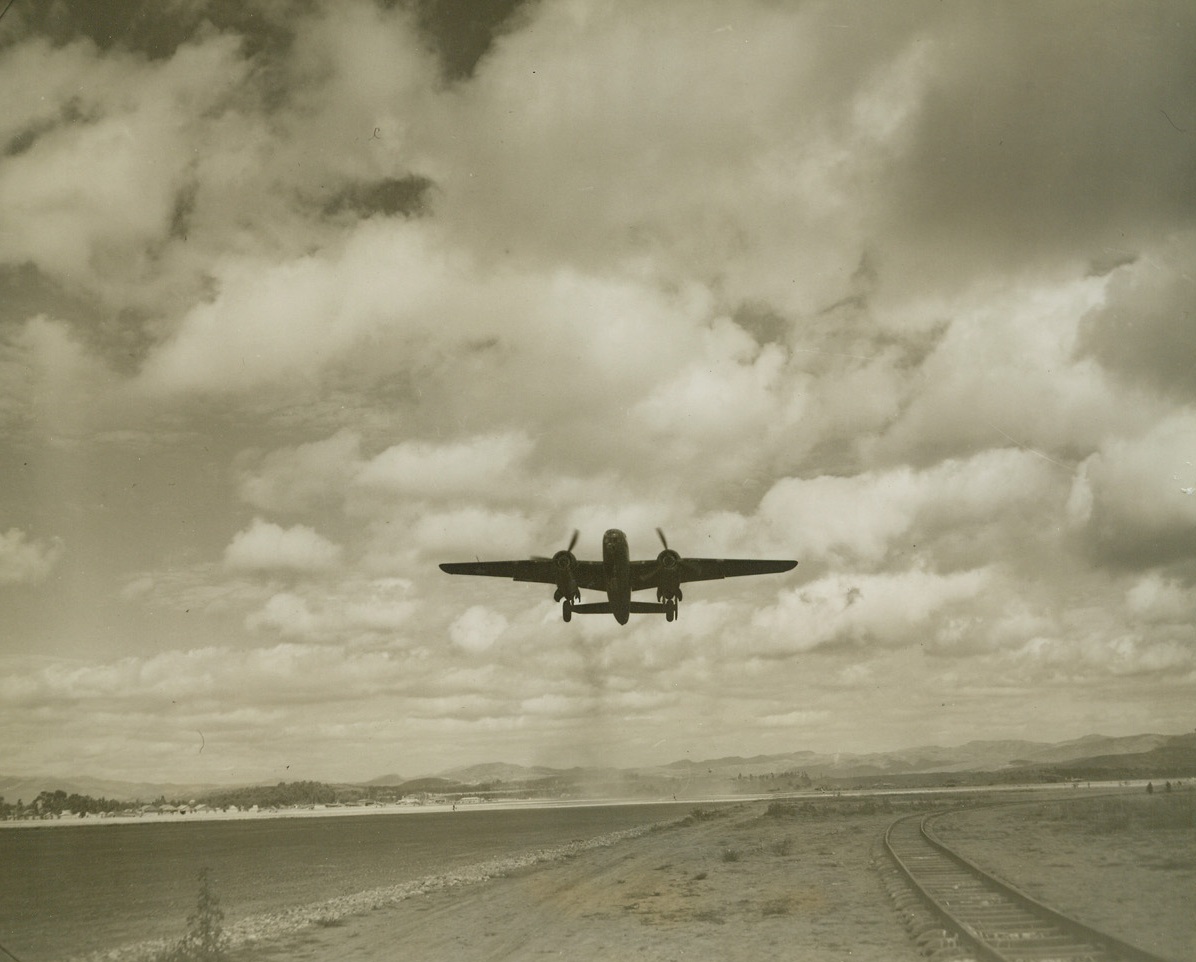
OFF ON A BOMBING MISSION, 3/14/1943. SOMEWHERE IN CHINA—A powerful B-25 leaves clouds of dust behind as it takes off on a bombing mission in the China Air Task Force. The bombers in the task force drop their “eggs” over Burma and occupied cities in China. Credit: ACME.;
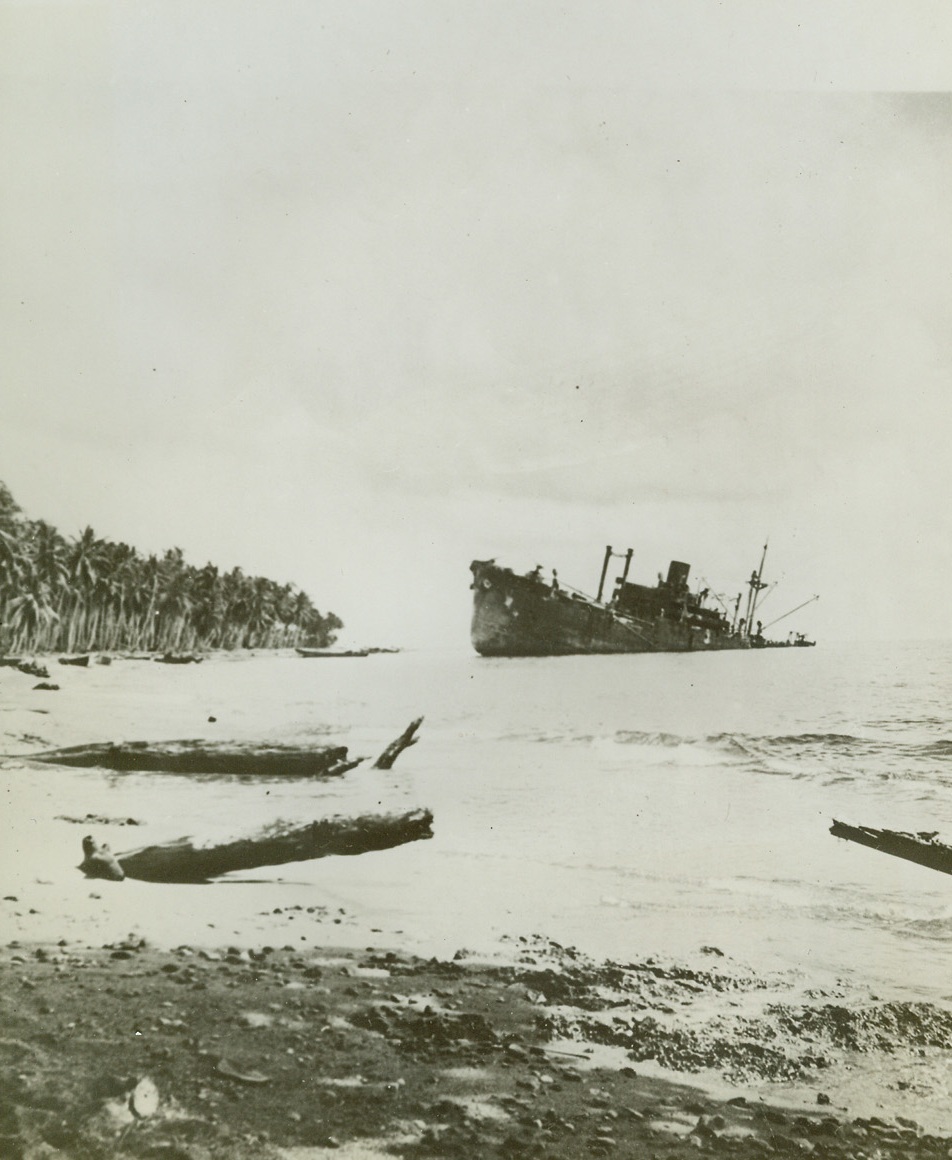
BLASTED AND BEACHED,3/7/1943. GUADALCANAL, S.I.—Blasted by American forces in the Solomon Island battles of November 13 and 14, 1942, the Jap ship, Kinugawa Maru, lies useless and deserted off Guadalcanal. Half of the beached vessel is almost submerged beneath the waters of the Pacific. Credit: ACME.;
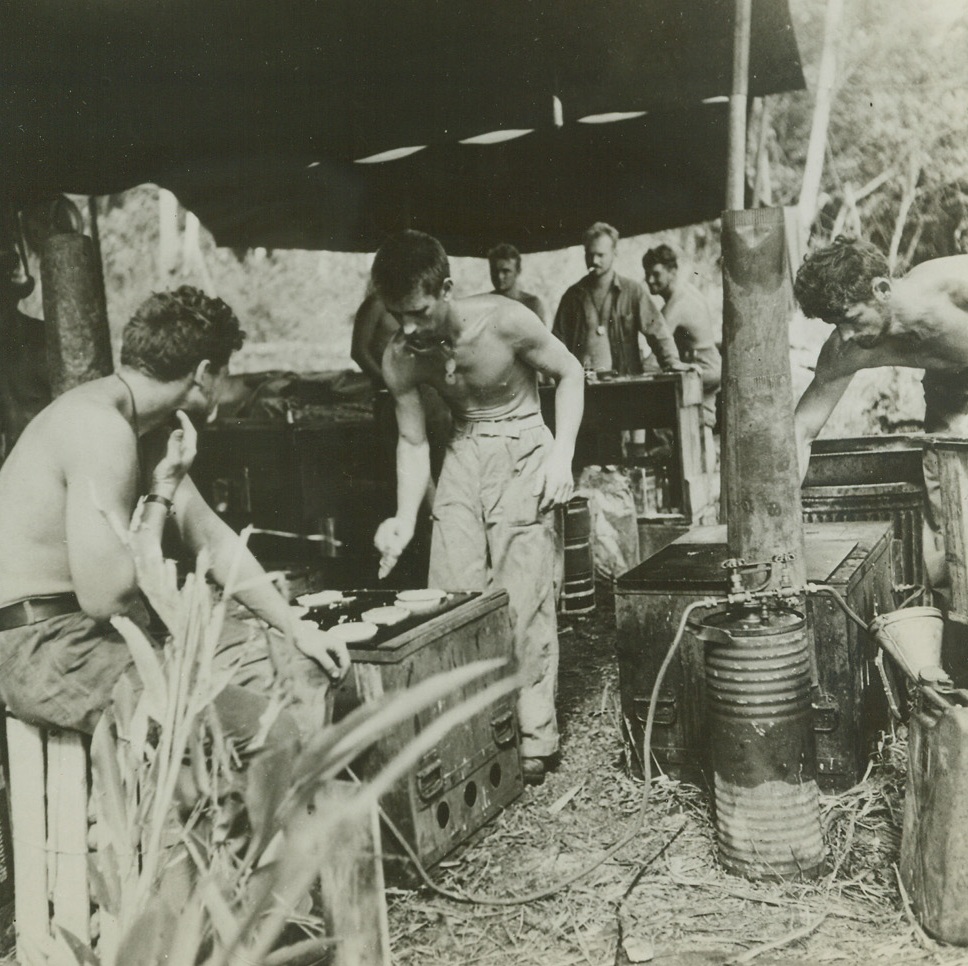
FLAPJACKS FOR A MAN-SIZED APPETITE, 3/7/1943. GUADALCANAL—During the fierce fighting months when the Americans were showing the Japs our new “get them out of here in a hurry” maneuver, the boys on the front lines didn’t have the time to stop and cook. However, they had the situation well in hand as shown in this photo of American cooks making the old American standby—flapjacks, to be sent in hot containers to the front line troops. Credit: ACME;
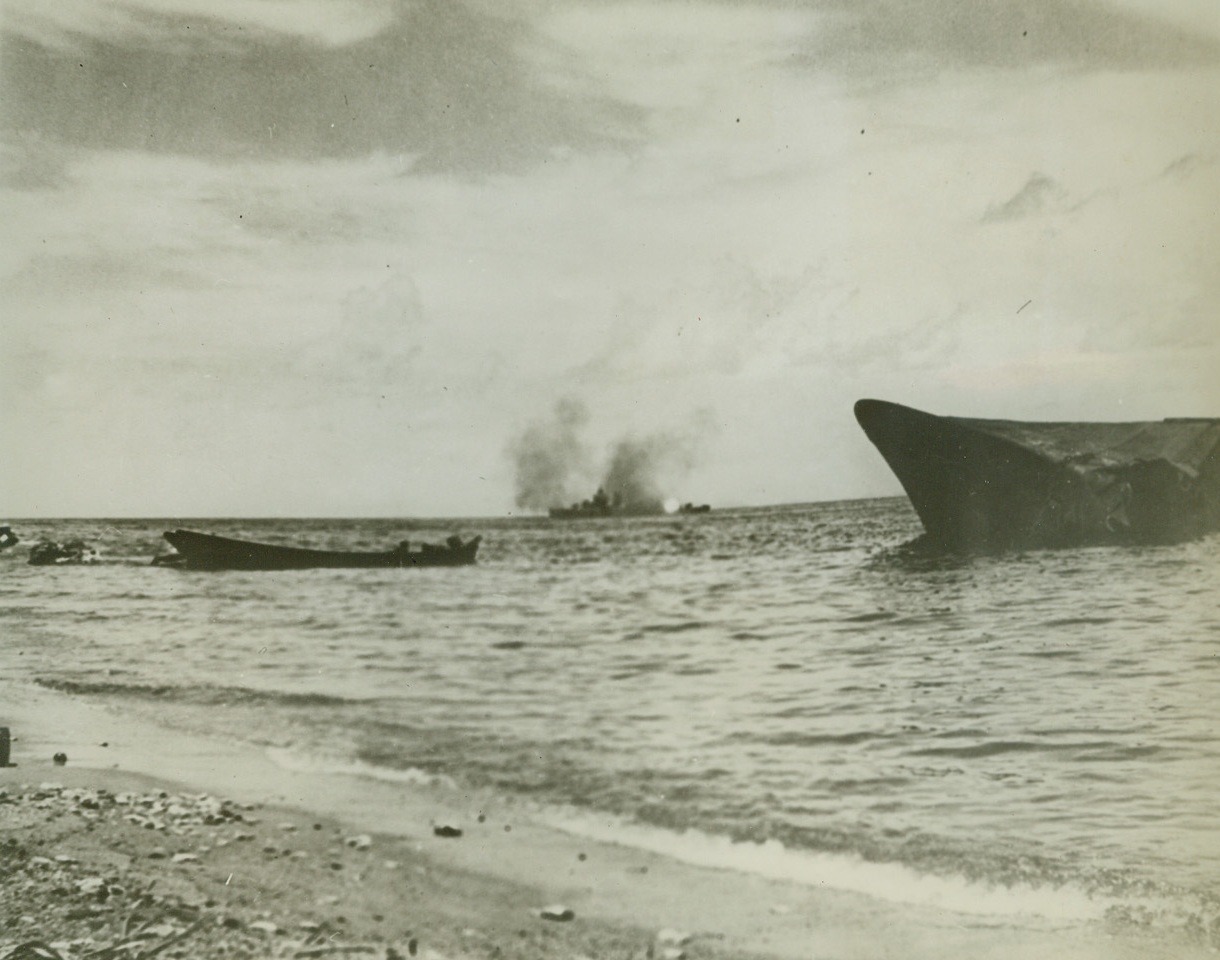
“SEA SHELLS” DUMPED IN LAPS OF JAPS, 3/8/1943. GUADACANAL—From land, air and sea, destruction was rained on the Japs who were intent on holding their positions on this island until recently. During the battles of November 13-15, an American warship (center) is shown shelling Nip positions. The beached Japanese ship, Kinugawa Maru, is shown in the foreground after it was blasted by U.S. forces. Credit: ACME.;
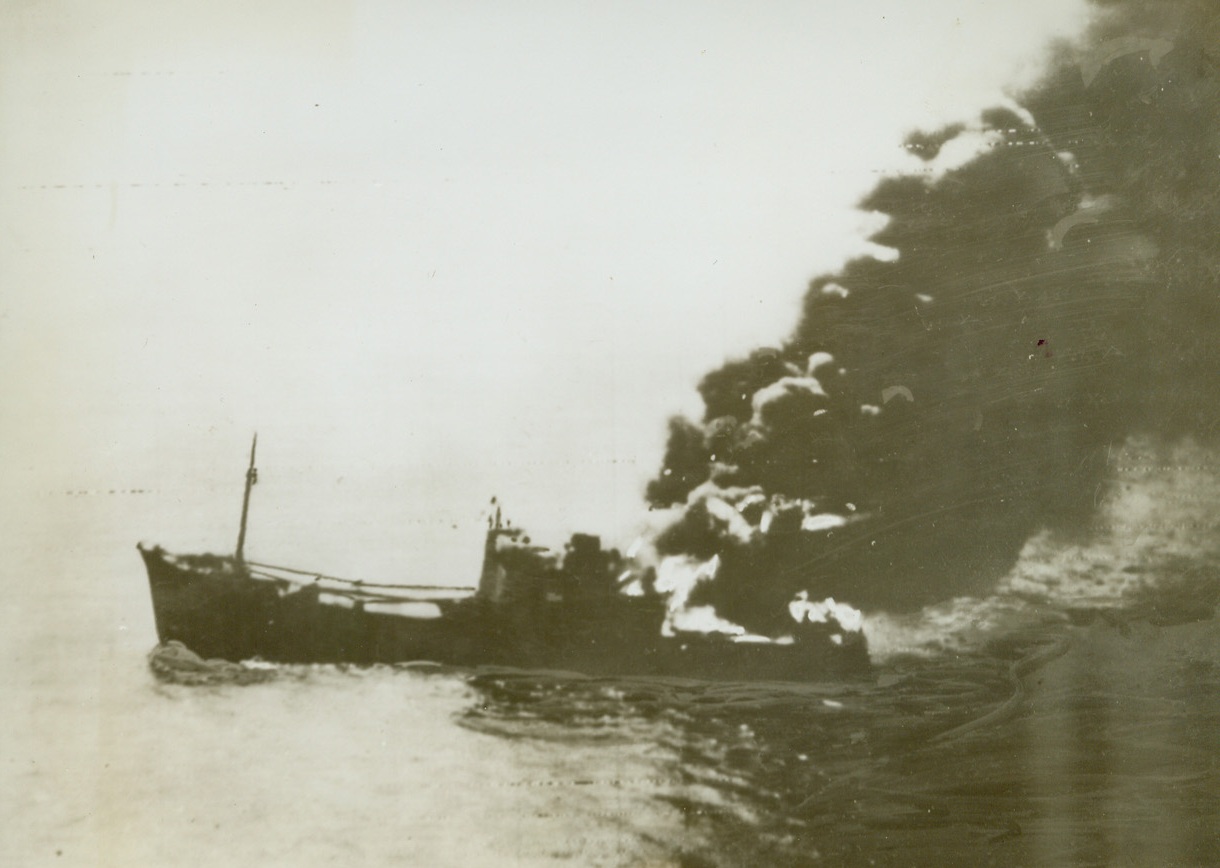
JOINING 21 OTHERS, 3/8/1943. In an official RAAF photo radioed from Melbourne, Australia, to San Francisco, one of the 22 Jap ships in a convoy wiped out in the Bismarck Sea goes up in flame and smoke after receiving hits from medium bombers. Credit: ACME.;
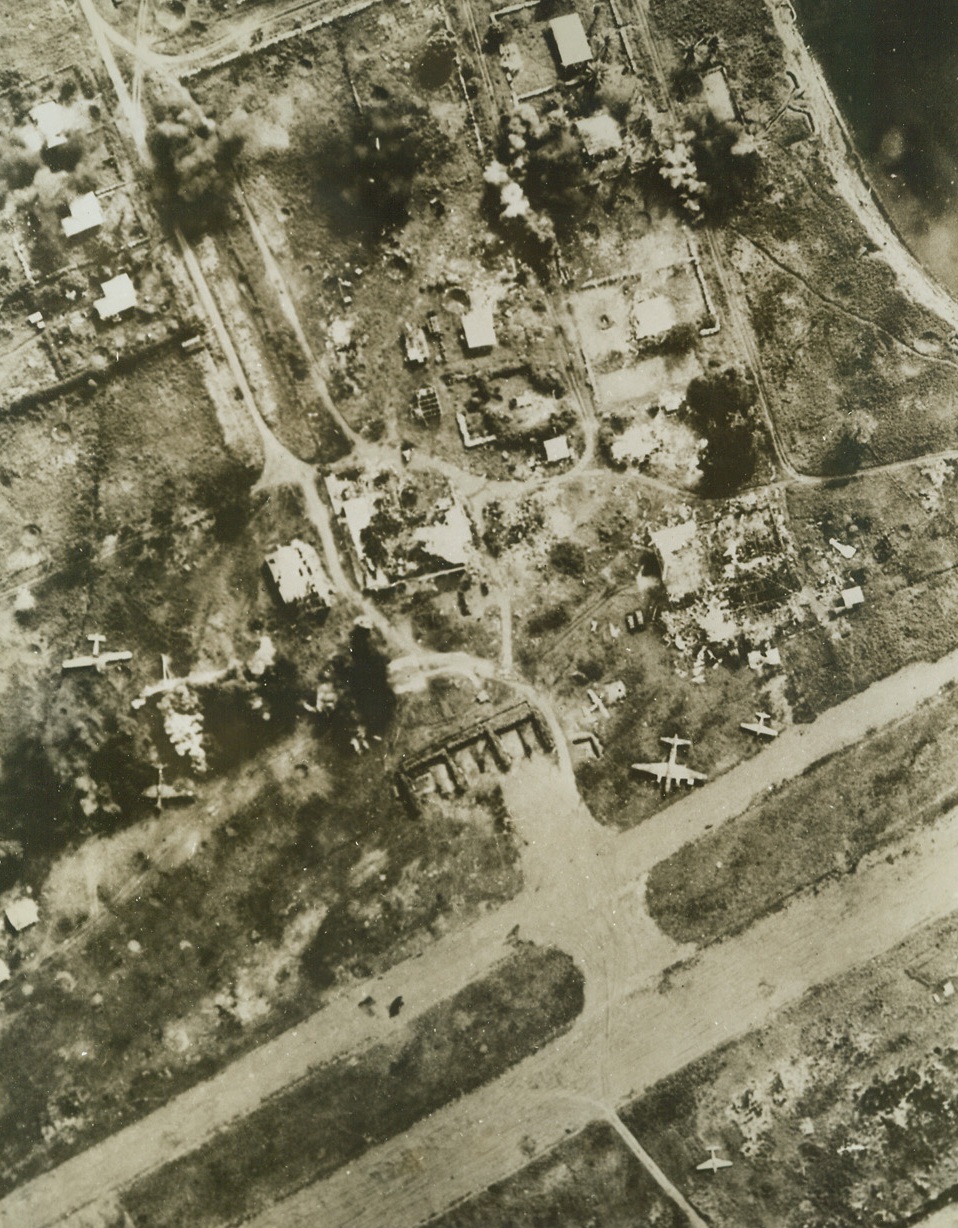
“DANGER! JAP-SMASHERS AT WORK!”, 3/8/1943. Japanese planes and installations on the airport at Lae, New Guinea, are shown being blasted to rubble in their photo taken from one of the squadron of raiding U.S. Army Air Force bombers, during a recent attack on the Nip base. In center, (photo above), can be seen roofless, burned out shells of buildings, while at lower left, American bombs make junk out of a group of Jap planes in the dispersal area. Other bomb bursts are marked by black smoke at top of photo. Credit: U.S. ARMY FORCES PHOTO FROM ACME.;
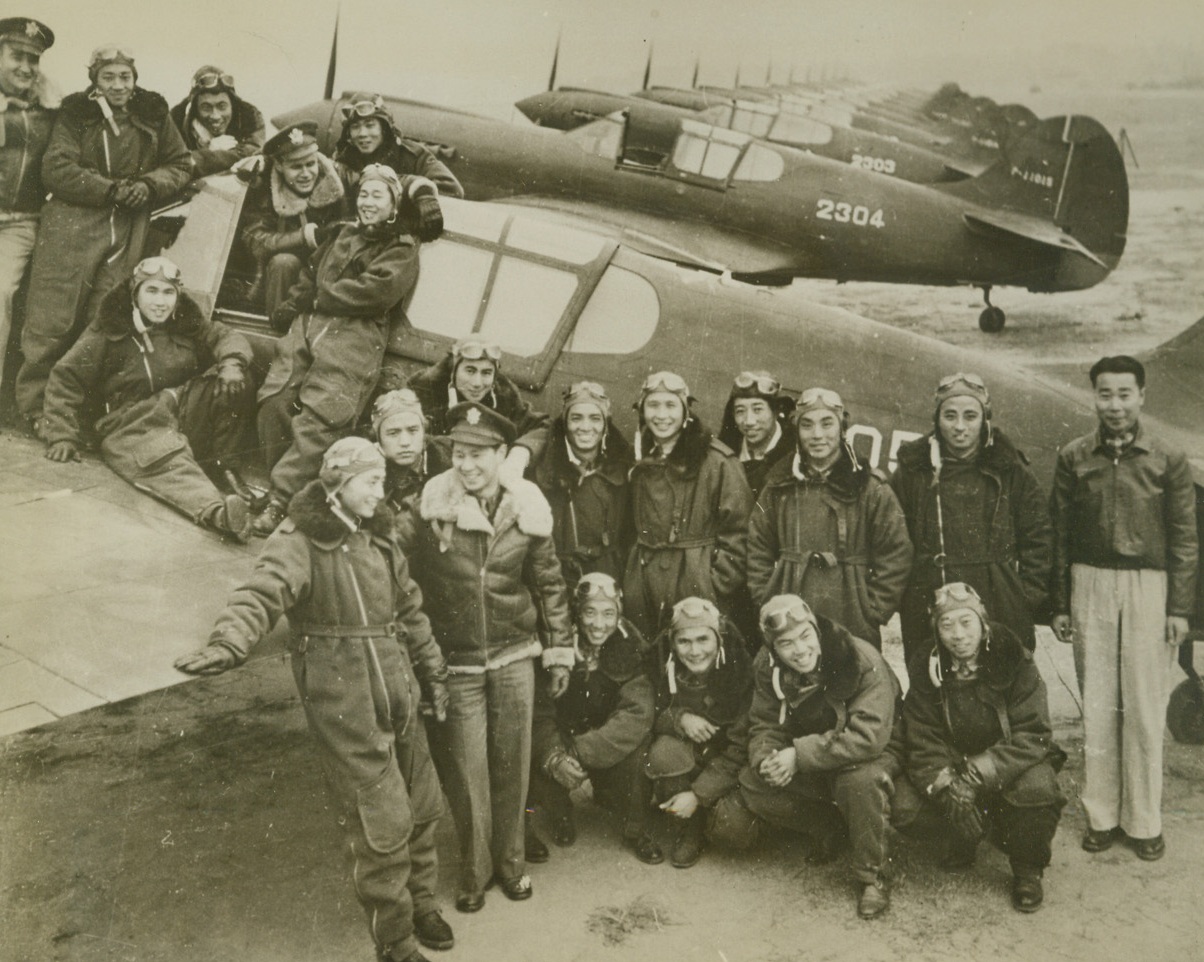
FIGHTERS FOR THE SKIES OF CHINA, 3/10/1943. CHENGTU, CHINA—This smiling group of Chinese fighter pilots don’t seem to be worried about the prospect of another brush with the Japs. As they pose near one of the a long line of their American-built pursuit planes, near Chengtu. They have all been trained in the U.S. and are veterans of many a dogfight with the Nips. In cockpit of ship, and standing at far left on wing, are two American fliers. Credit: ACME.;
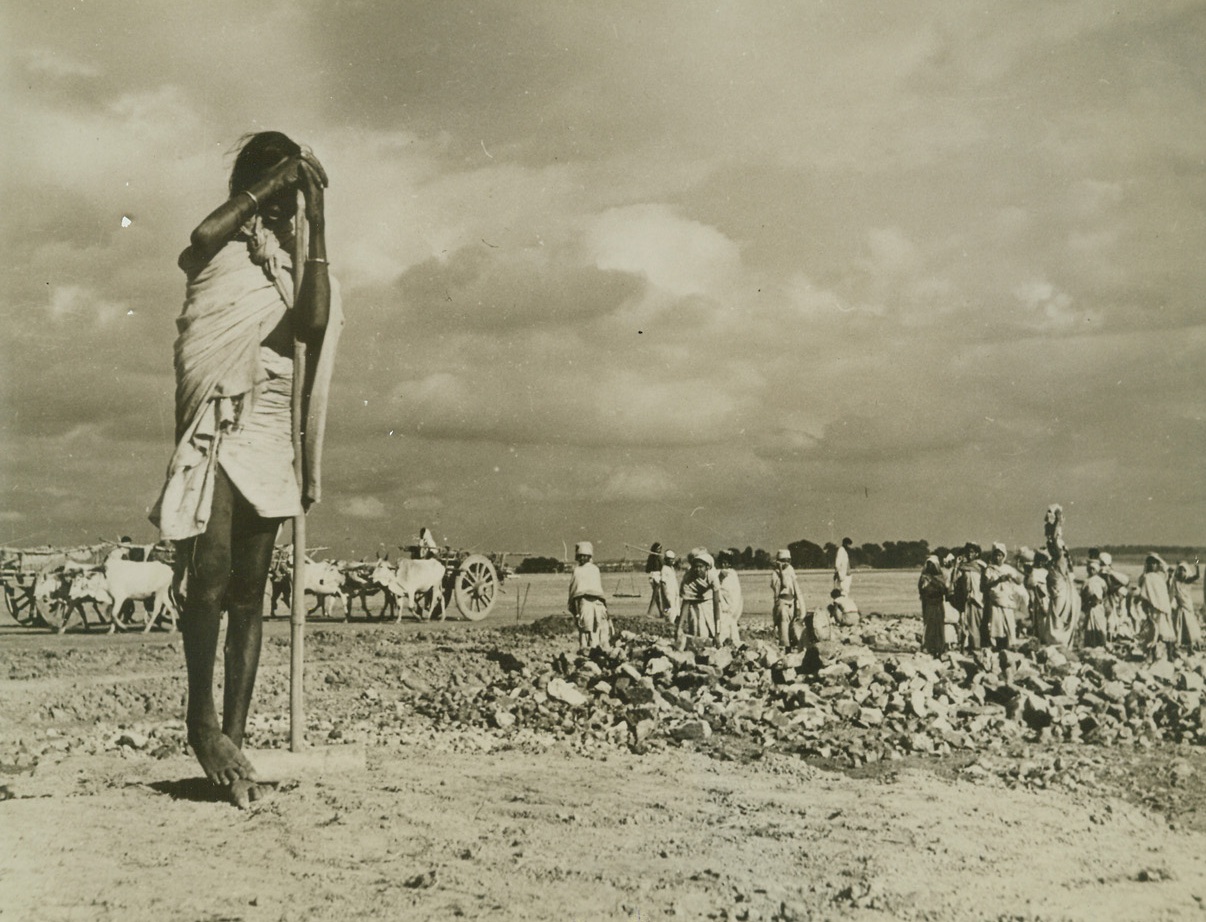
PRIMITIVE LABOR CREATES MODERN WAR TOOL, 3/9/1943. EASTERN INDIA—A young Indian girl rests on her crude work tool, as other native women balance broken stone on their heads and bullock carts and hand labor carry out their painstaking parts in creating a modern airfield in Eastern India for U.S. planes. The carting and leveling of broken stone is a picture out of an ancient world. Soon, modern fighter, bomber and transport planes will utilize the landing strip. Credit: ACME.;
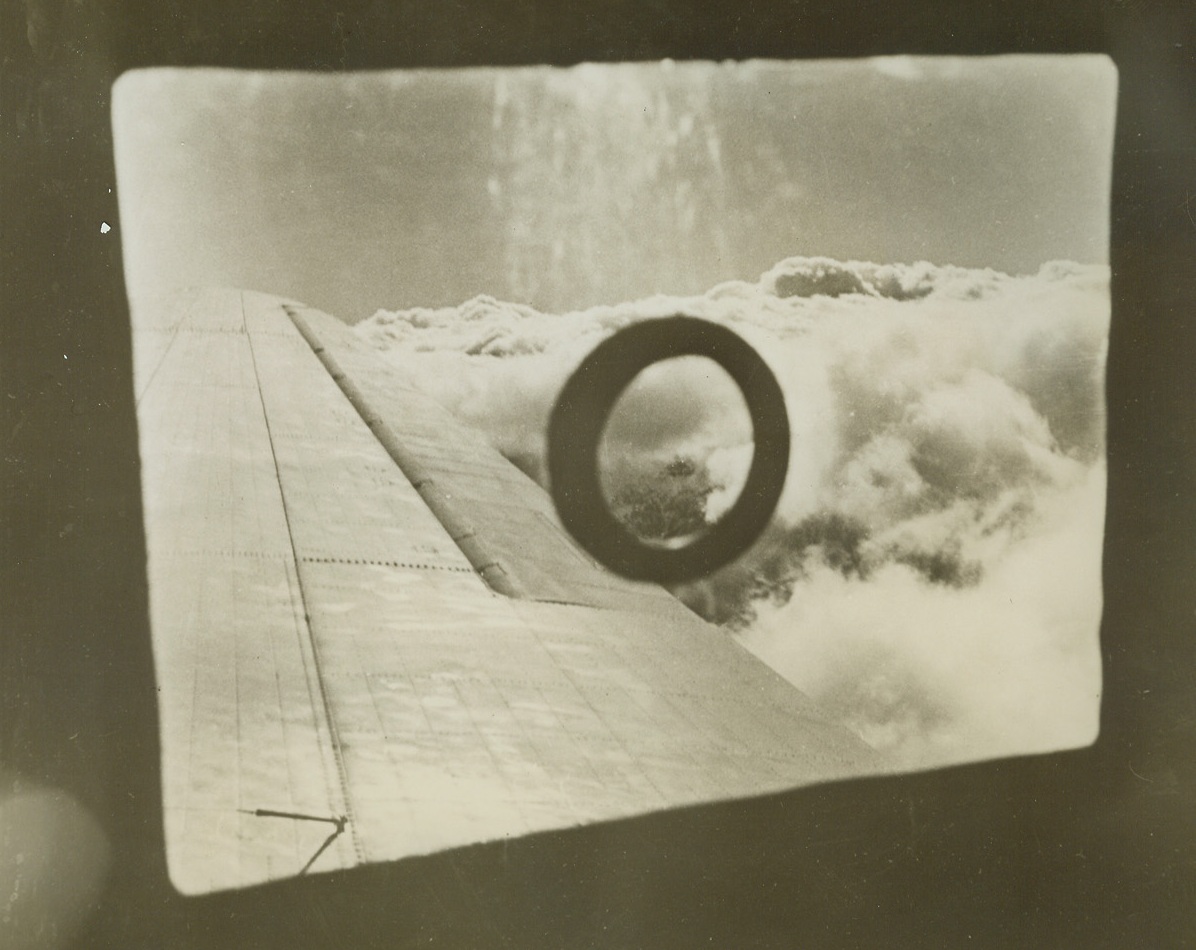
IN EVEN OF ATTACK-REMOVE PLUG, 3/9/1943. CHINA—The strange-looking plug in the window of a transport plane speeding over the Himalayas stops a hole that’s a perfect fit for a tommy gun. In the event of air attack on the aerial supply route between India and China, passengers and crew remove the plug and fill up the hole with a machine gun. This U.S. transport plane is flying high to avoid bad weather below. Credit: ACME.;
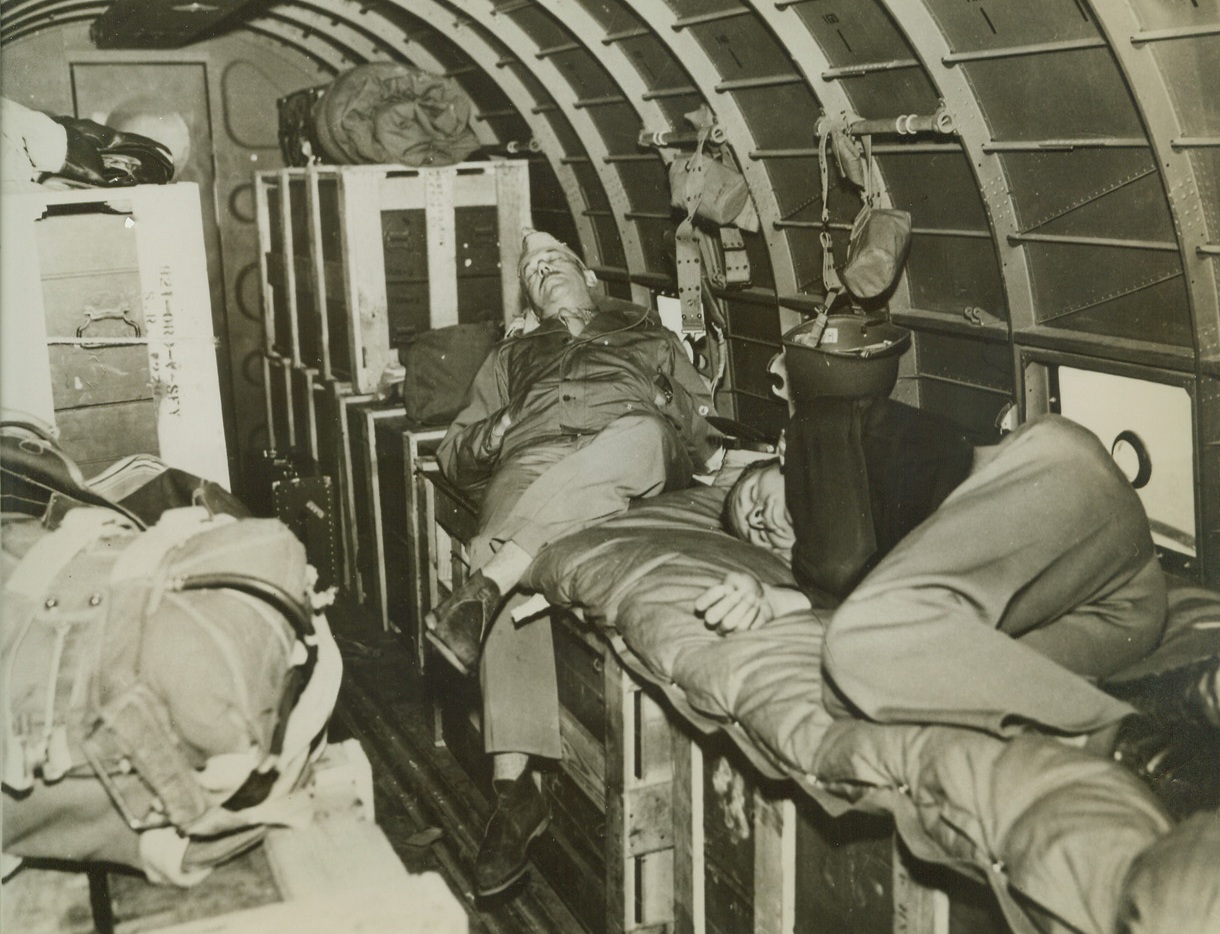
OXYGEN RATIONED OVER HIMALAYAS, 3/9/1943. EASTERN INDIA—Only the all-important crew is entitled to oxygen, so a U.S. Army major and colonel sleep as best they can atop rifle cases in a transport plane speeding over the Himalayas toward China at an altitude of 18,000 feet. “Deadheaders,” as passengers are called, shift for themselves when aboard a flying freight car that links India and China by airways that cut through rarified atmosphere. Credit: ACME;
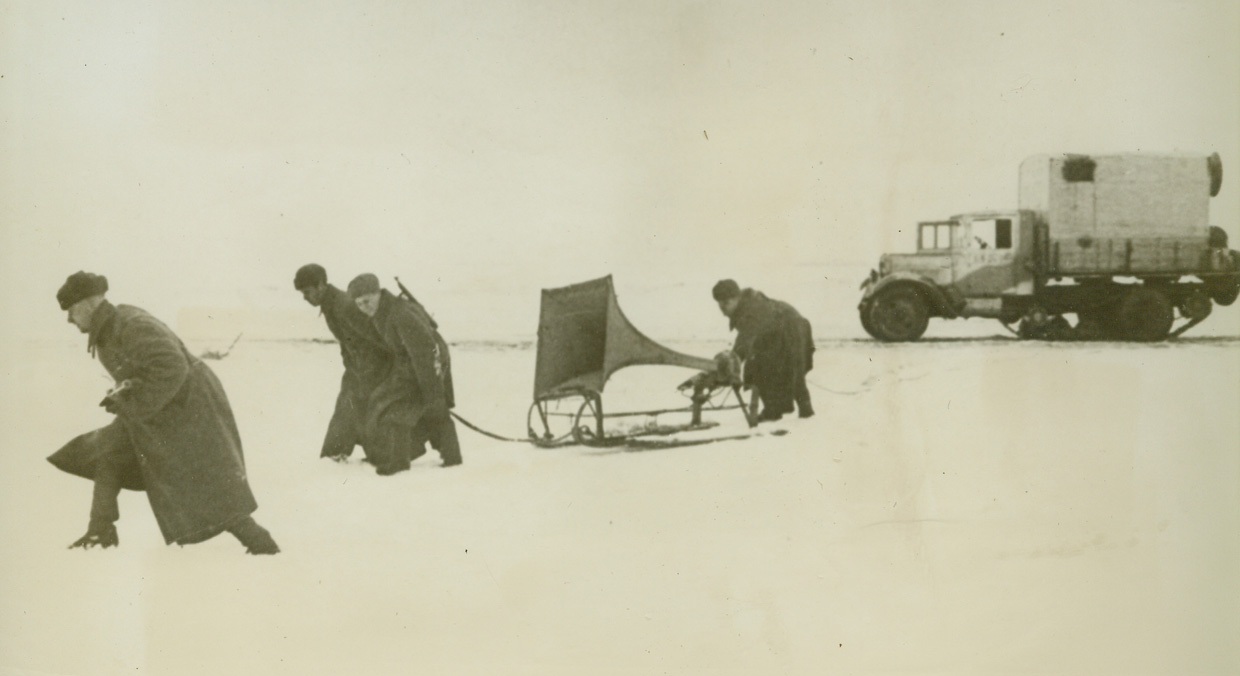
A Word to the Wise—, 3/2/1943. NORTH RUSSIAN FRONT—Red Army men drag a large loudspeaker mounted on runners into position for a “verbal” attack on Nazi outposts along the Northern front. Using powerful amplifiers, the Russians keep the Germans informed of the progress of the fighting in Russia—recently all in favor of the Red. Passed by censors.Credit: ACME;
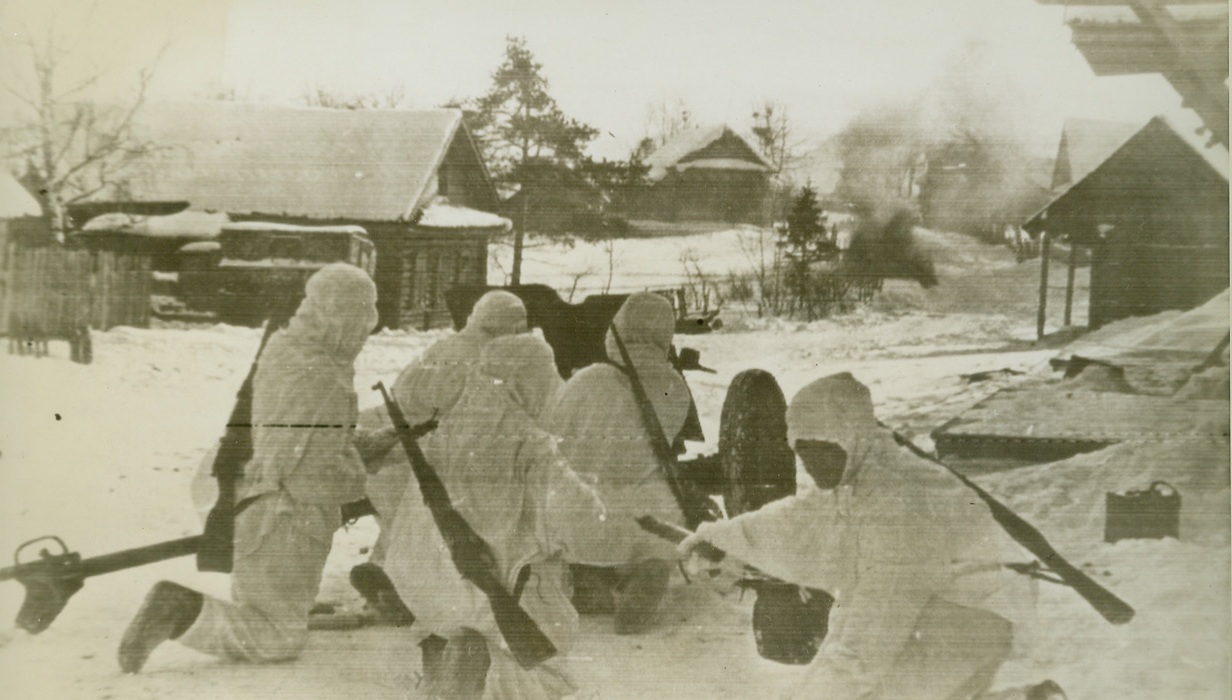
Red Anti-Tank Crew Moves Up, 3/10/1943. RUSSIAN FRONT—A Russian anti-tank crew moves forward to a new position on a snow-covered section of the front. Smoke from a bursting shell can be seen (right background). These anti-tank guns have been key weapons in the recent successful offensive by Red forces against the Germans. Passed by censors.Credit: ACME Radiophoto;
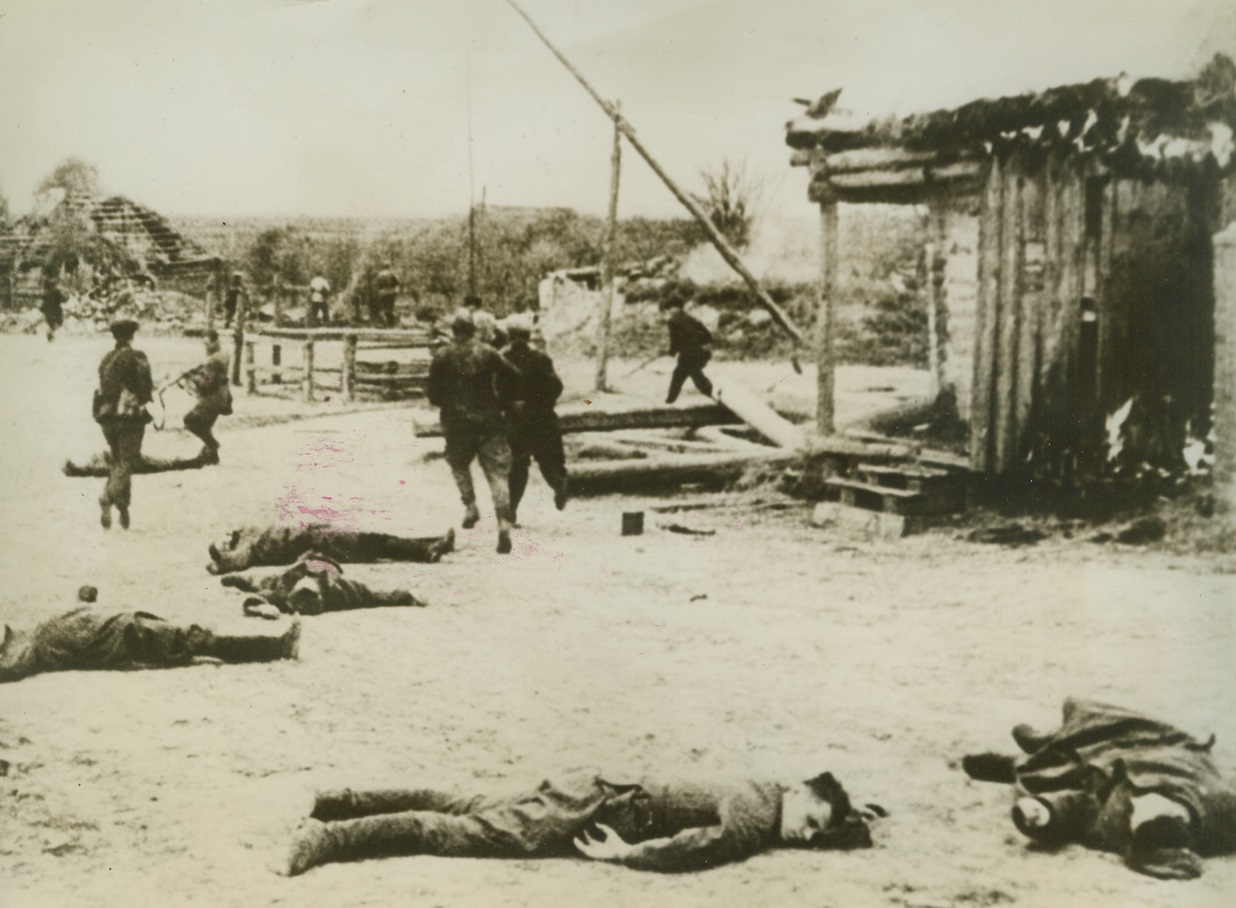
Dead Men Litter the Streets, 3/5/1943. Flash from “one day of war”. This photo is from the march of time’s “One Day of War”, a documentary film of one day on the far-flung Russian front, recorded by soldier-photographers of the Red Army. Of the 160 photographers assigned to the job, thirty were dead before the day ended. Photo shows: Side-stepping dead Germans and Hungarians, whose bodies litter the street of a Russian village, Soviet guerillas pursue the fleeing foe through the town. Credit line (March of Time “One Day of War” photo from ACME);
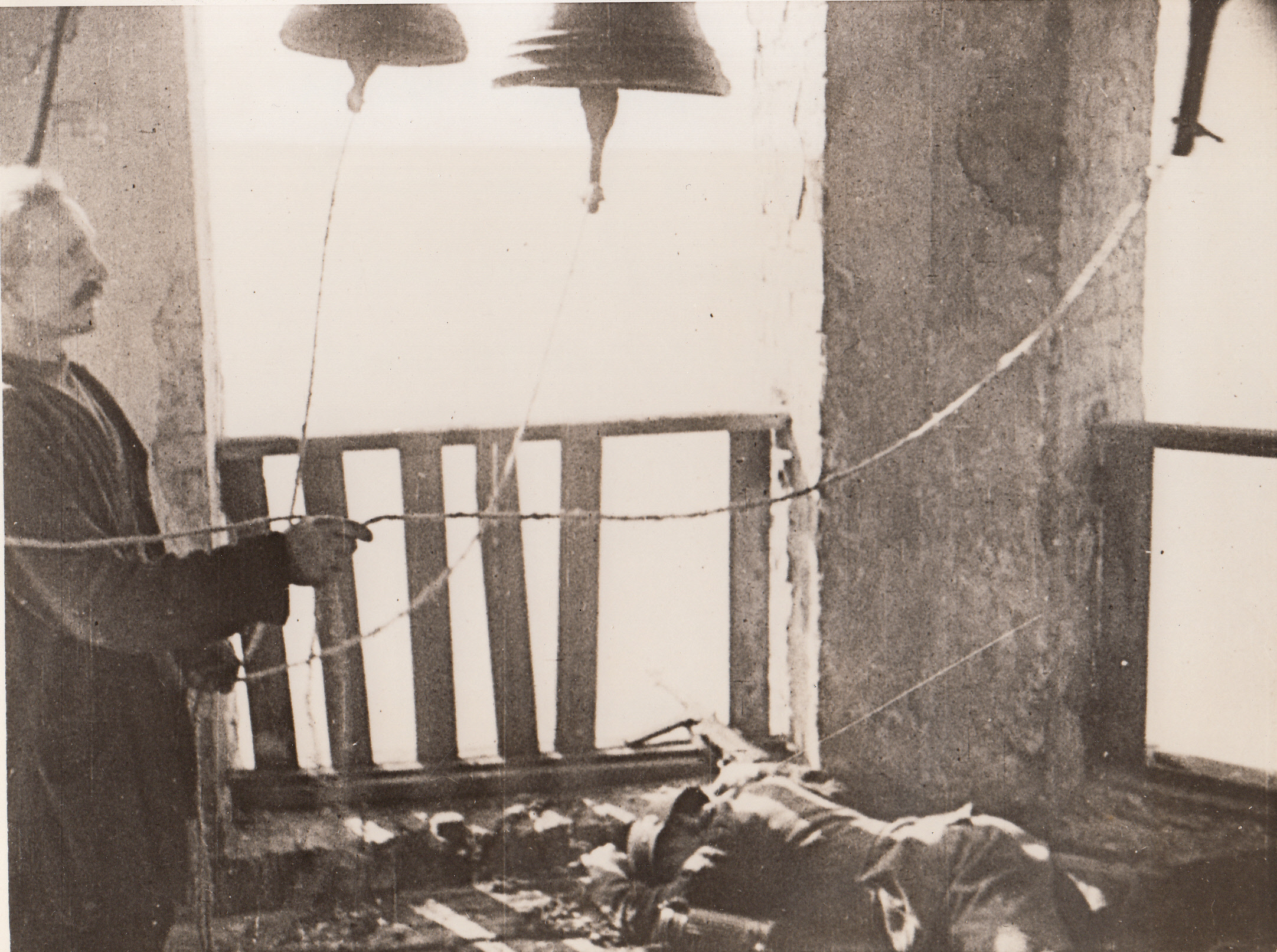
For Whom the Bell Tolls, 3/5/1943. Flash from “one day of war”. This photo is from the march of time’s “One Day of War”, a documentary film of one day on the far-flung Russian front, recorded by soldier-photographers of the Red Army. Of the 160 photographers assigned to the job, thirty were dead before the day ended. Photo shows: Ringing a joyous victory tune from a belfry in a recaptured Russian village, this bell-ringer also sounds the death knell for beaten Nazi troops. The bells resound mightily above the body of a dead German machine gunner who lies on the floor of the former German machine gun nest.;
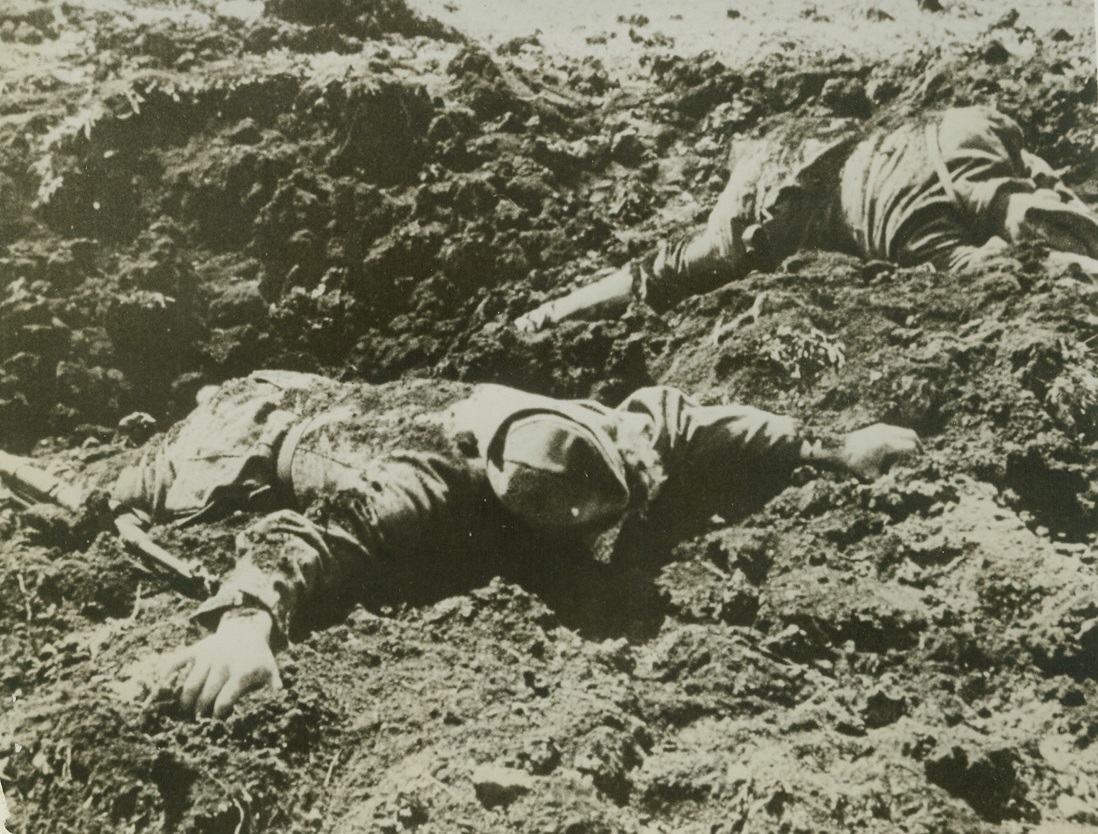
They Lie Where They Fell, 3/5/1943. Flash from “one day of war”. This photo is from the march of time’s “One Day of War”, a documentary film of one day on the far-flung Russian front, recorded by soldier-photographers of the Red Army. Of the 160 photographers assigned to the job, thirty were dead before the day ended. Photo shows: Dead Germans lie, face down, on the churned-up earth, where they fell when Soviet artillery and machine gun fire mowed them down. Hundreds of thousands of Nazis littered the streets like this as the Russians pushed through Stalingrad, Rostov, Kharkov and Kursk. Credit line (March of Time “One Day of War” photo from ACME);
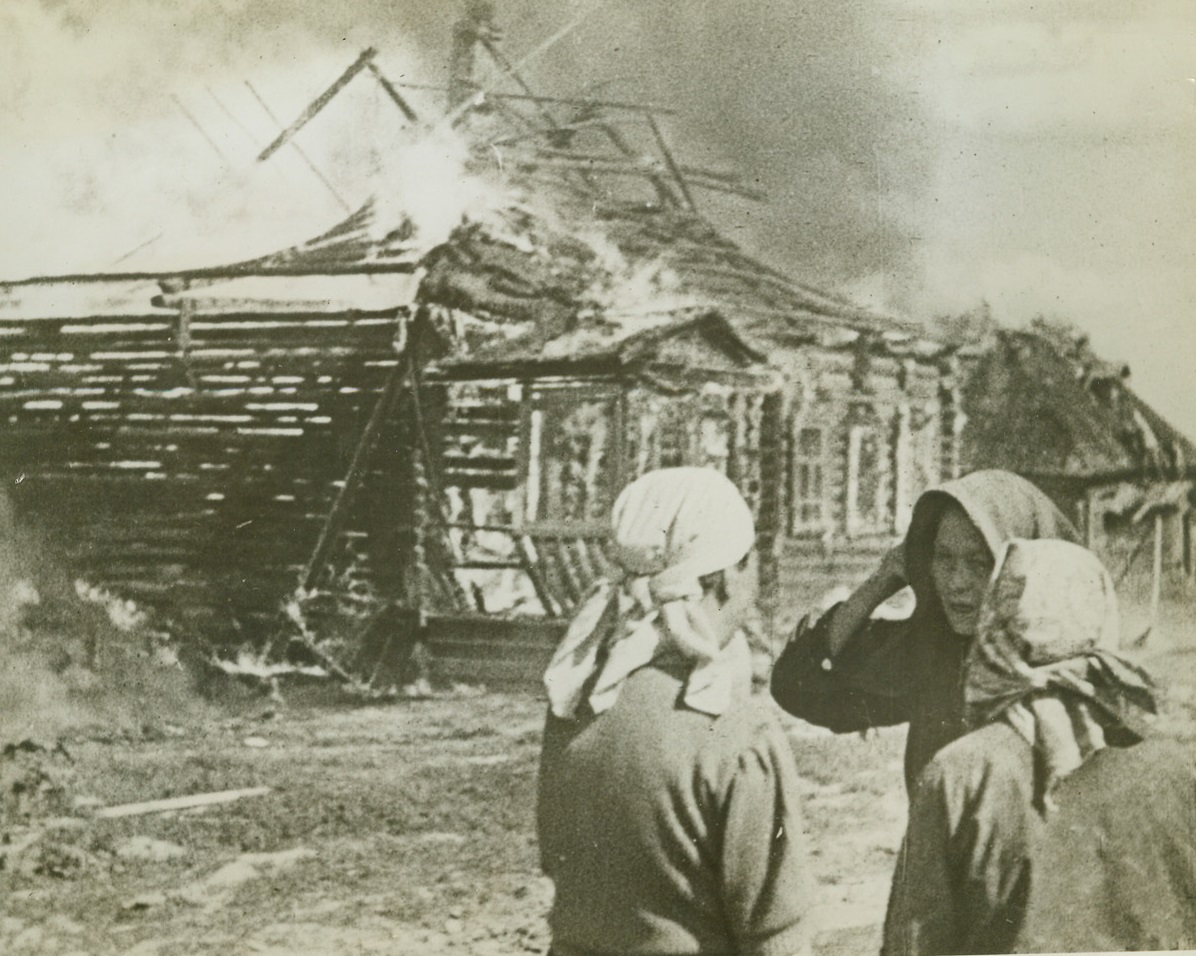
Their Homes Go Up in Flame, 3/5/1943. Flash from “one day of war”. This photo is from the march of time’s “One Day of War”, a documentary film of one day on the far-flung Russian front, recorded by soldier-photographers of the Red Army. Of the 160 photographers assigned to the job, thirty were dead before the day ended. Photo shows” Women stand helplessly by, and watch their homes go up in flame as Nazi troops flee their village in the face of a Red Army Advance. Spiteful Nazis put the torch to everything that would burn, leaving a flaming village to greet the attacking Reds. Credit line (March of Time’s “One Day of War” photo from ACME);
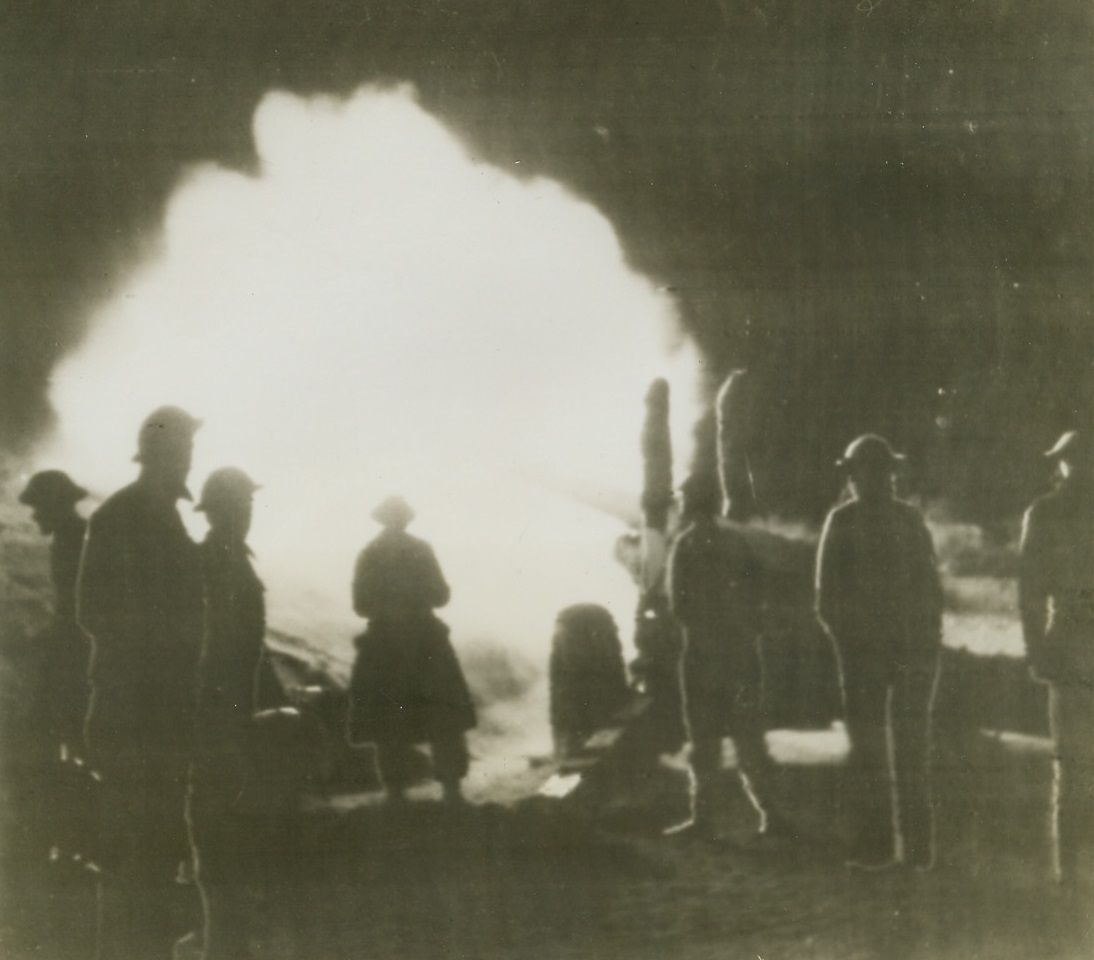
Bombarding the Mareth Line, 3/25/1943. Tunisia – This is the first photos showing action on the Mareth Line, where the British eight Army is blasting away at Rommel’s toughest defense. Photo shows British medium guns (4.5 inch) roaring in the night during a bombardment of the Mareth line. Credit line (ACME radio photo);
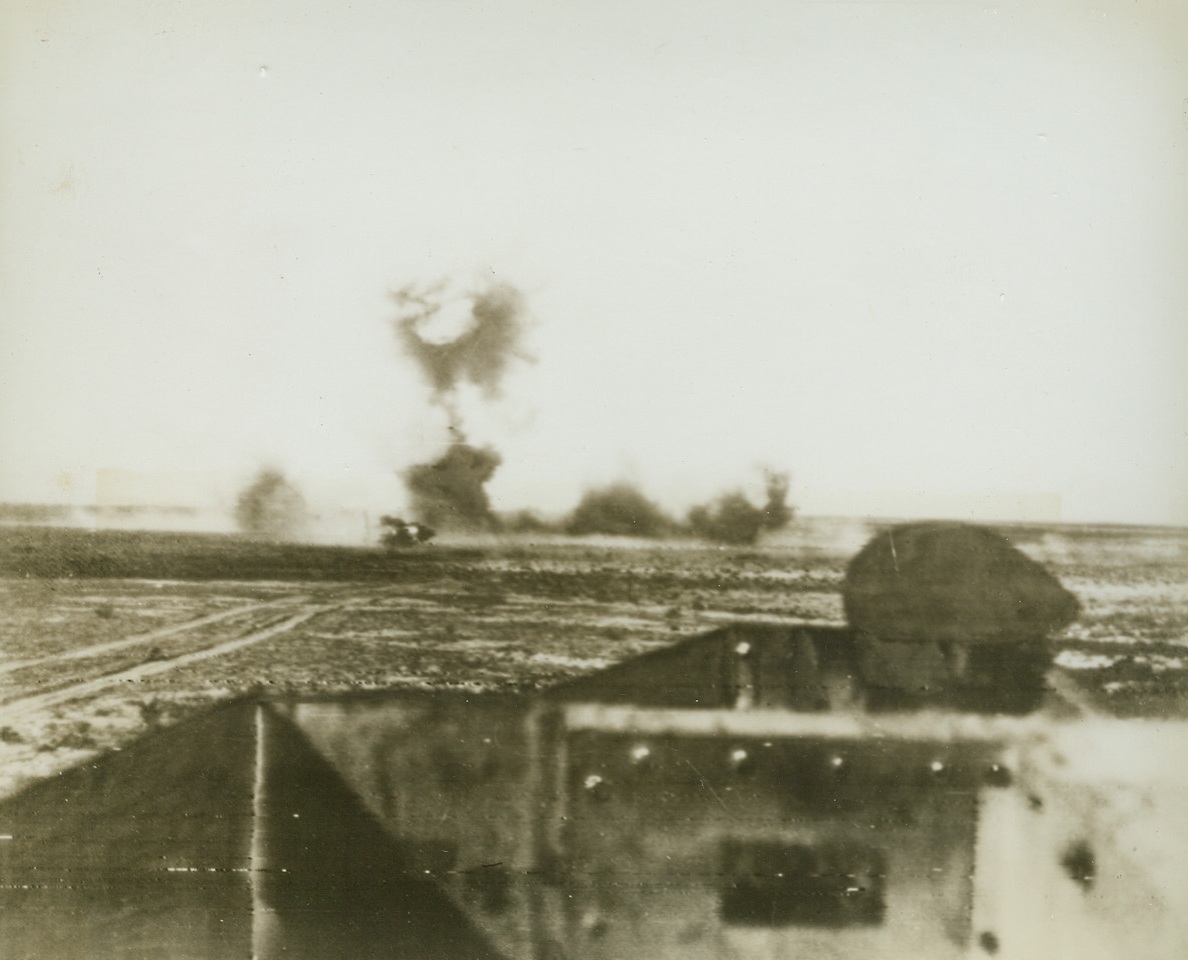
Blasting the Mareth Line, 3/25/1943. Tunisia – This is the first pictures showing action along the Mareth line, where the British Eighth Army is blasting at Rommel’s toughest defense. This view from an armored scout car shows a “Bangalore” torpedo being exploded to force a gap in the barbed wire around a minefield. The torpedo is an 8 to 10 – inch pipe filled with dynamite which is placed under the wire to make a breach so that soldiers van get through. It was named after a town in India, where it was first used. Credit line (ACME radio photo);
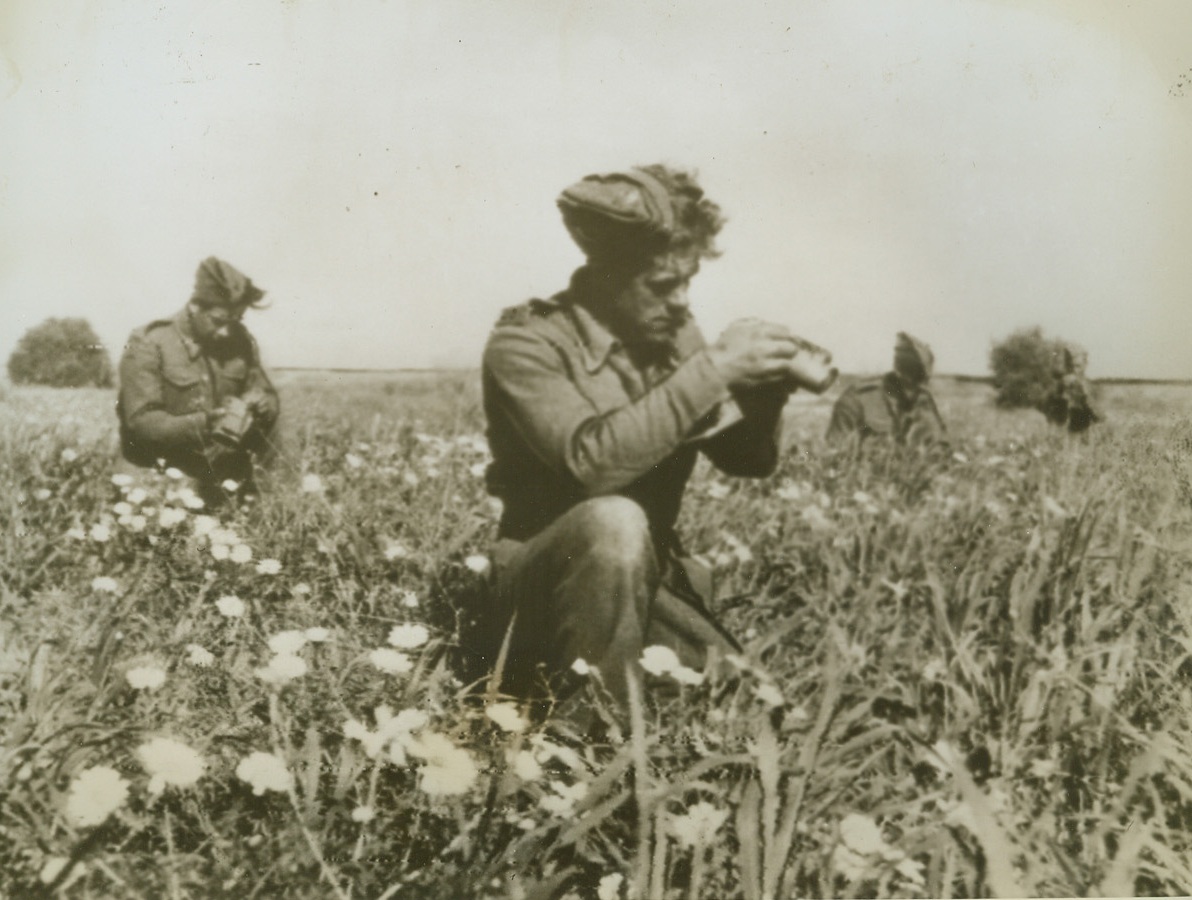
Death In a Daisy Field, 3/25/1943. Tunisia – This is the first picture showing action along the Mareth line, where the British Eighth Army is blasting at Rommel’s toughest defense. These Eighth Army sappers (engineers) are not picking daisies; they’re searching for enemy mines in a field outside Medenine. Credit line (ACME radio photo);
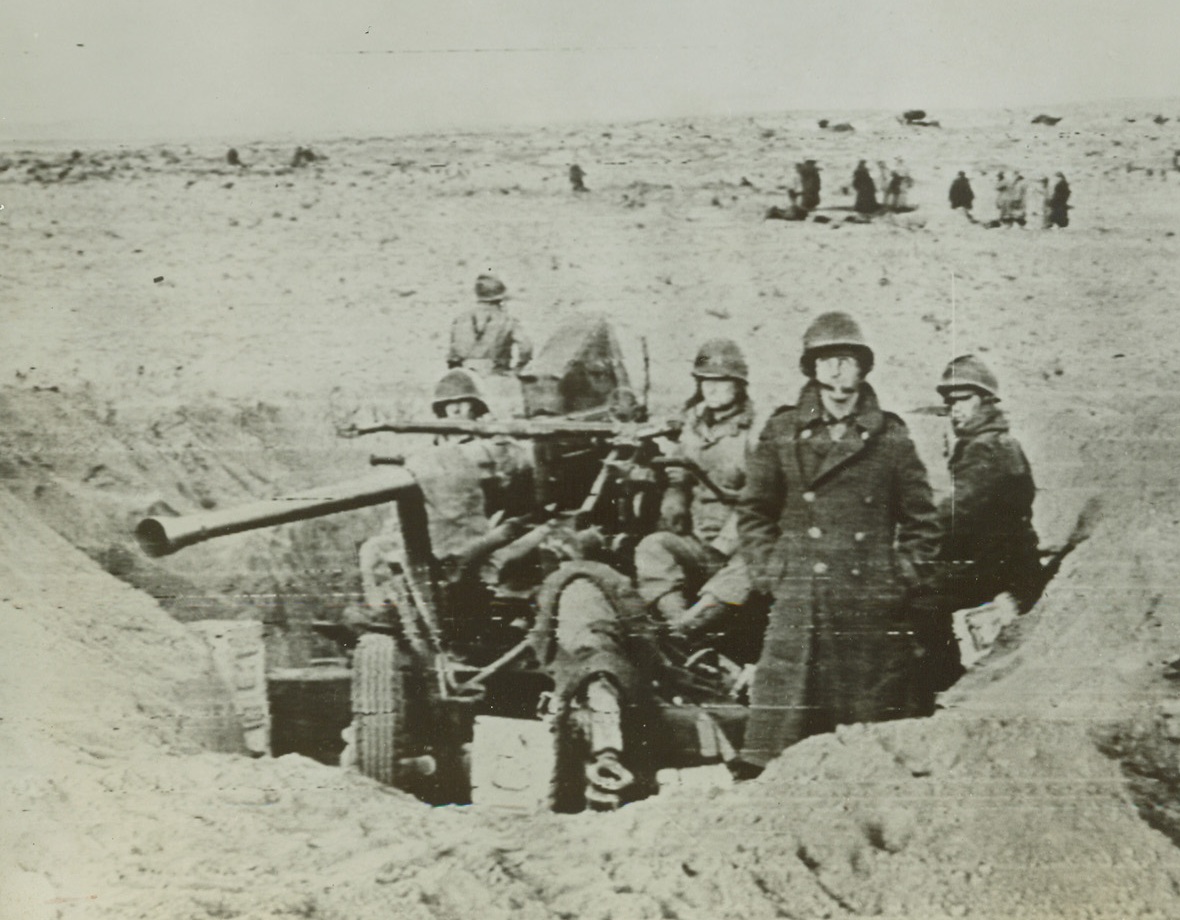
New Radio Telephoto Service Opens, 3/22/1943. Washington, D.C. – This photo, taken during the allied victory at Gafsa, on the North African front, has just been received over the newly established Signal Corps radio telephoto. The new service links directly the War department in Washington, with the headquarters of Gen. Dwight D. Eisenhower in Algiers, for two-way radio transmission. This photo, taken at the front and flown to Algiers, was transmitted in seven minutes. The picture shows a gun crew that has dug in and is on the alert. Credit line (U.S. Army Signal Corps);
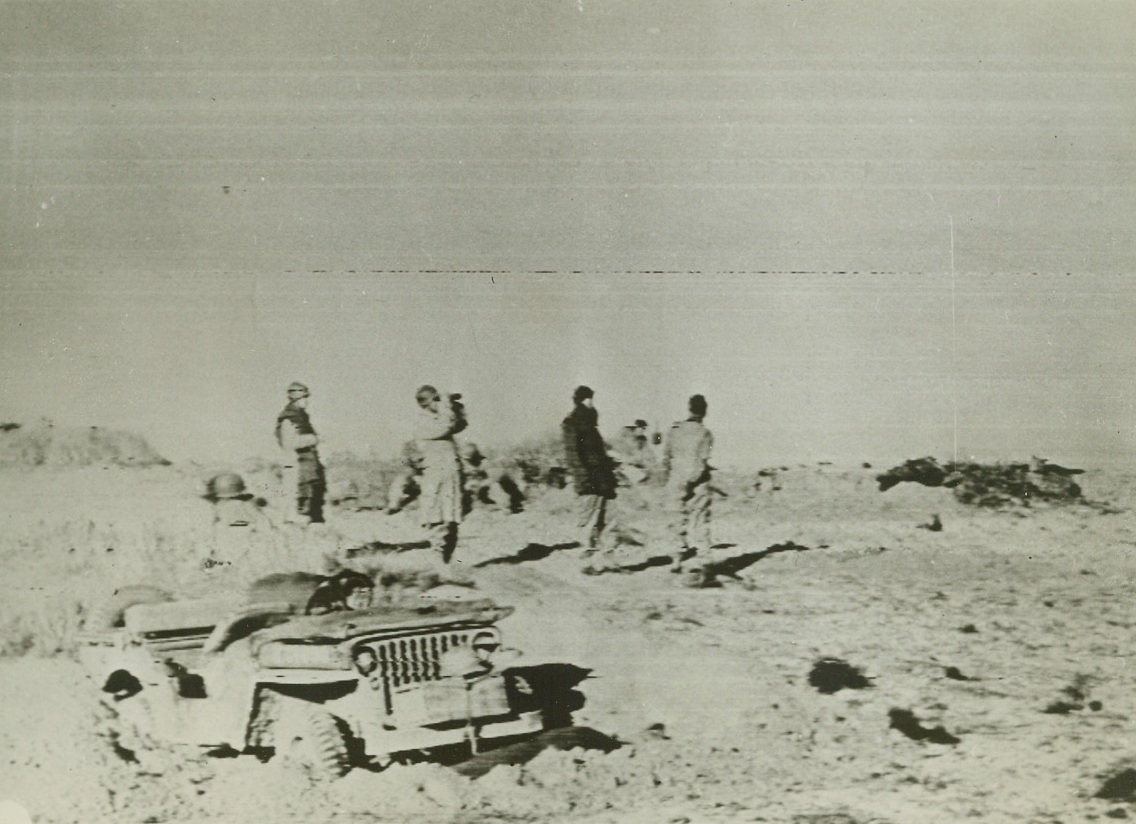
New Radio Telephoto Service Opens, 3/22/1943. Washington, D.C. – This photo, taken during the allied victory at Gafsa, on the North African front, has just been received over the newly established Signal Corps radio telephoto. The new service links directly the War department in Washington, with the headquarters of Gen. Dwight D. Eisenhower in Algiers, for two-way radio transmission. The picture shows allied officers observing the progress of the battle for Gafsa, from a forward position. Credit line (U.S. Army Signal Corps);
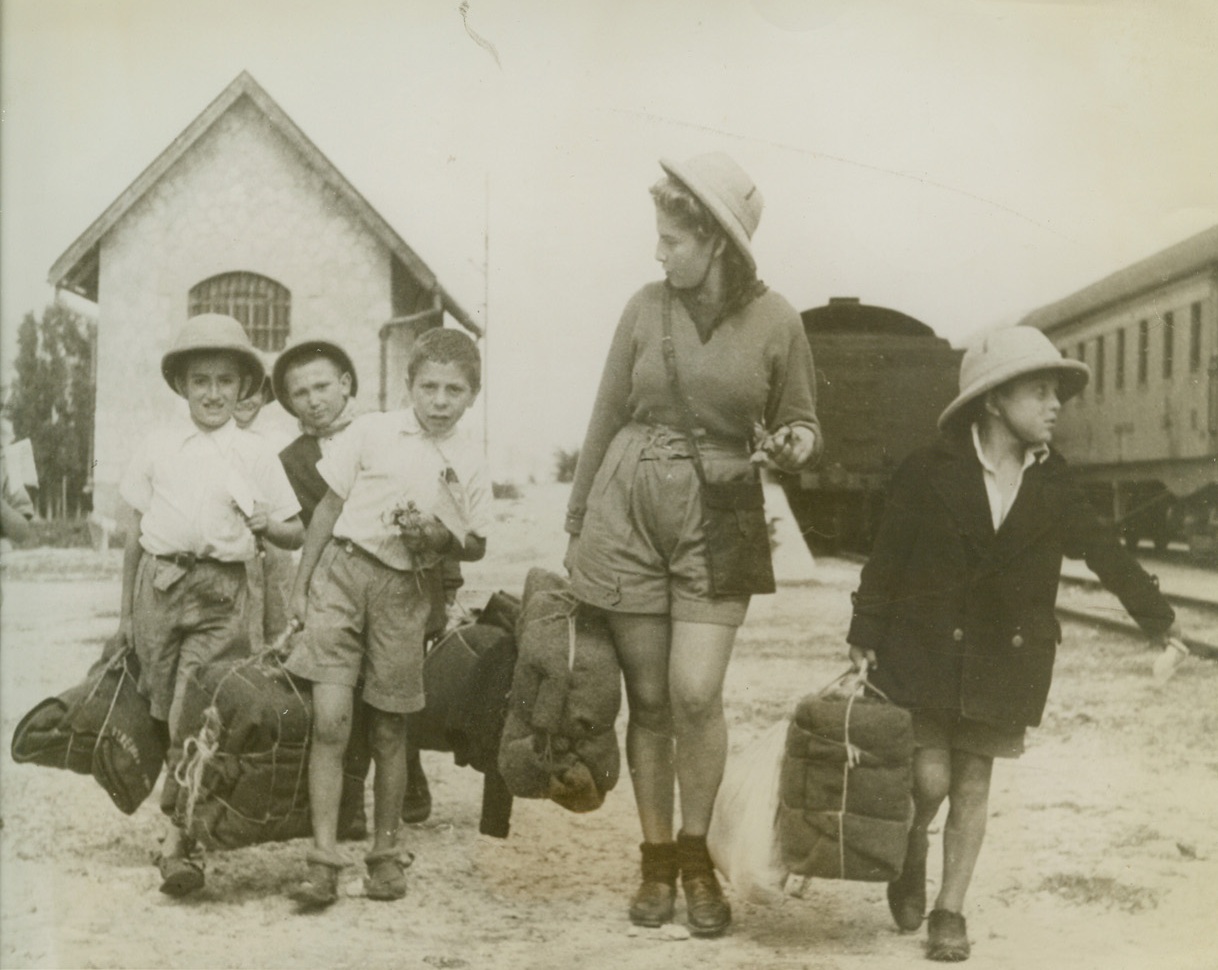
Safe At Least, 3/15/1943. Palestine – Toting their belongings, a group of young Polish refugees arrive safely in Palestine with one of the 50 children’s nurses who accompanied the youngsters. They came from their homeland via Teheran. Their education and maintenance in their new home will be financed by American funds. Credit line (ACME);
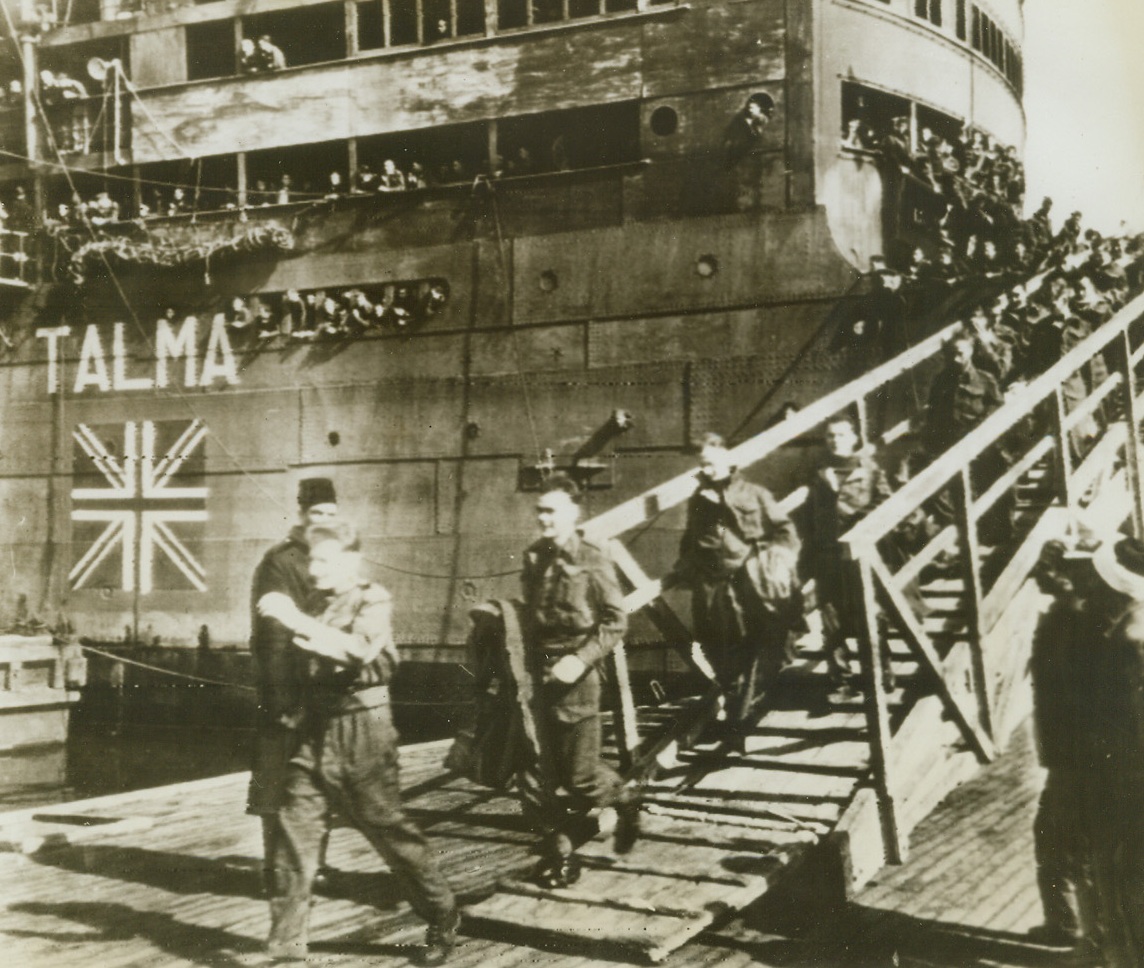
Prisoners of War Are Free Again, 3/25/1943. Middle East Port – Repatriated British soldiers walk down the gangplank from the British ship Talma at a Middle East port. They were parties to the biggest exchange of able-bodied prisoners in the war as 707 British soldiers were exchanged for 863 Italians and Germans at Mersin, Turkey, on March 21st. Credit line (ACME radio photo);
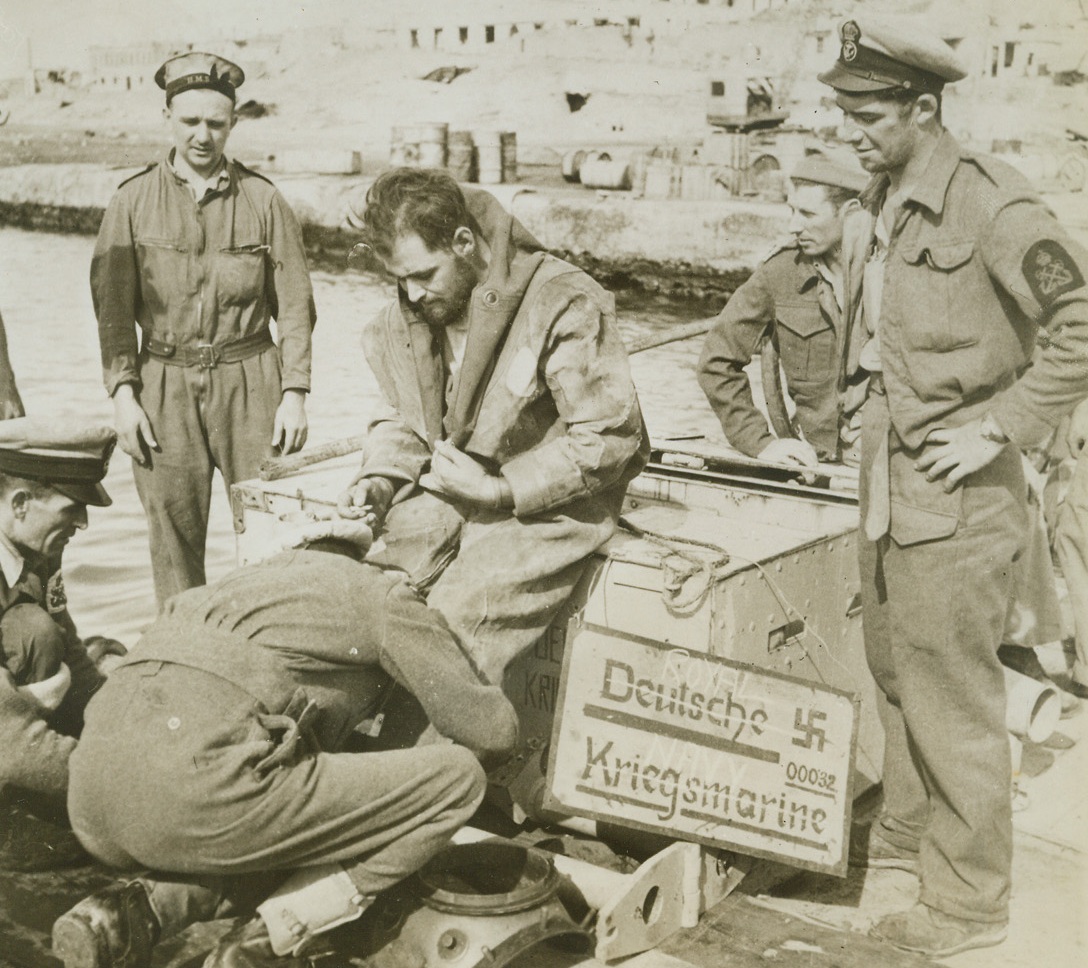
Nazi Contribution to Allied Salvage Work, 3/14/1943. Tobruk, Libya - - Nazi signs deck the equipment utilized by a British diver about to explore the ground gloor of Tobruk harbor. The enemy utilized the diver’s outfit before they were ousted from the Libyan coastal city. The allies had a big clean-up job confronting them before they could fully make use of the harbor which was cluttered by blasted axis vessels. Credit line (ACME);
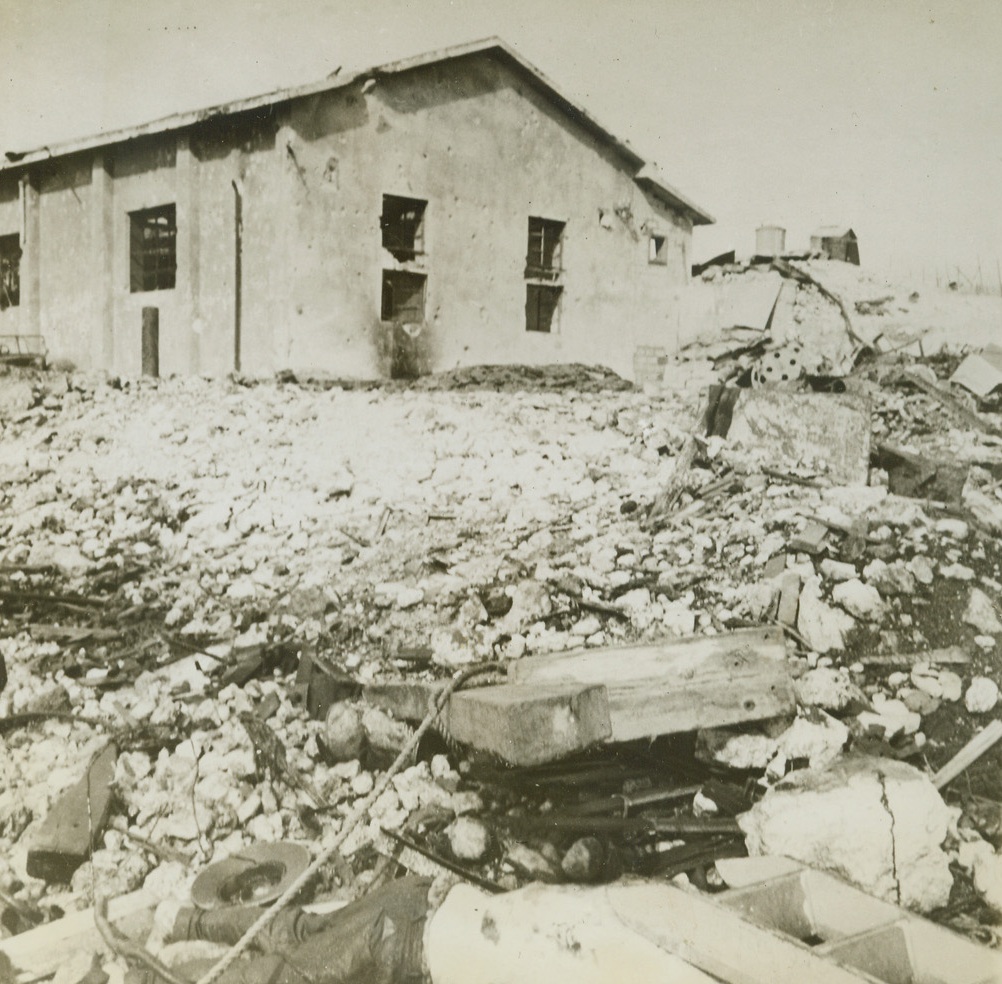
Wreckage – Man and Man Made, 3/14/1943. Tobruk, Libya – A dead Nazi soldier, washed ashore at Tobruk, lies half buried in the rubble of the city blasted and captured by the British 8th Army. In the background, a bulled-scarred building has its foundation in a shambles that is evidence of the force of British fire power in the Autumn of 1942 when the Nazis were ousted from the Libyan port. Credit line (ACME);
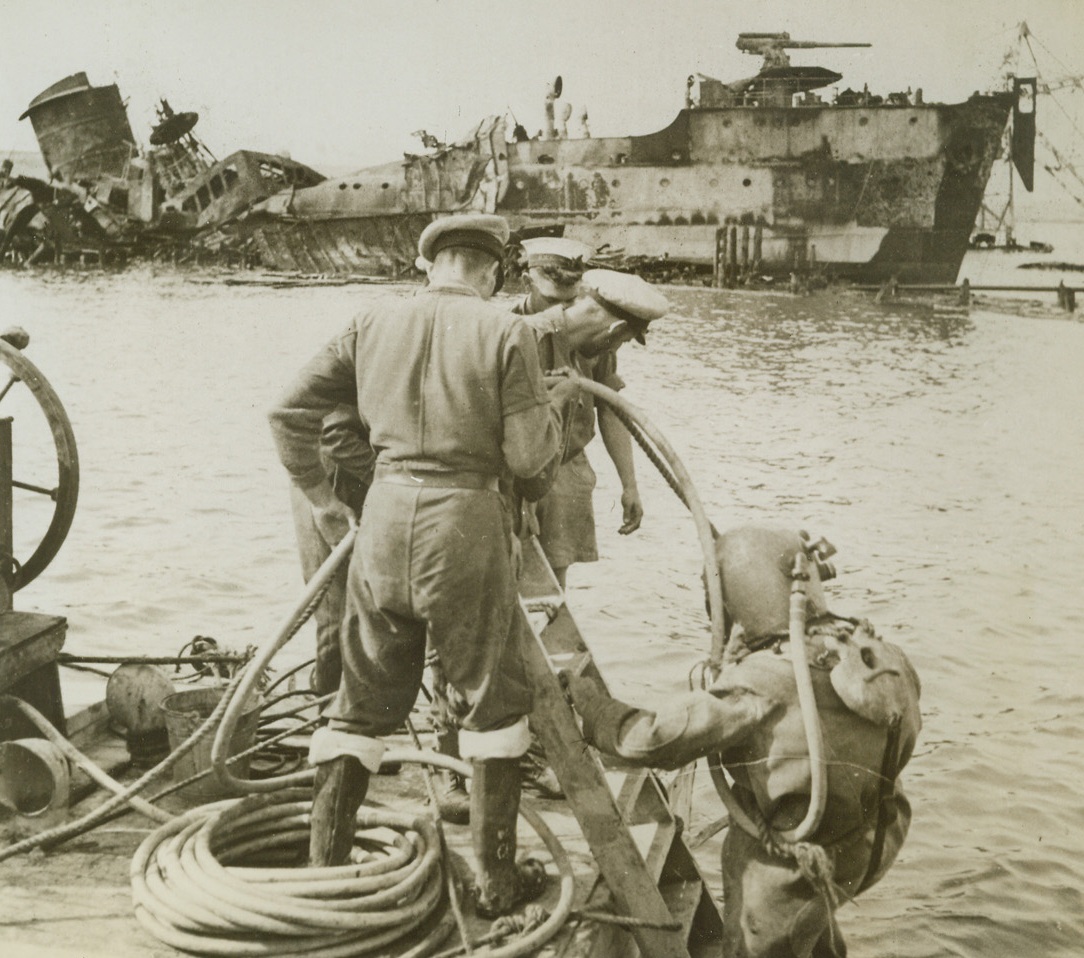
Capture - - Then Clean Up, 3/14/1943. Tobruk, Libya - - In Tobruk harbor, a British diver goes down under to inspect the wreck of an Italian tanked blasted by U.S. Liberator planes. The distorted wreckage of a freighter further clutters the valuable port. The rule of North African warfare has been: capture clean-up and use. Now, Tobruk is a busy allied supply base handling shipments for British and Americans maneuvering to close in on wily Rommel. Credit line (ACME);
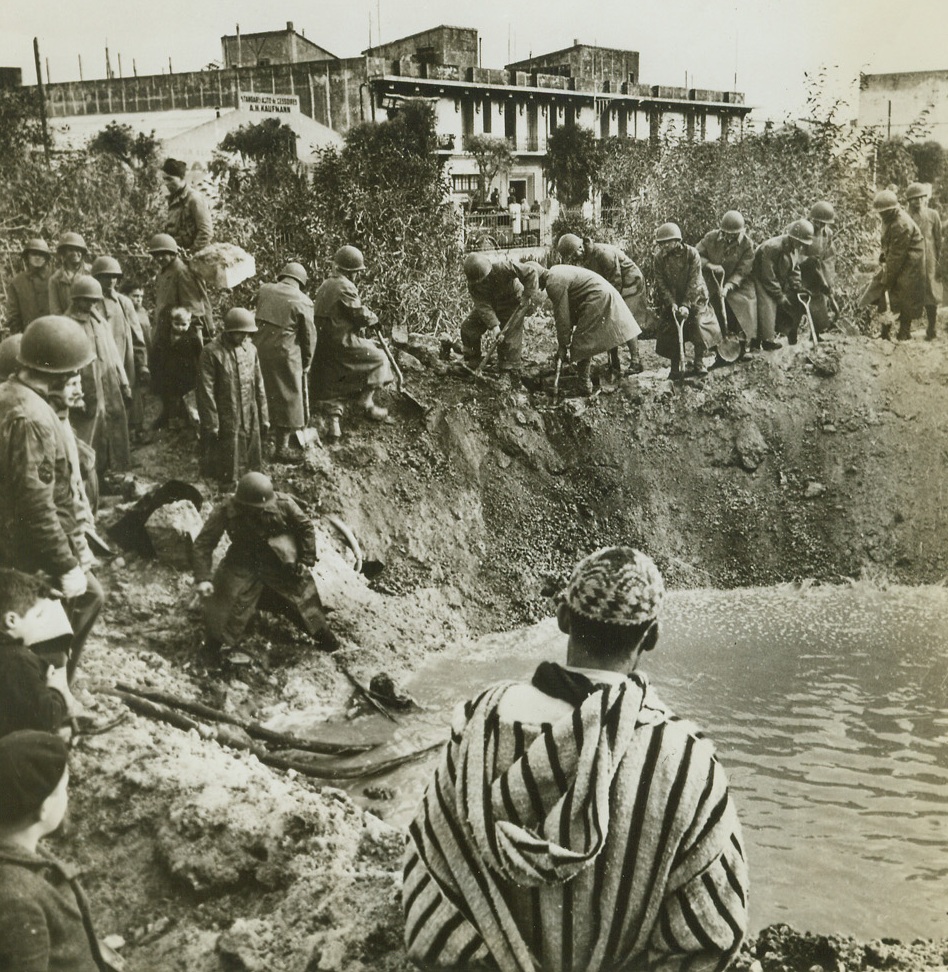
Quick Work, 3/7/1943. Casablanca – A native (foreground) watches as American soldiers fill in a bomb crater that was flooded by a broken water main which burst during a German bombing raid on Dec. 31. Note that hoses pump out water even as the hole is being filled. Credit line (ACME);
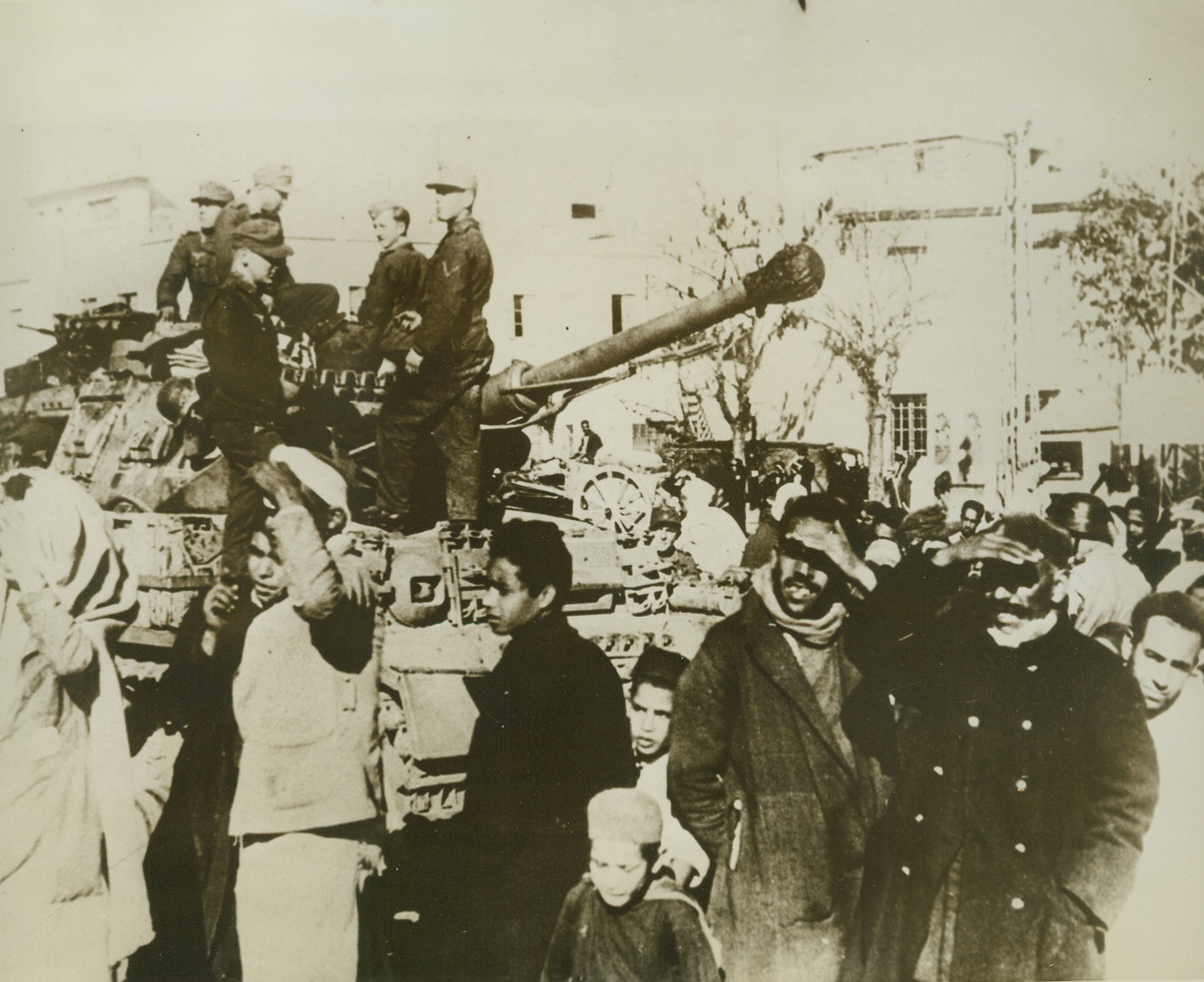
German Tank Forces in Tunis, 3/1/1943. According to the caption on this German photo, which has just arrived in New York by way of Lisbon, Nazi tanks are shown rolling through Tunis. The caption, however, neglected to explain why the natives in the picture --- as well as members of the one tank crew – are looking at something other than the tanks. Credit line (ACME);
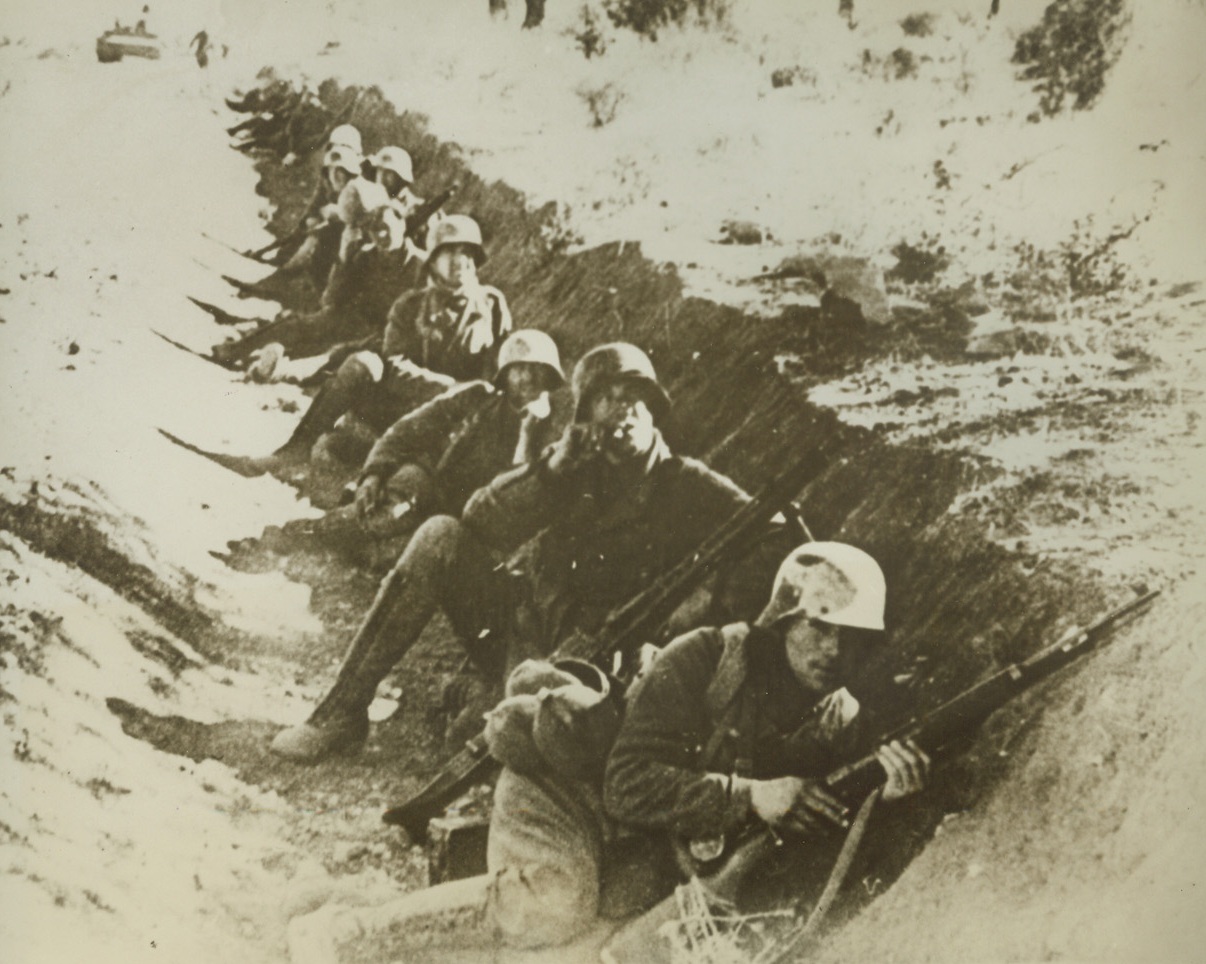
Nazi Infantry Wait in Trench, 3/1/1943. The caption of this German photo, just received in New York by way of Lisbon, says these soldiers are members of a German infantry division waiting in a shallow trench for the signal to fellow heavy tanks attacking United Nations troops “somewhere on the Tunisian front.” Credit line (ACME);
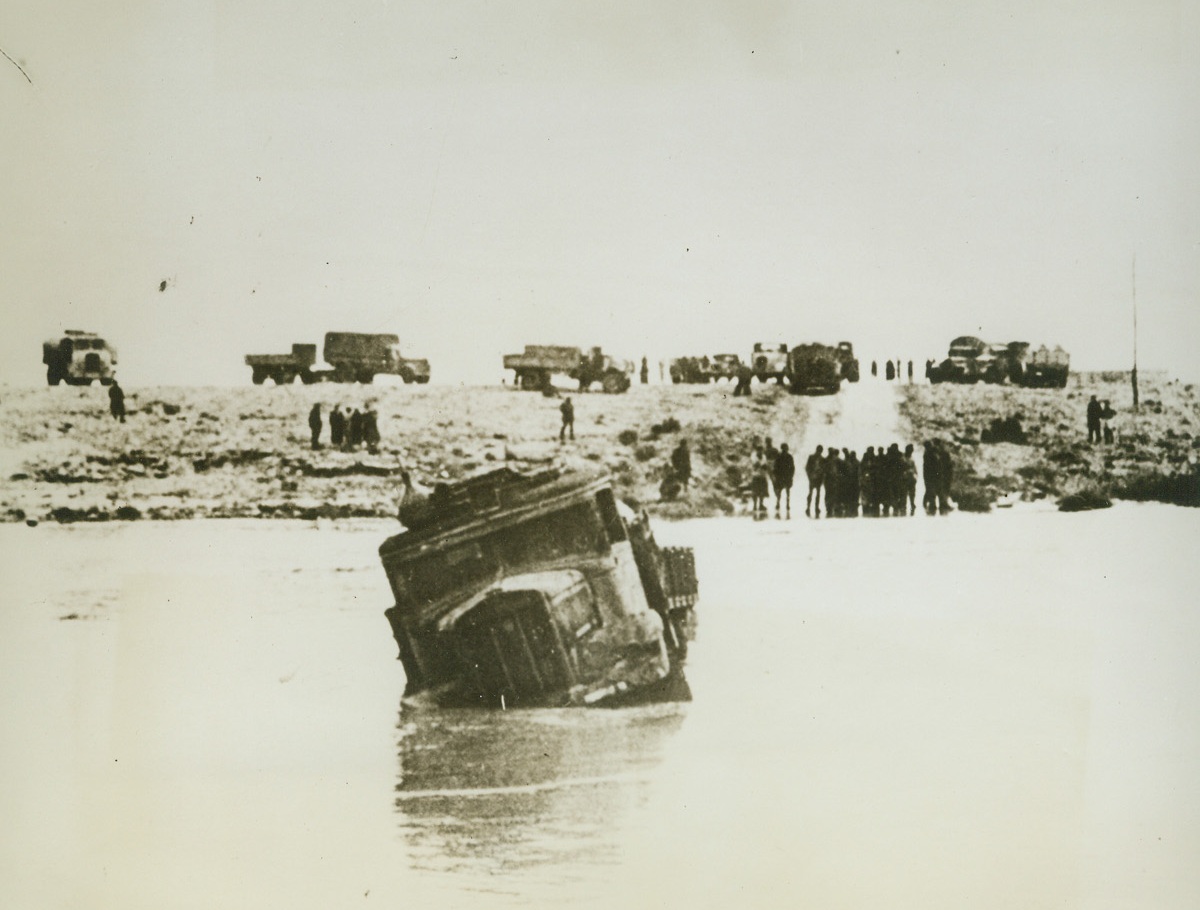
A German Column Bogs Down, 3/1/1943. According to the caption on this German photo, which has just been received in New York, by way of Lisbon, this motorized column of Nazi forces is shown halted along a road in North Africa as the result of one night’s heavy rain. One truck, (foreground), is completely bogged down after unsuccessfully trying to plow through flood in foreground. Credit line (ACME);
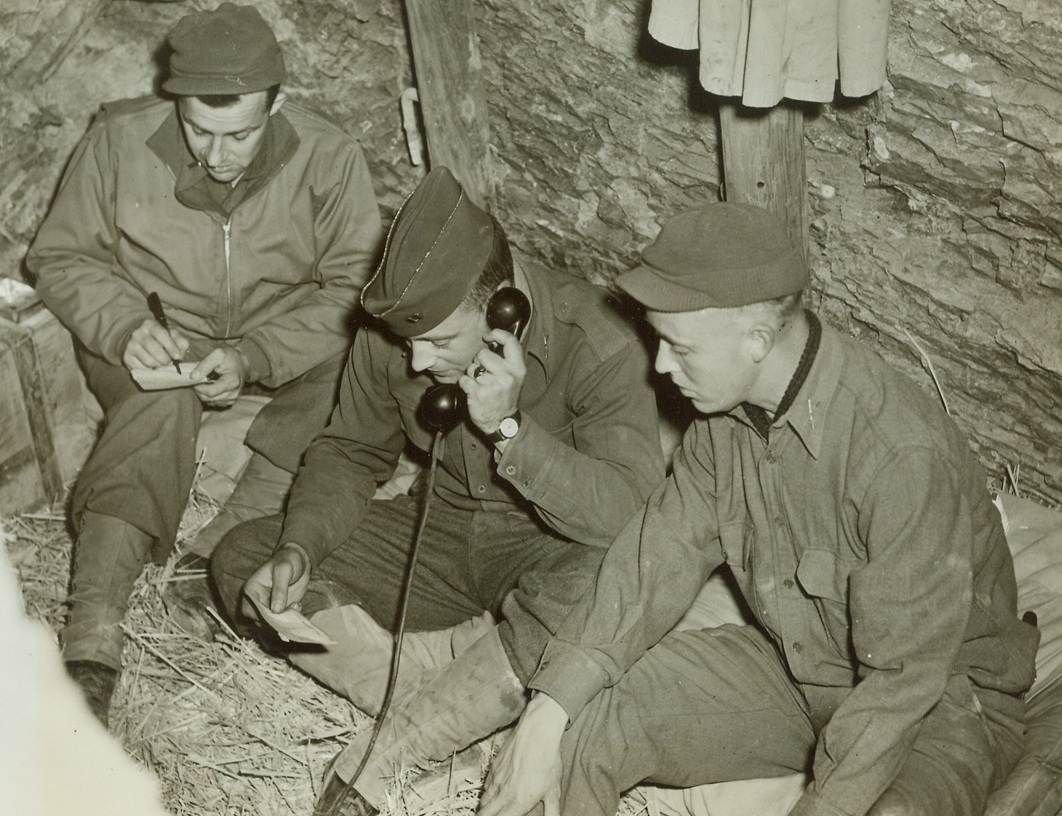
Communications in Tunisia, 3/2/1943. Tunisia - - A message is received via field telephone at an American outpost set up in a hillside dugout in Tunisia. Credit line (ACME);
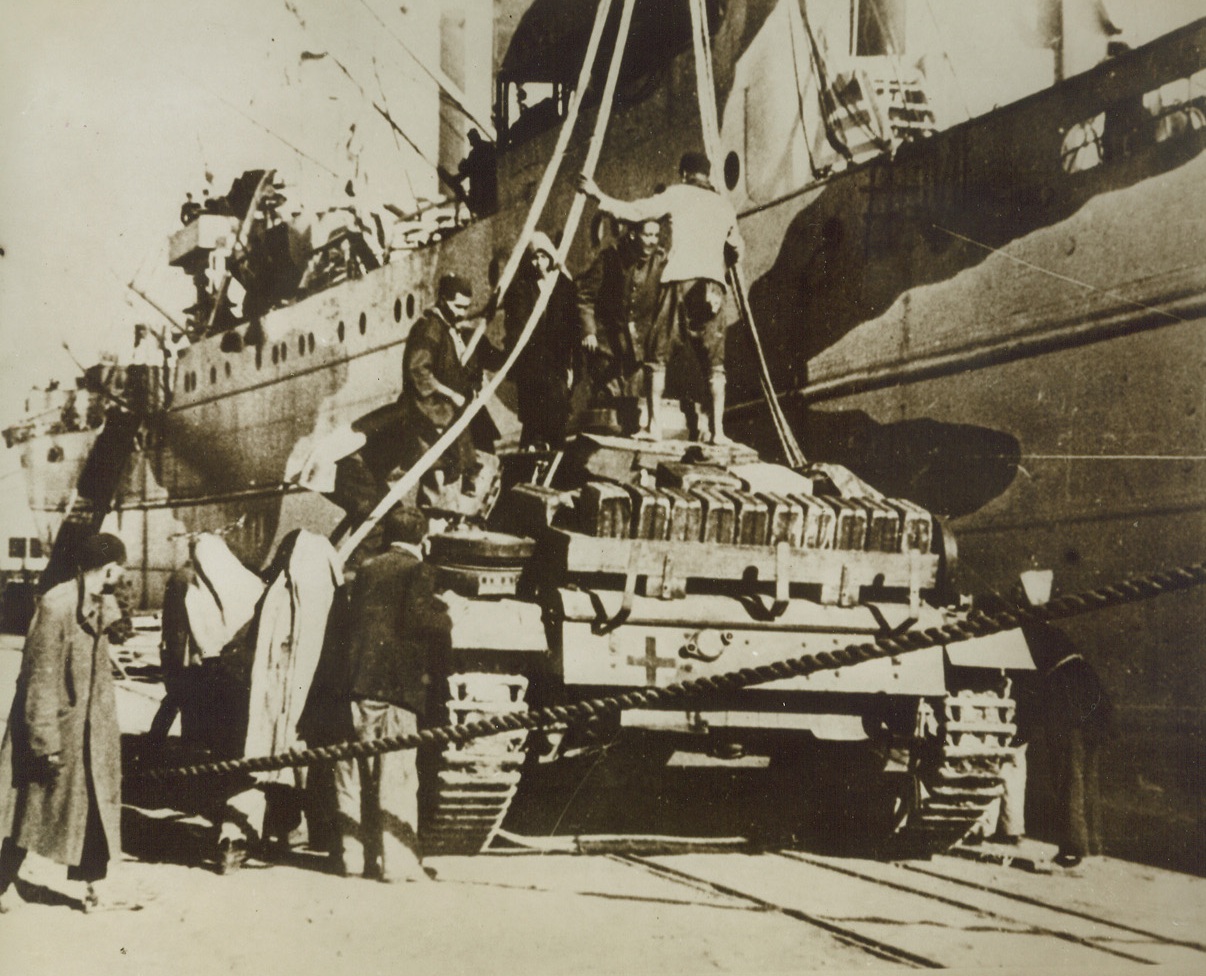
Tanks for the Afrika Korps, 3/1/1943. In this photo from a German source, tanks for Marshal Rommel’s Afrika Korps are shown as they were unloaded from a Mediterranean transport at a North Africa port. Photo has just been received in New York by way of Lisbon. Credit line (ACME);
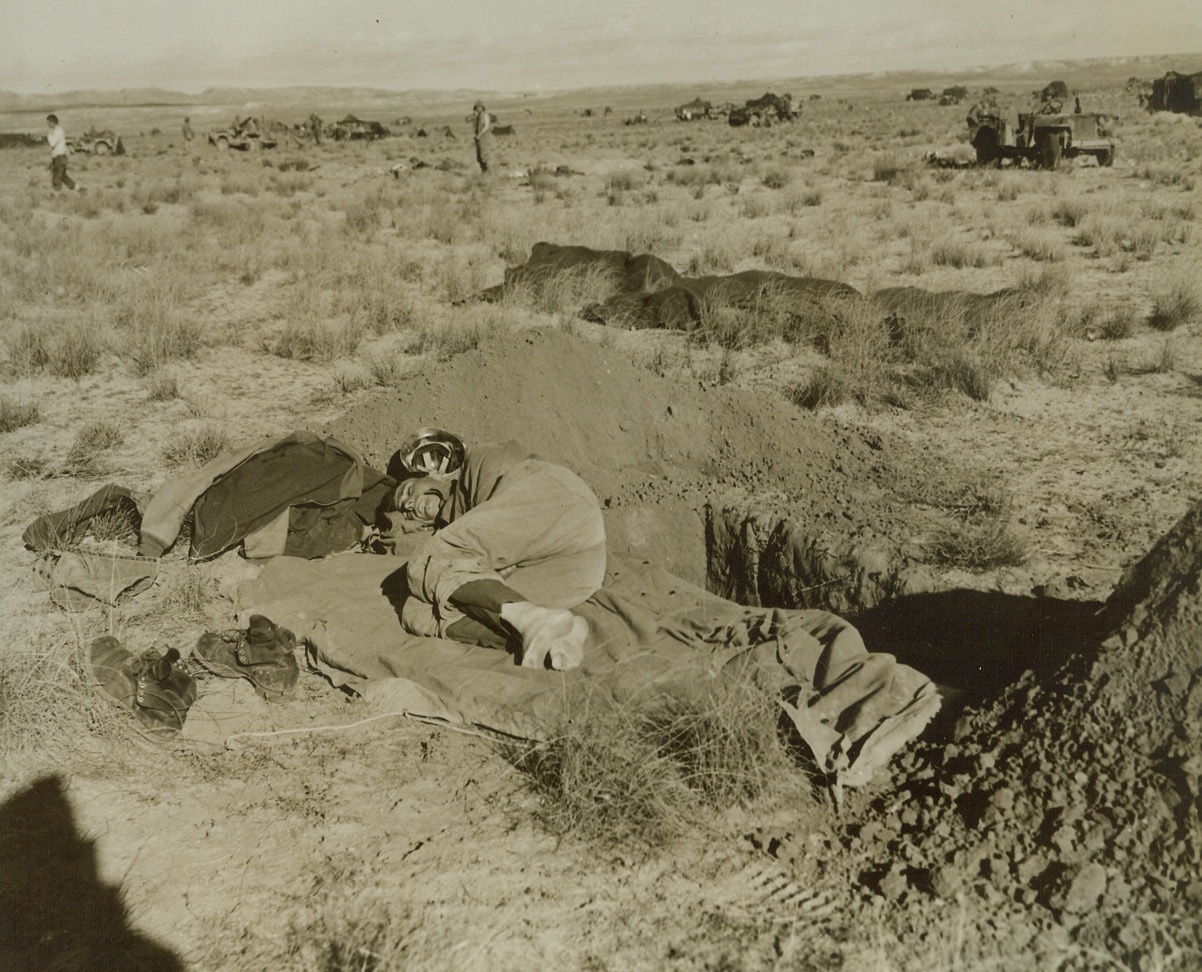
Asleep in the Field, 3/2/1943. Tunisia - - Pvt. David Chittenden, of New York city, after an all-night patrol, snatches a nap on the edge of his slit-trench, ready to roll for cover at the approach of enemy raiders. Credit line (ACME);
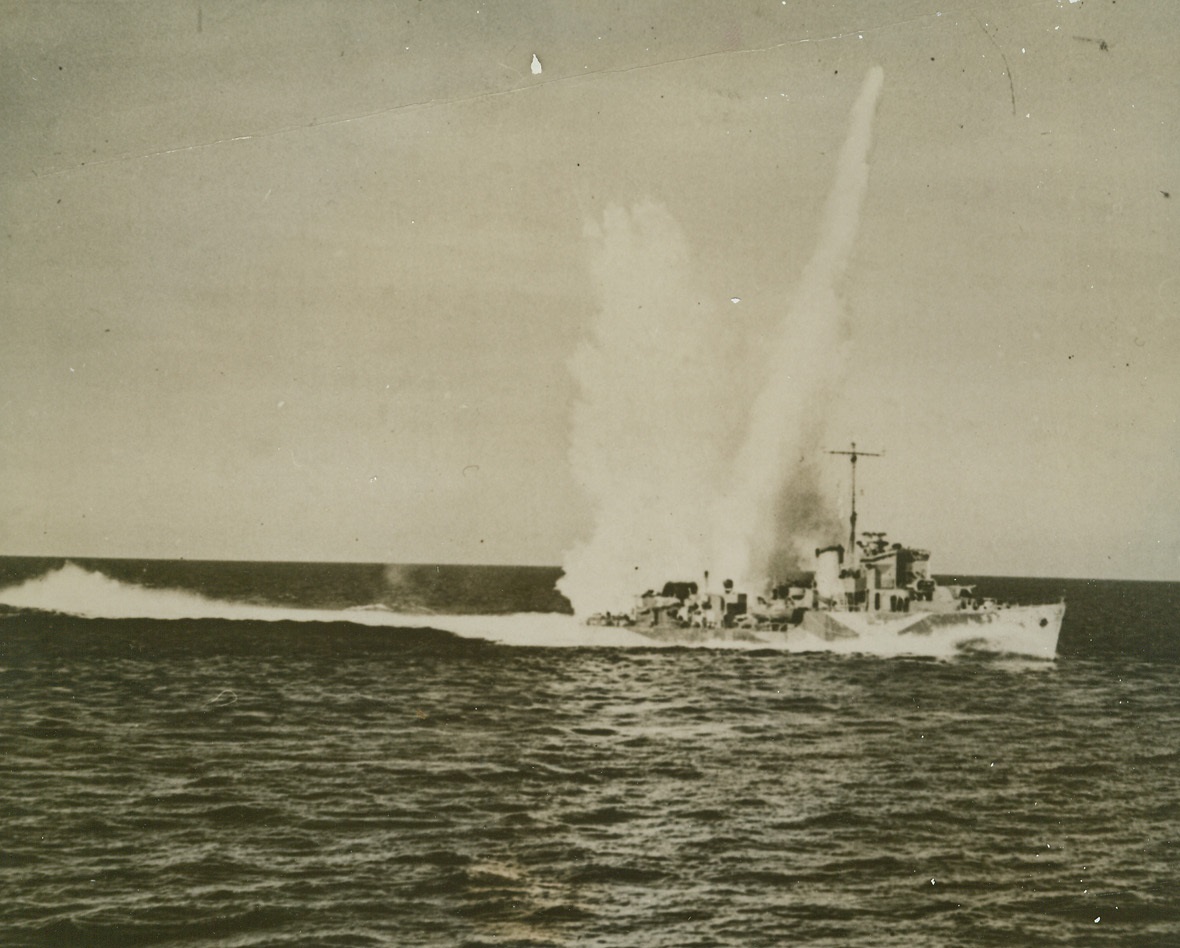
Look Out Below!, 3/1/1943. Columns of water shoot up from an exploding depth charge, which this British Destroyer has just put overboard during an attack on an enemy submarine, “somewhere on the high seas.” (Passed by Censors) Credit: ACME;
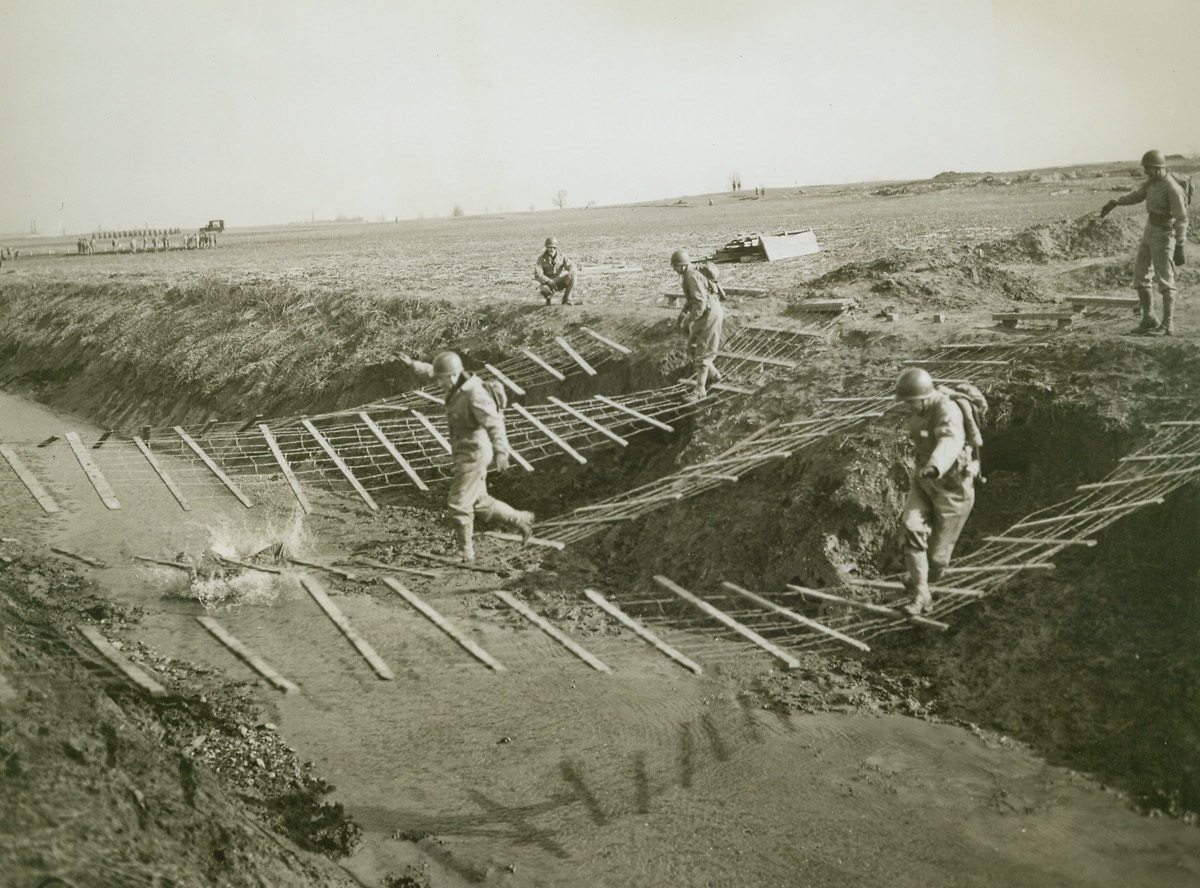
From Labor Leader to Tough Commando, 3/23/1943. Camp Atterbury, Indiana -- A trio of labor leaders swing-and-sway their way across wire bridges, where fence logs woven into the wire at two-foot intervals offer precarious footing. It’s part of the obstacle course that had United Automobile Workers, CIO, grunting and groaning during the first day of a three-day stretch in the army at Camp Atterbury. Credit: ACME;
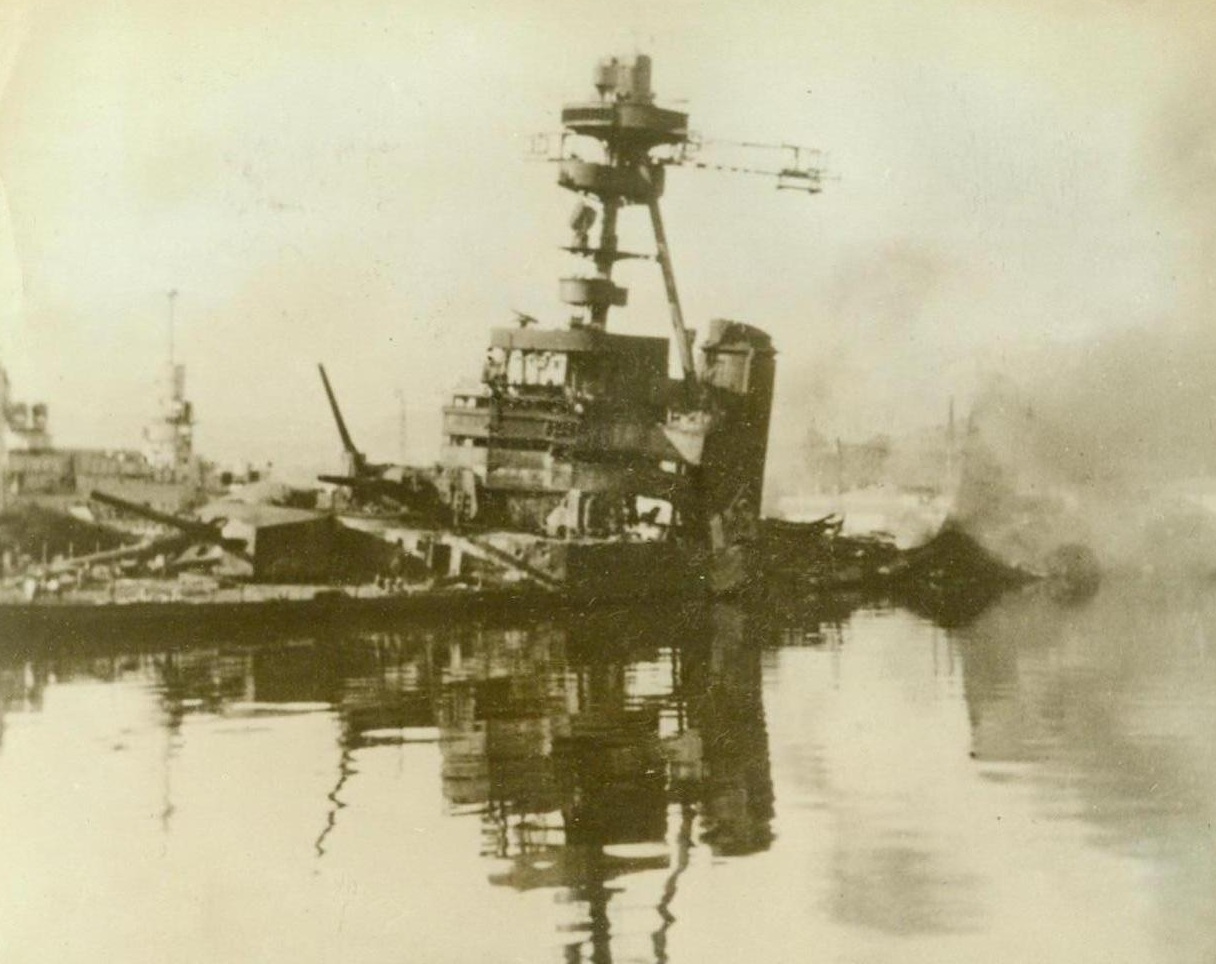
For the Honor of France, 3/2/1943. This photo, which was smuggled out of France and which reached New York today, shows the burned out hulk of a heavy French cruiser as it settled to the bottom of Toulon Harbor. It was one of more than fifty units of the French fleet destroyed or damaged last November 27 by their crews rather than let the warships fall into Nazi hands. Passed by censor. Credit: ACME;
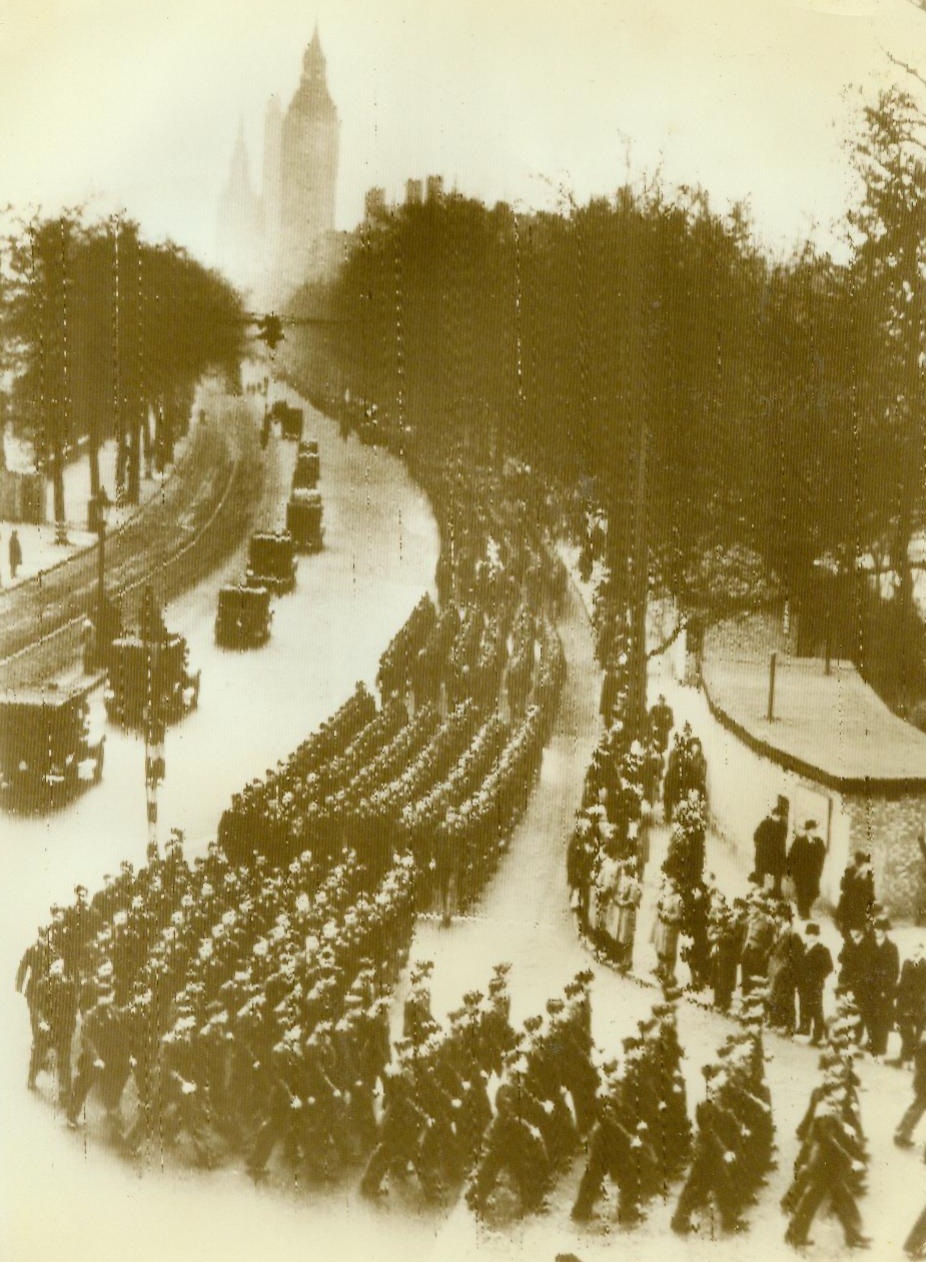
American Airmen March, 3/11/1943. London -- American Air personnel lead an Allied procession along the Thames embankment in London this morning as part of the “Wings for Victory” ceremony in which activities of both British and American Airmen were extolled. Credit: ACME;
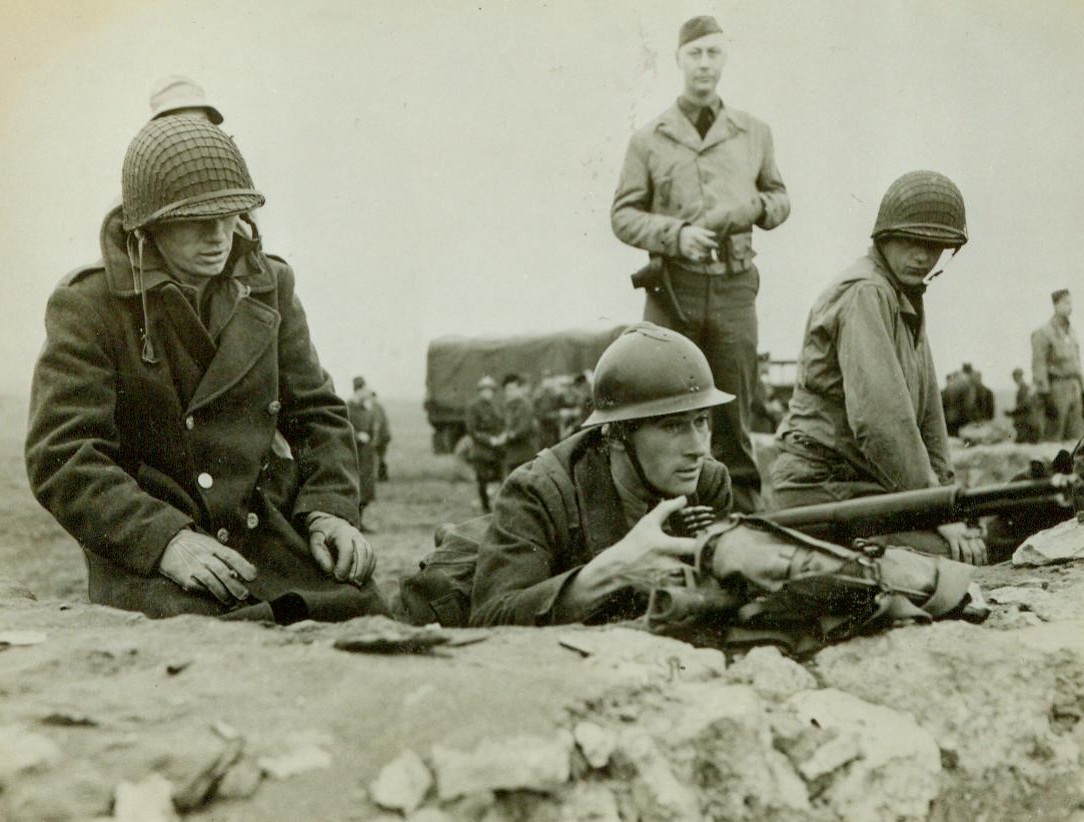
French Learn to Use American Guns, 3/13/1943. Algiers -- Three American soldiers watch as a French Poilu takes his test in the use of a Garand rifle on a range near Algiers. French army officers and men in North Africa are now being taught how to use various U.S. Army weapons and equipment so that they can operate in the African theatre with American-supplied material. Credit: U.S. Army Signal Corps photo from ACME;
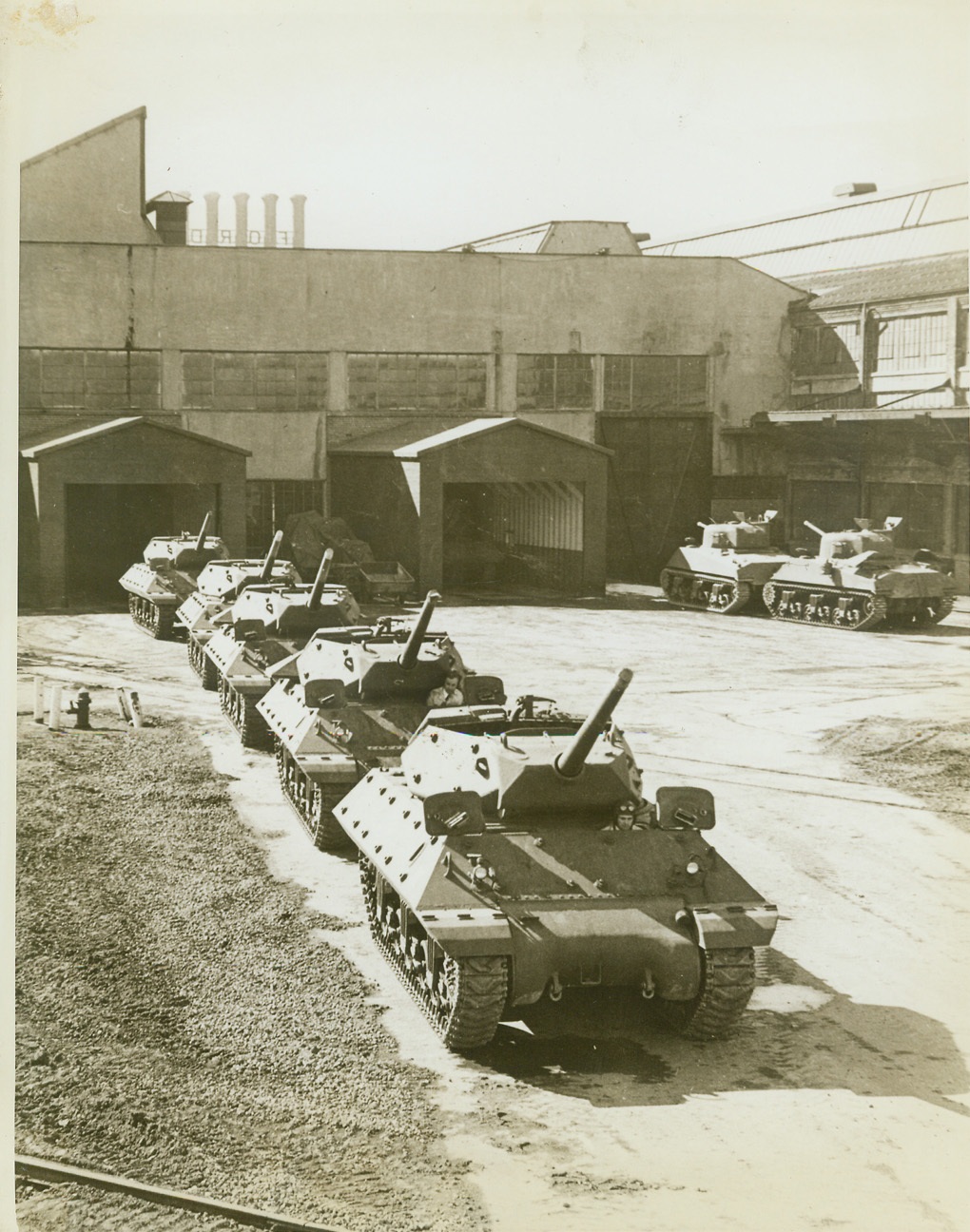
New Tank Busters for Uncle Sam, 3/11/1943. DETROIT, MICH. – A row of rangy, hard-hitting M-10 tank destroyers roll out of a Detroit plant of the Ford Motor Co. Faster, and with more hitting power than the medium tank, these new machines have already been in action and pronounced “hot stuff” by the Allies in North Africa. Note how different the M-10 is, than the M-4 medium tanks at right, (in background), which were also built by Ford. The two types of armored equipment come off the same production line. Credit: (ACME);
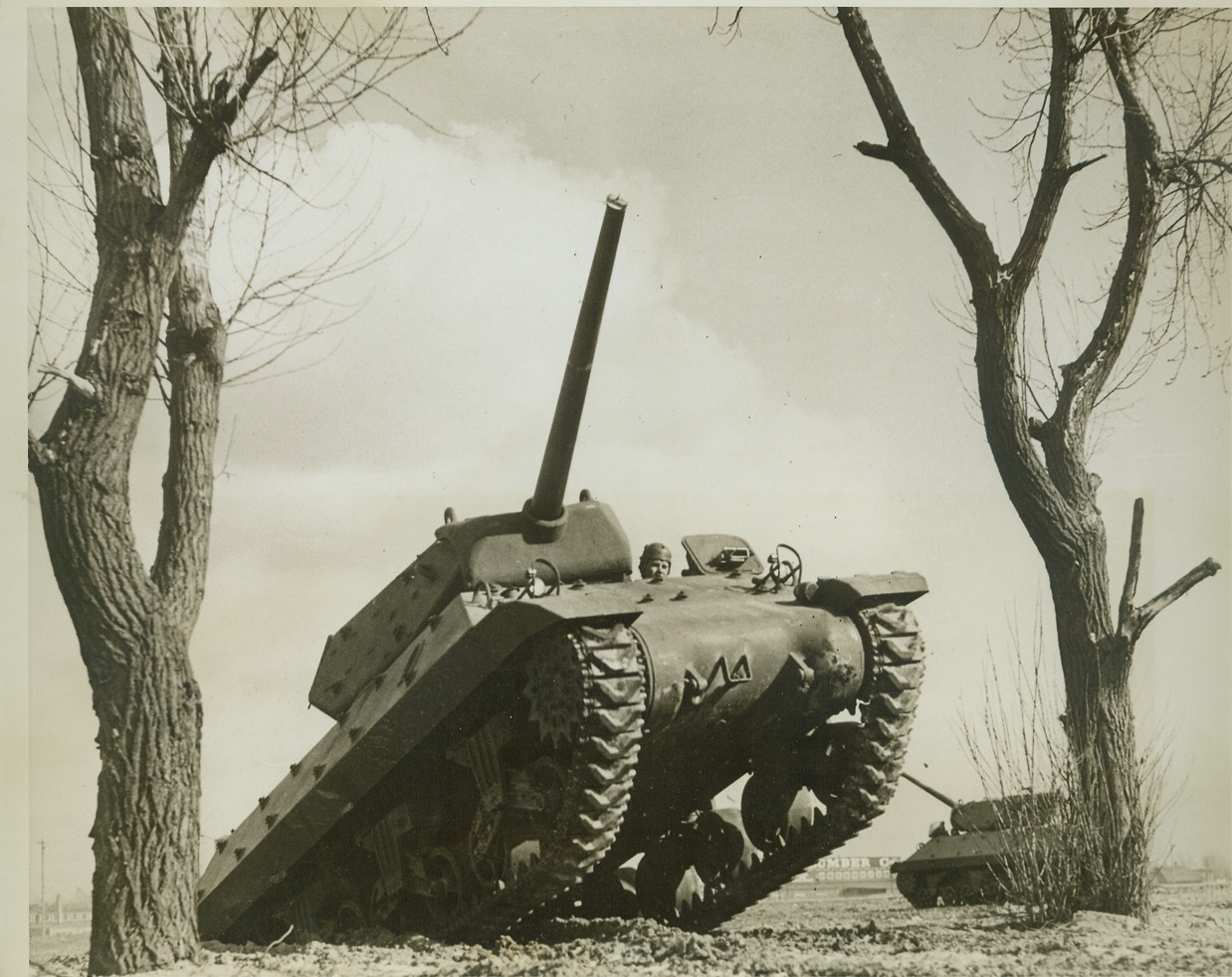
New Tank Busters Go Through Their Paces, 3/14/1943. DETROIT, MICH. – Two new M-10 tank destroyers go through a stiff workout on the Ford Motor Co. test grounds. Stripped of many of the engineering refinements found on the medium tank in order to gain speed (they both come off the same production line). The M-10 packs a greater wallop with its 3-inch gun. Credit: (ACME);
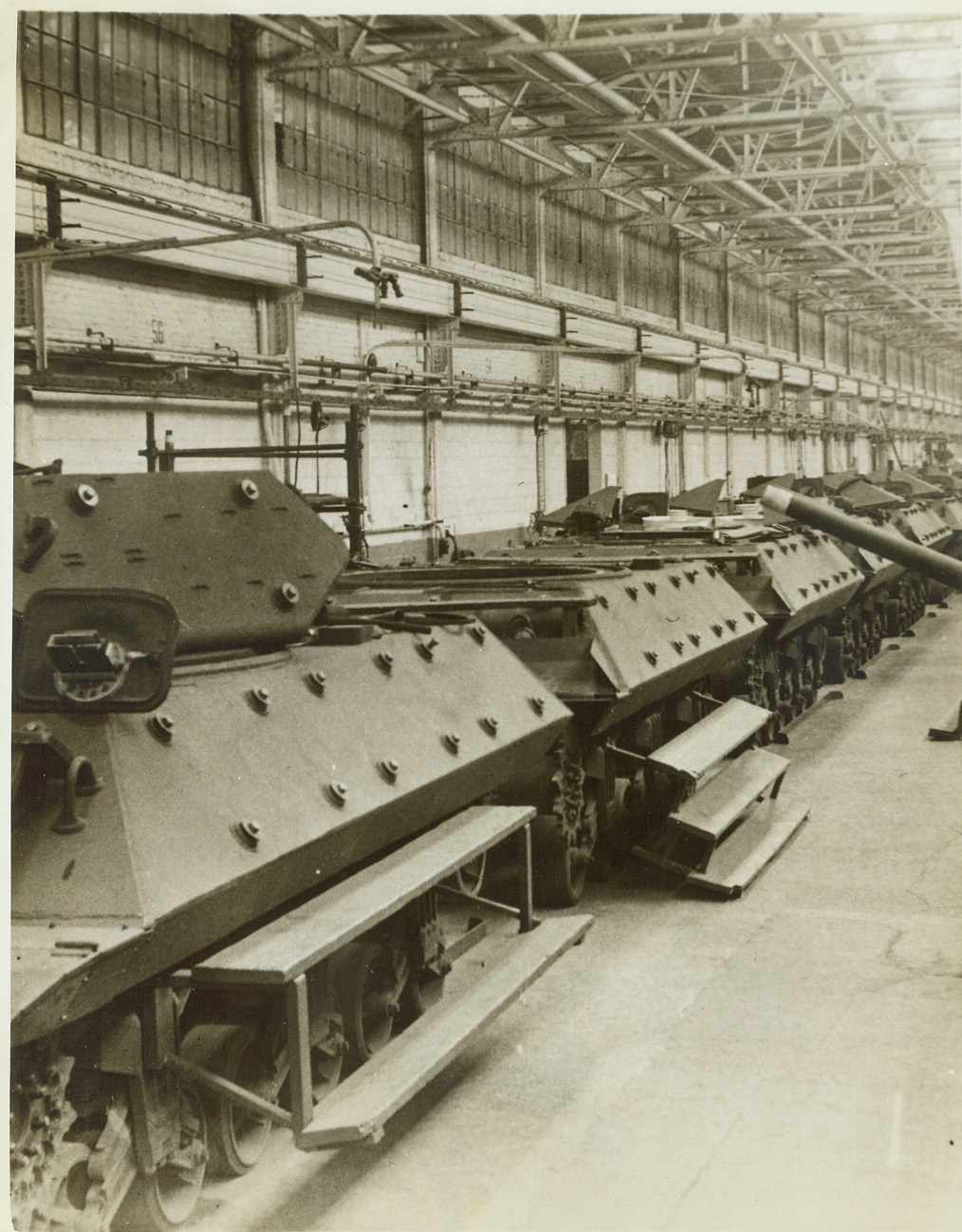
New Tank Busters on Production Line, 3/11/1943. DETROIT, MICH. – A long line of new M-10 tank destroyers minus their treads, on the production line at a Detroit plant of the Ford Motor Co. These hard-hitting tank busters have been rolling out of the plant for several months and have seen action in North Africa, where they are pronounced a success by the Allies. The M-10 in left foreground has already had its turret put in place. Next one in line waits for its turret, the gun of which can be seen at right, (center of photo). Credit: (ACME);
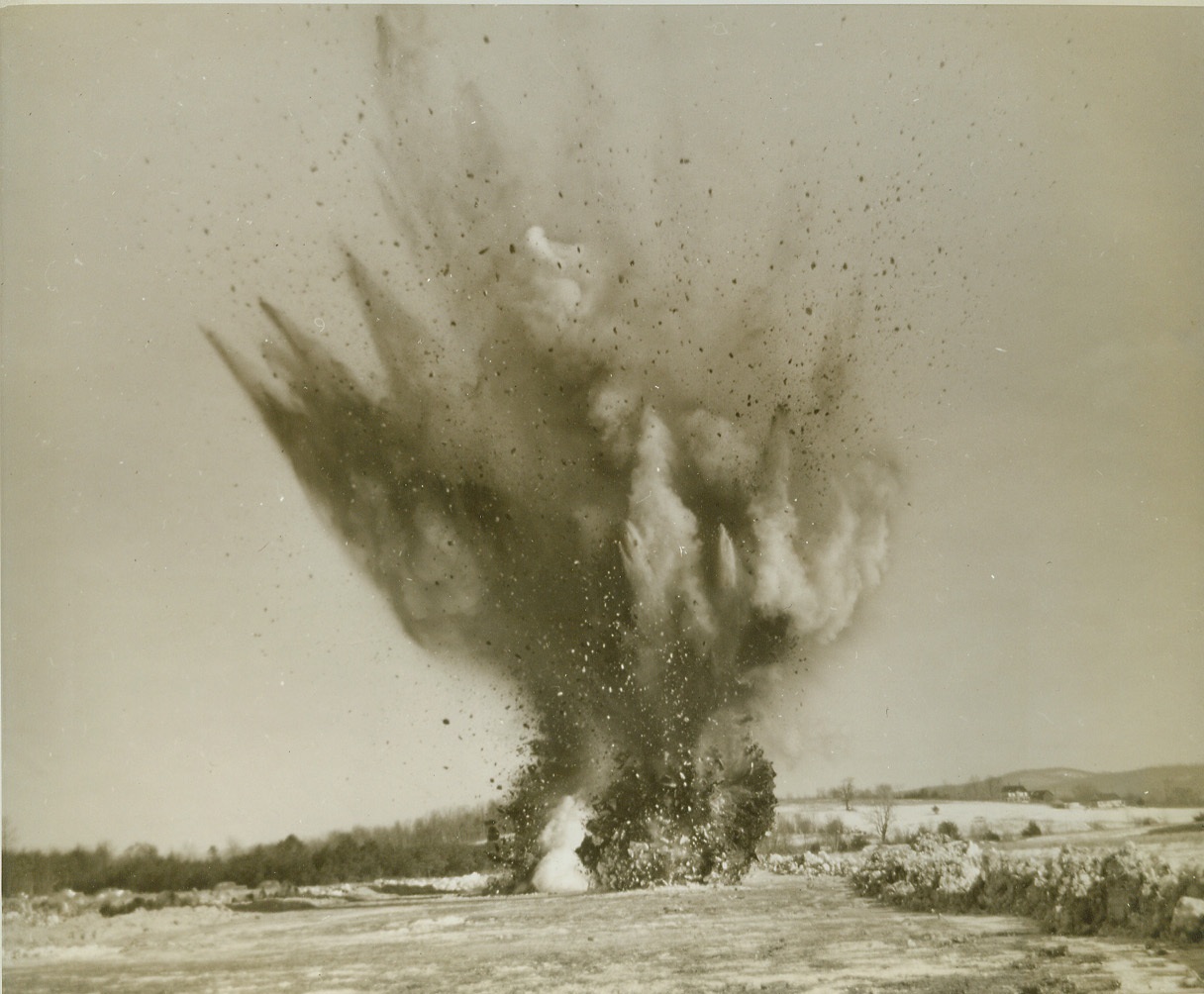
“Bomb” Damages Runway, 3/3/1943. WESTOVER FIELD, MASS. – For the benefit of air borne engineers training at Westover Field, a bomb explosion is simulated on a stabilized earth runway. When the “bombing” is reported, the engineers immediately load their miniature equipment into planes and set out to repair the damage. Credit: (ACME);
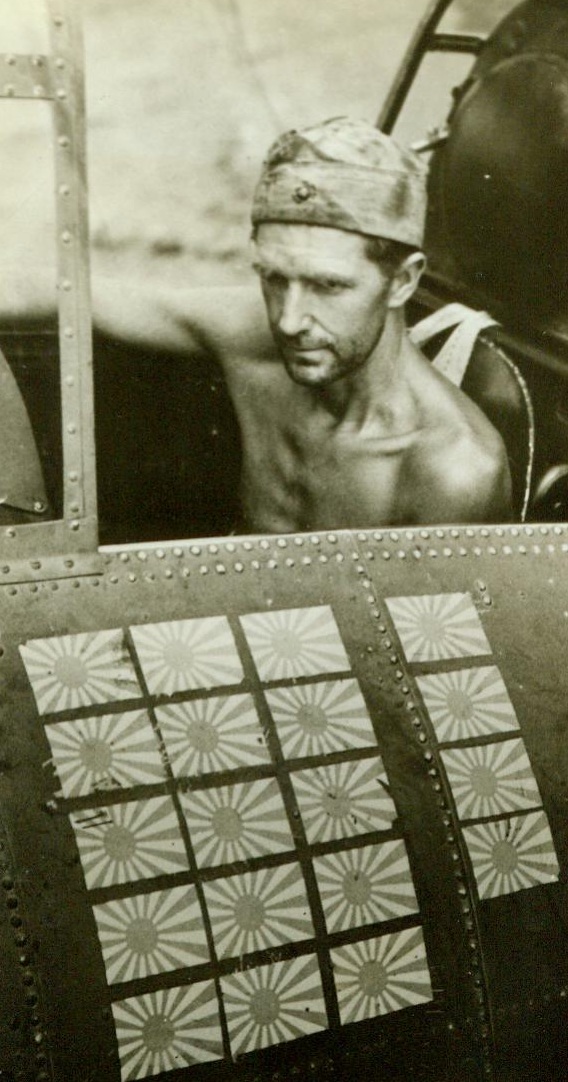
Two Guadalcanal Veterans, 3/22/1943. Guadalcanal – Nineteen rising suns deck the Grumann Wildcat fighter plane of Tech. Sgt. R. W. Greenwood, Jamesport, Mo., who awaits orders to take off from Henderson Field. Although several pilots have flown the ship on successful missions, the wiry Marine sergeant has remained plane Captain. 3/22/43 (ACME);
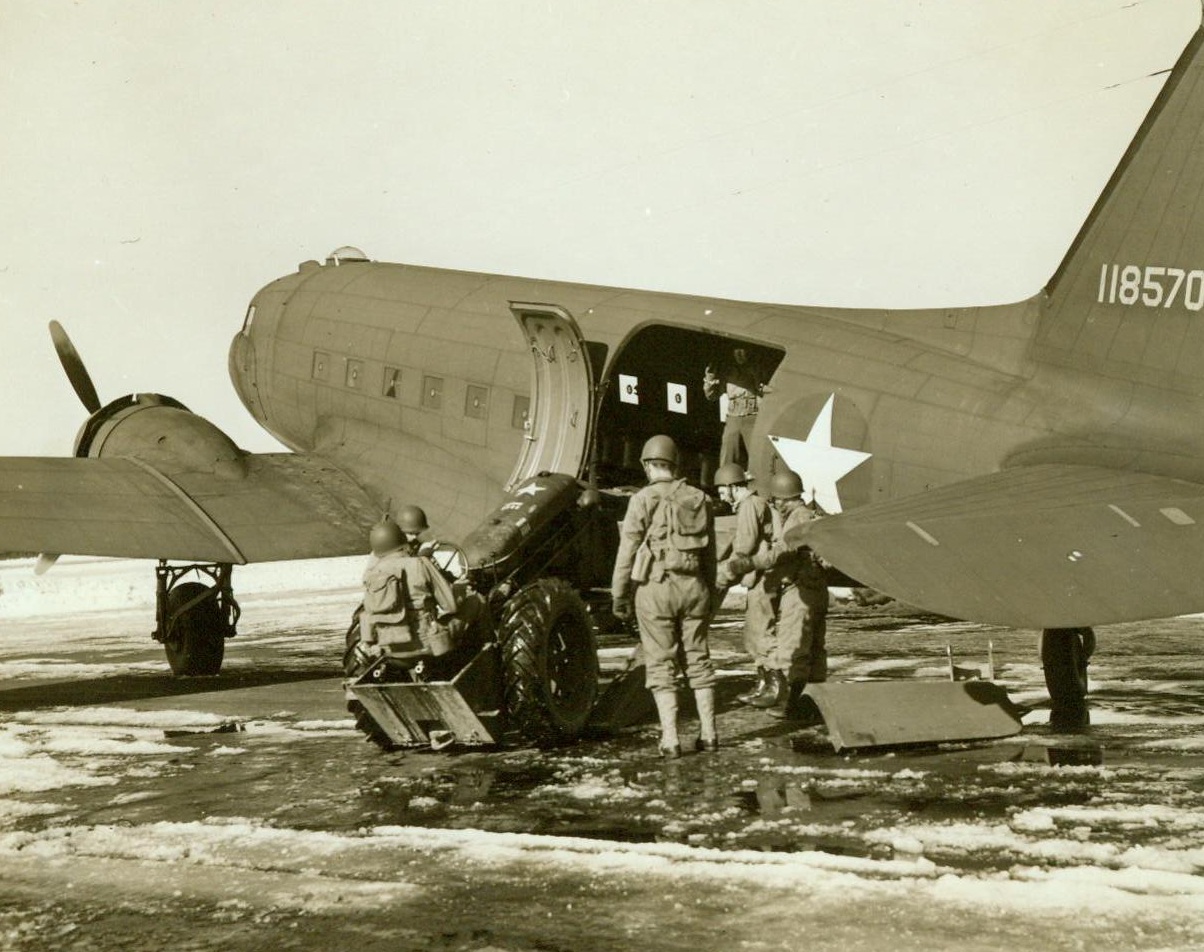
Spring Into Action, 3/3/1943. Westover Field, Mass. – Airborne engineers, training at Westover Field, spring into action as a bomb explosion is reported. Personnel and a tractor are loaded on a C-47 transport plane as the engineers set out to repair the “bombed” airfield. 3/3/43 (ACME);
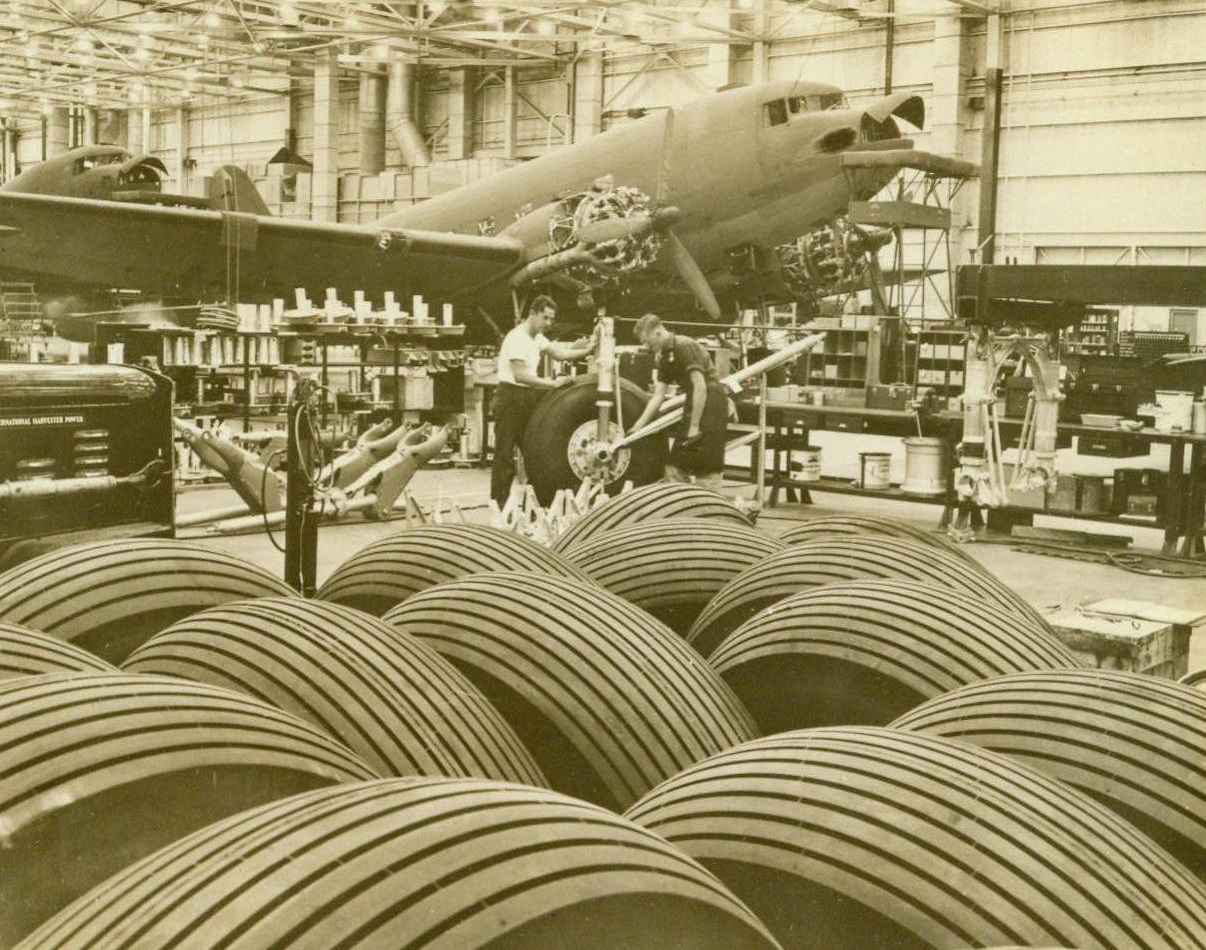
Round The Clock Birth Of American Air Power, 3/15/1943. The awesome aircraft production figures of the United States come to life with a glimpse behind factory windows that are never dark. Out of steel, rubber, alloys and the sweat of man is created the American air might that is haunting the trio of Axis leaders. To do a round-the-clock job of crumbling the industries, supplies and morale of our enemies. Planes must be produced round-the-clock, rolling off production lines that operate with the efficiency of a single, well-oiled machine. Here are some cogs in that machine Here’s why, brother. These great hunks of rubber are casings for the landing wheels of the transport planes that are carrying fighters and supplies across oceans and mountain peaks. Civilians will get their tires—when the paratroopers come home to stay. 3/15/43 (ACME);
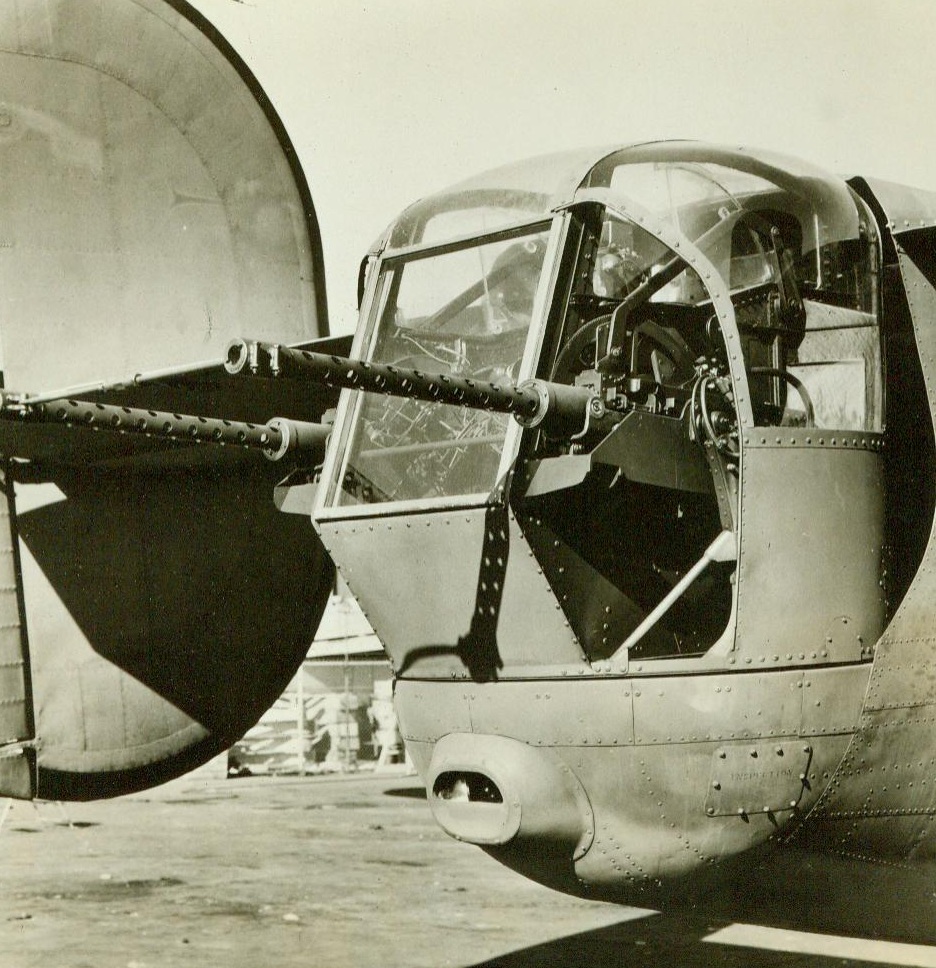
Stingers, 3/15/1943. San Diego, Calif. – Mounted in a moveable powered turret, .50 caliber machine guns are ready to sing hyms of death from the tail of a giant consolidated liberator B-24 bomber. They are the tools of war of little fellows, for no fighter heavier than 160 pounds or taller than five-feet-ten can squeeze his bulk into the gunner’s compartment. The unfriendly, modern weapons swing up and down as well as sideways, to catch the enemy at a variety of attacking positions. 3/15/43 (ACME);
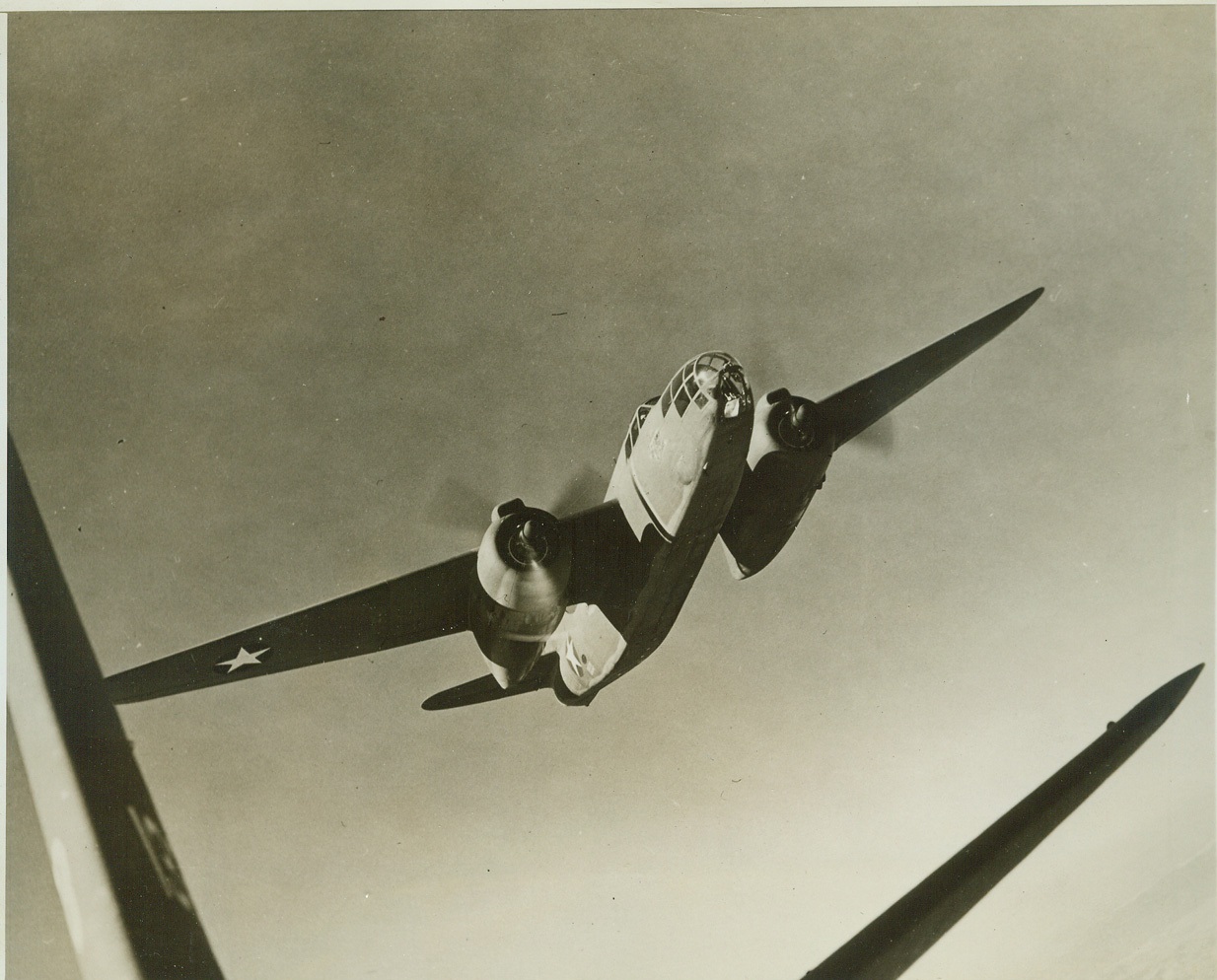
Round the Clock Birth of American Power, 3/15/1943. The awesome aircraft production figures of the United States come to life with a glimpse behind factory windows that are never dark. Out of steel, rubber, alloys, and the sweat of man is created the American air might that is haunting the trio of Axis leaders. To do a round-the-clock job of crumbling the industries, supplies and morale of our enemies, planes must be produced round-the-clock, rolling off production lines that operate with the efficiency of a single, well-oiled machine. Here are some important cogs in that machine. Credit: ACME;
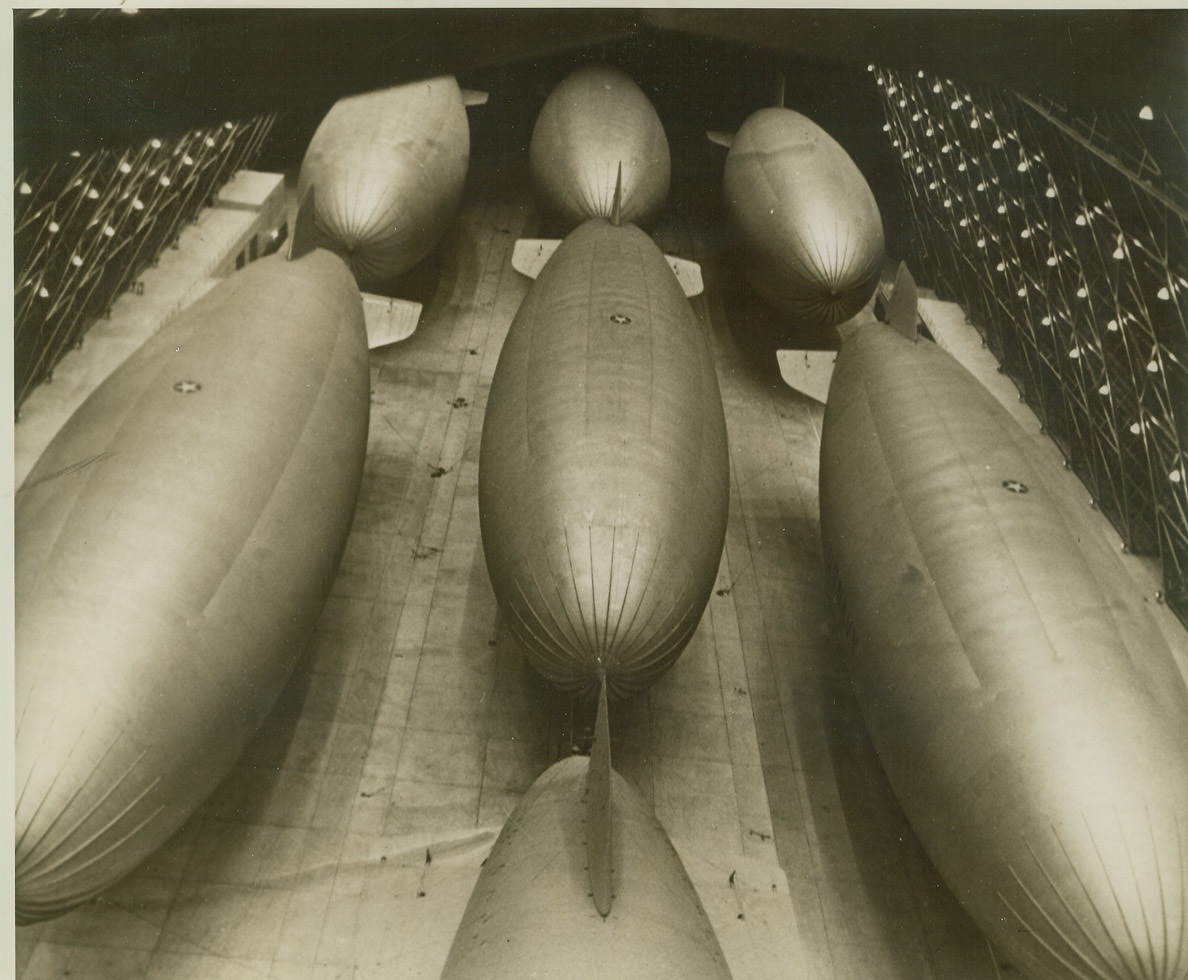
Sea Lane Protectors, 3/3/1943. Taken inside one of the U.S. Navy’s great airship hangars, on “docks,” photo shows parts of seven off-duty blimps. The non-rigid patrol ships are a vital component of the naval forces that protect important sea lanes off American shores, part of the Navy’s anti-submarine arm. Credit: Official U.S. Navy photo from (illegible portion of caption);
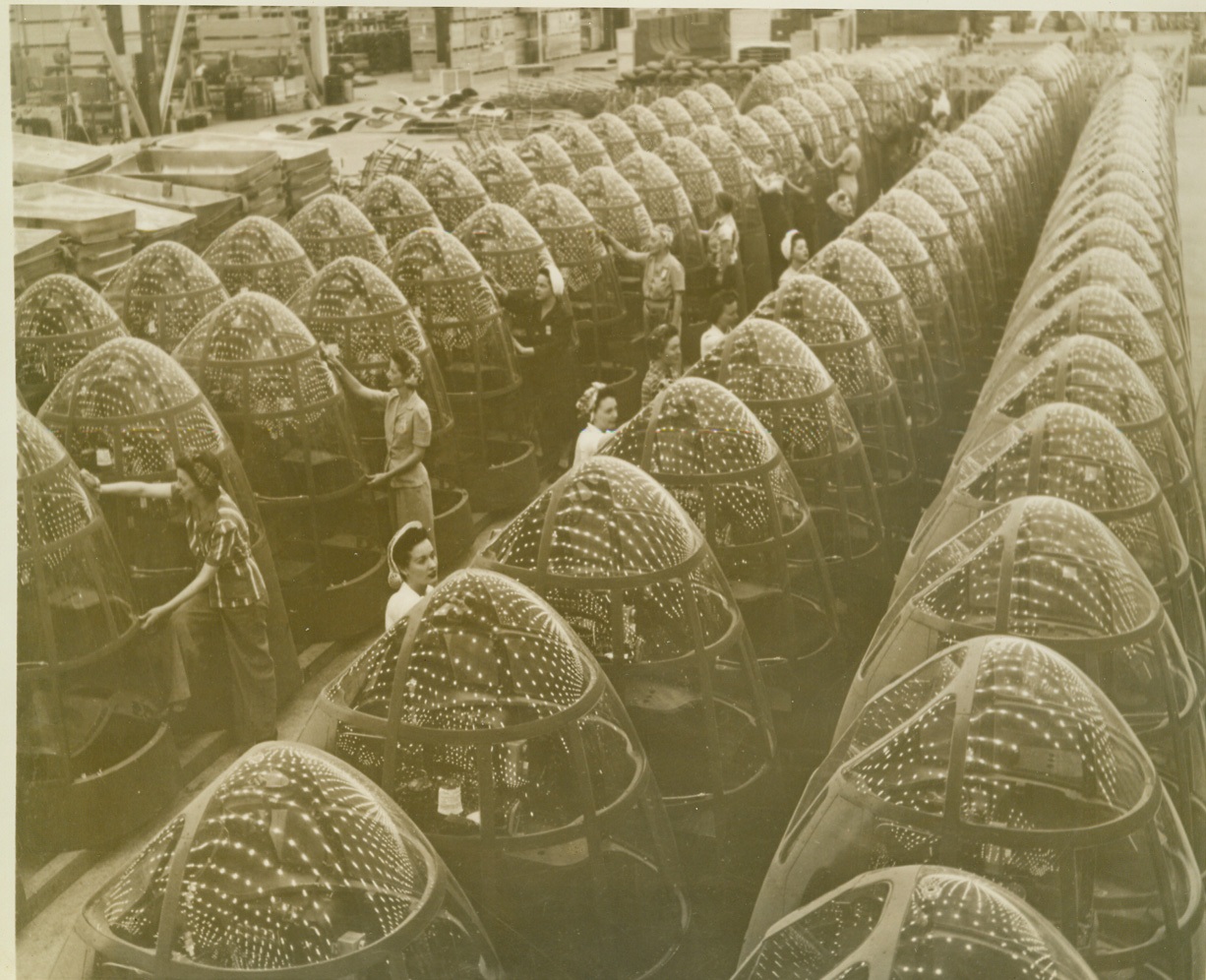
Round the Clock Birth of American Air Power, 3/15/1943. Not only are these Douglas aircraft women workers unconcerned about the shininess of their own proboscises, but their official job is to put a high shine on the noses of planes. Soon, the factory lights reflected in the plexi-glass plane noses will be replaced by foreign stars and the brighter flashes of a wartime sky. Credit: ACME;
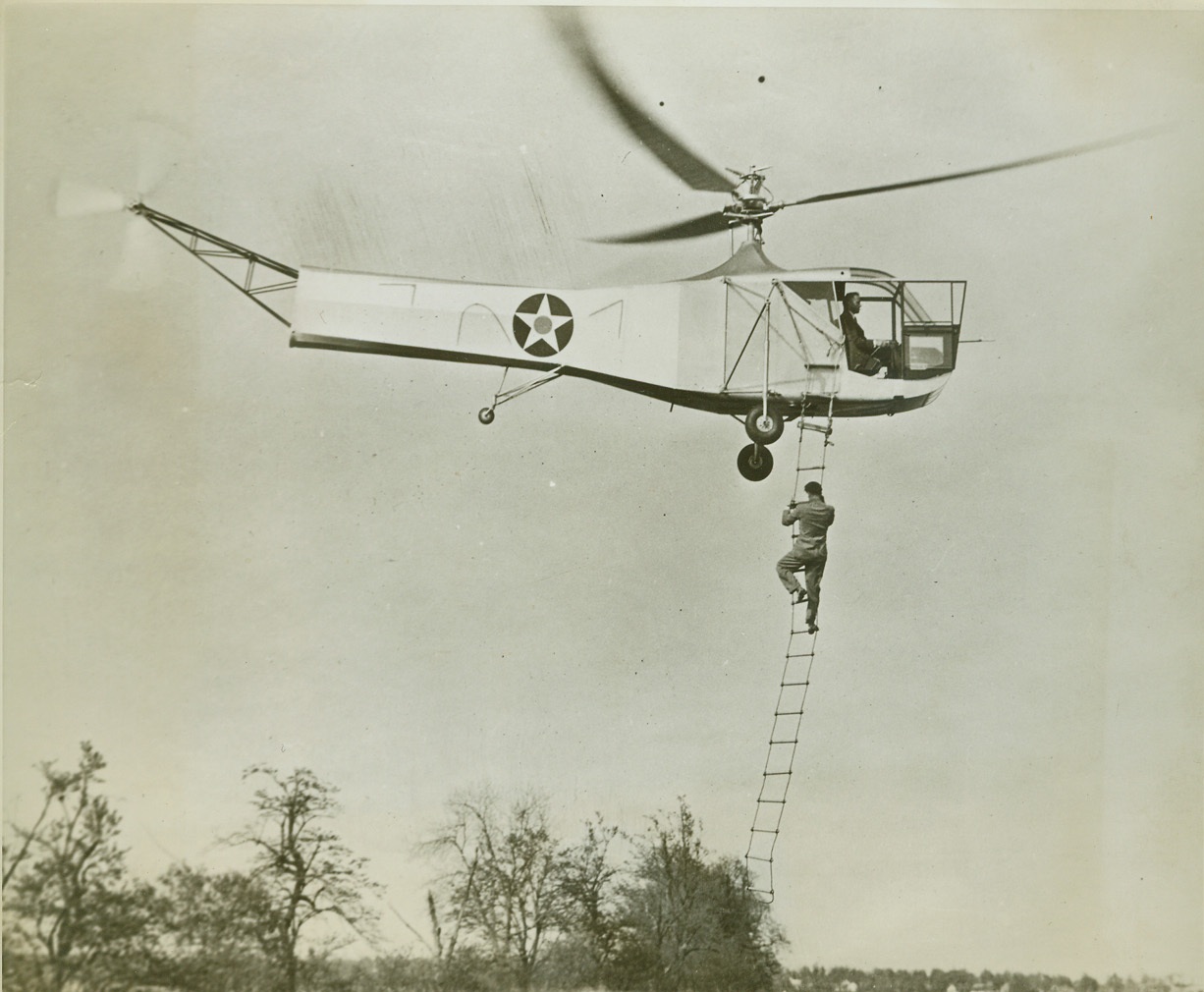
Hey—Wait For Me!, 3/6/1943. Washington, D.C.—Getting aboard the Sikorsky helicopter is an easy matter for the tardy passenger who missed the takeoff. The pilot merely drops a ladder and allows the plane to hover motionless. 30 feet above the ground, as his passenger climbs the rope ladder. Because of its many military uses, the two-place helicopter has been developed for the U.S. Army. Among its more important features is the facility with which the helicopter lands and takes off in limited space. Credit: ACME;
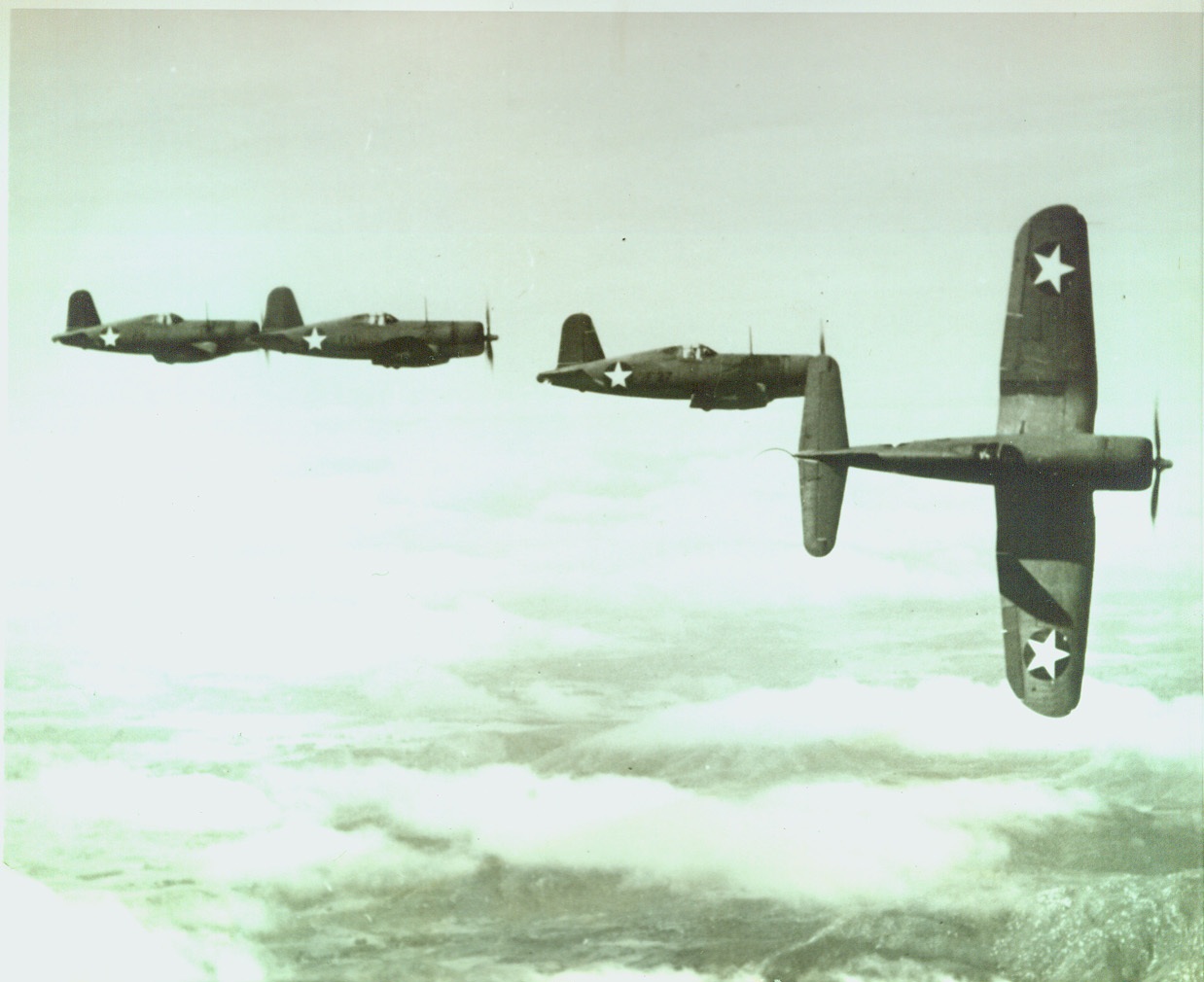
Corsairs Peeling Off, 3/23/1943. New U.S. Navy F4U-I Fighters peel off one by one from formation on high altitude practice flight. Known as Corsairs, the Vought-Sikorsky built planes are powerful additions to the nation's defense forces.;
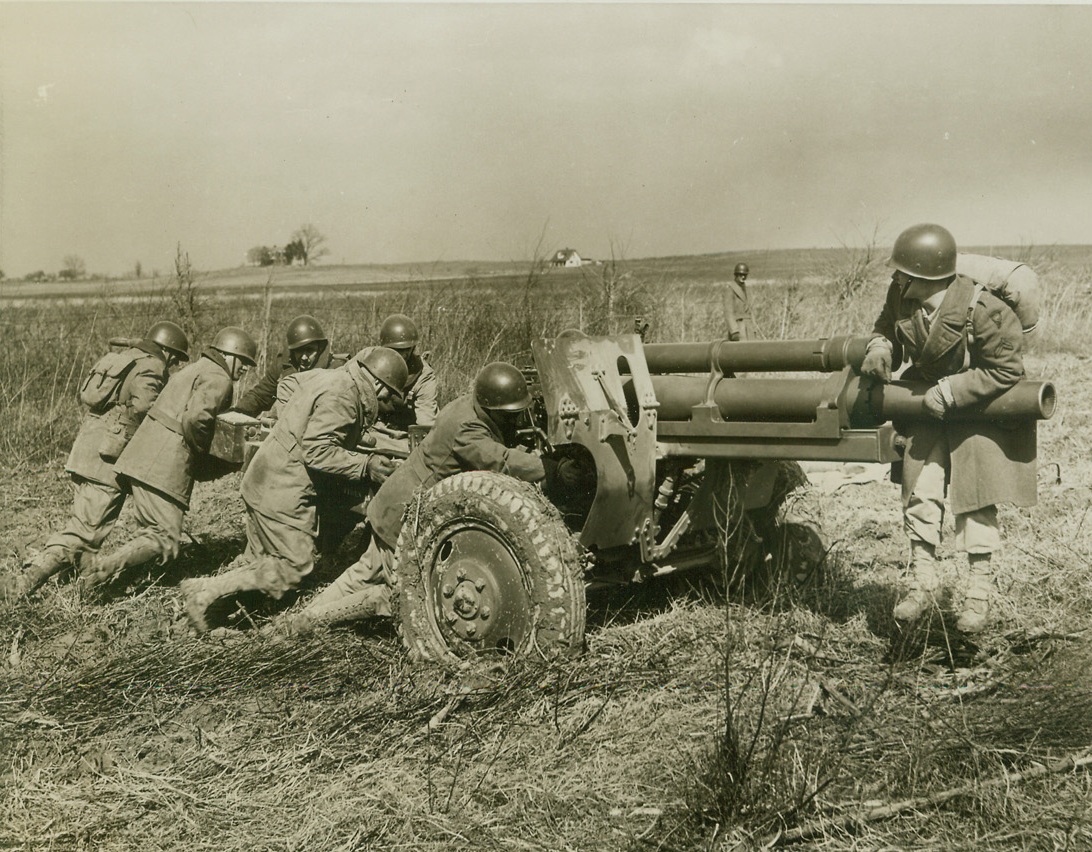
Union Workers Move Big Army Gun, 3/23/1943. Camp Atterbury, Ind.—The men moving this 105 mm Howitzer into place are union workmen—but not because the union insists on doing Army work. These men, war workers on leave from doing their own jobs, are guests at Camp Atterbury, Ind. Where they are spending three days learning something about Army life. So the Army obligingly puts them to work. Credit: ACME.;
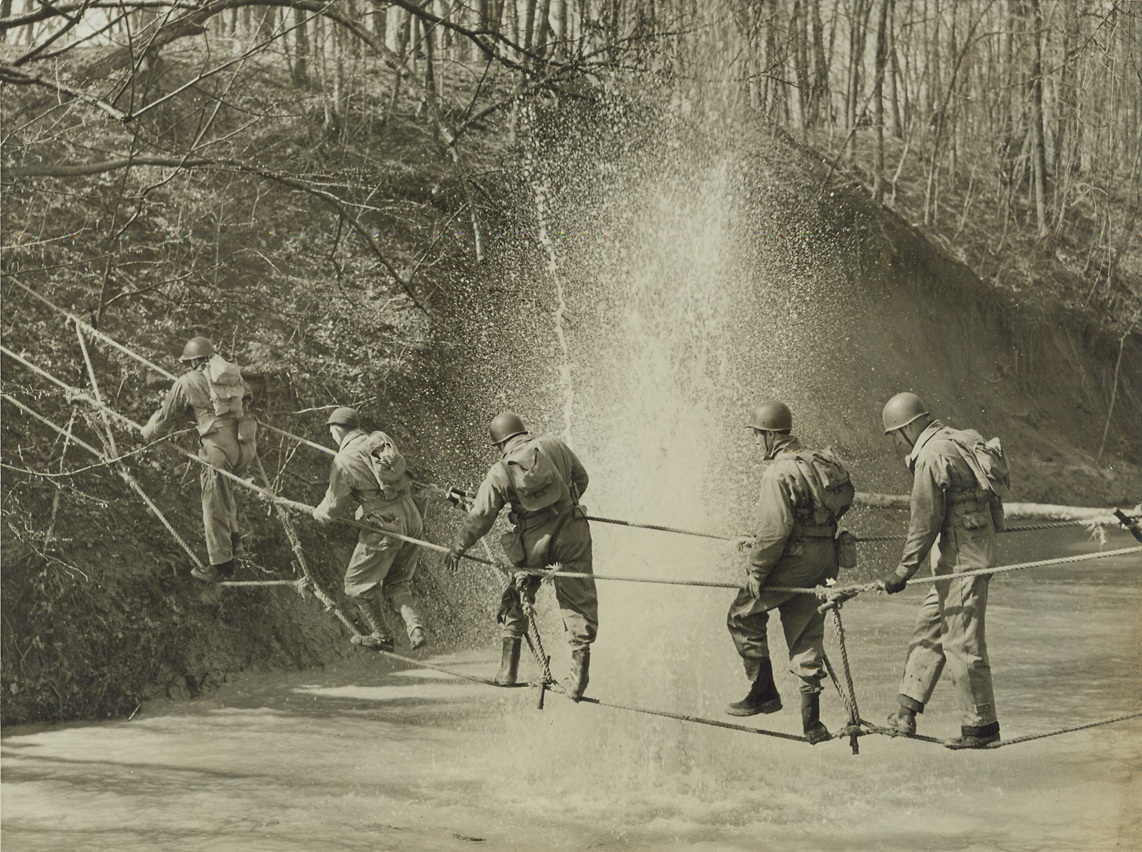
“Union Guests” Get Ranger Training, 3/23/1943. Camp Atterbury, Ind.: A group of CIO-UAW members that were invited to this camp, to find out how the Army lives, are shown as they crossed a rope bridge under actual war conditions as a bomb drops into the water nearby. The feat is part of the regular “Ranger” training, during which actual war conditions are copied. Credit: ACME.;
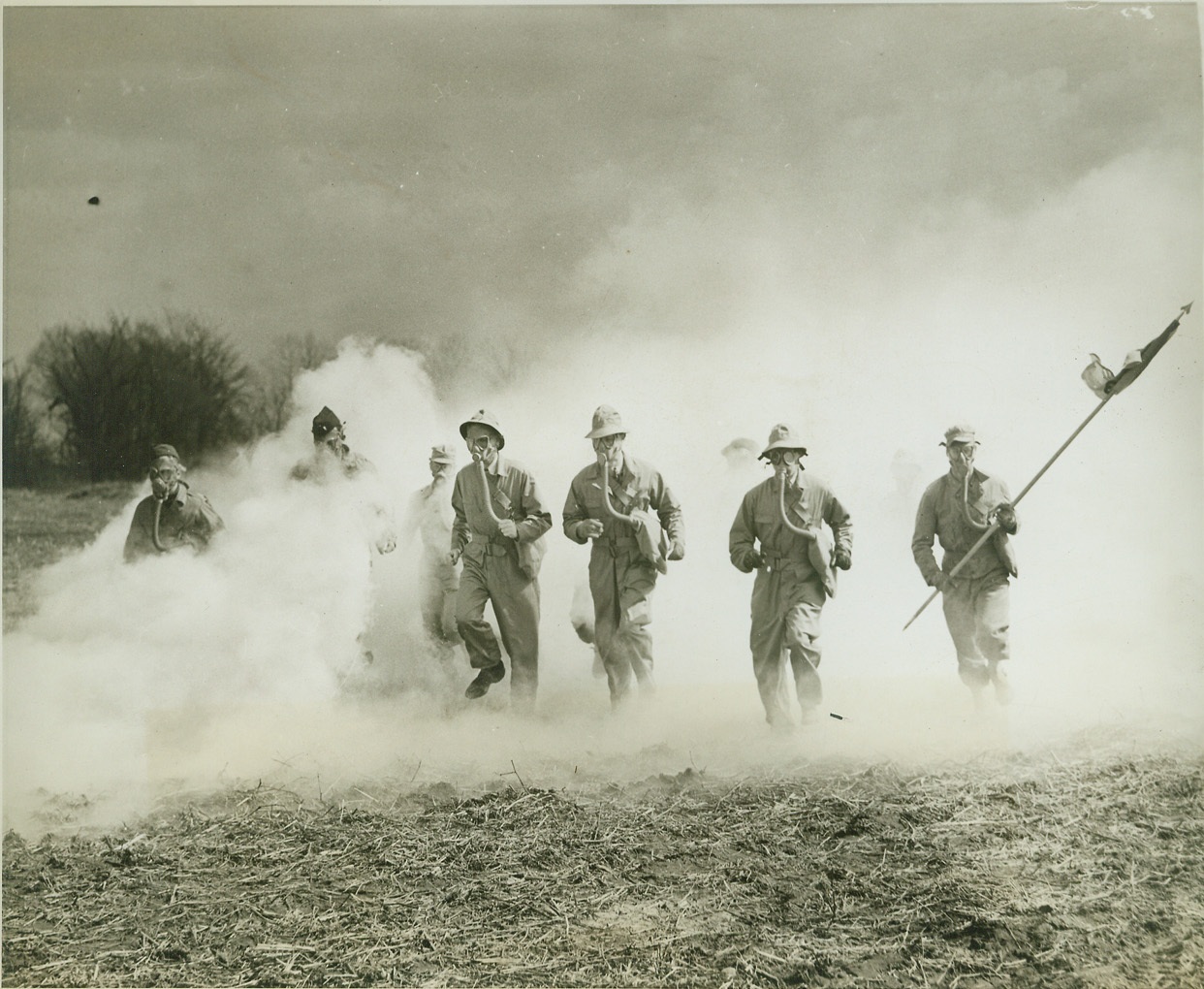
Army Camp “Guests” Learn Chemical Warfare, 3/23/1943. Camp Atterbury, Ind.—Some of the 250 members of the CIO-UAW who are guests at Camp Atterbury, Ind. Where they are spending three days learning how a soldier works and lives, don gas masks and are put through a chemical warfare drill. Credit: ACME.;
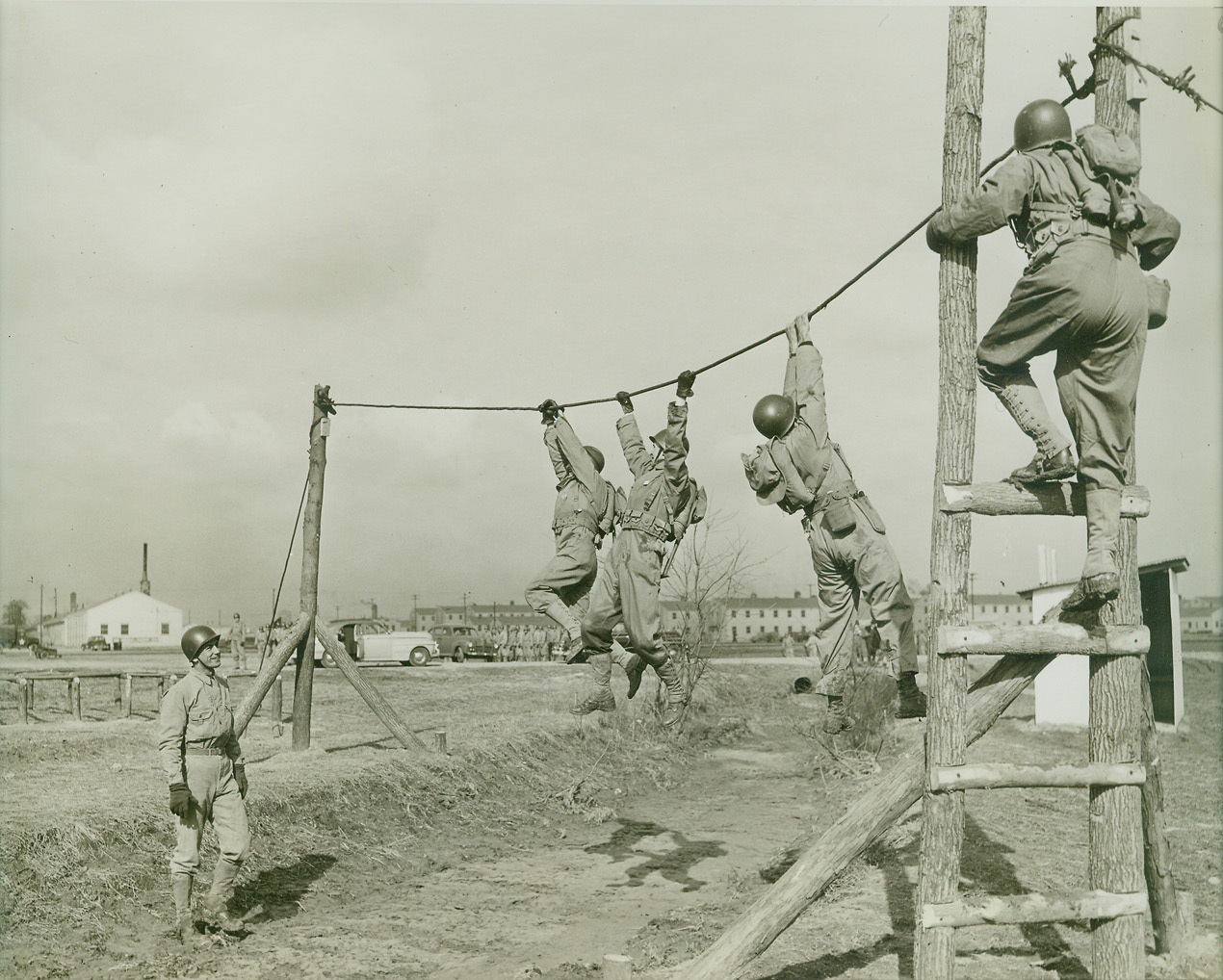
Union Leaders Get Taste of Army Life, 3/22/1943. Camp Atterbury, Ind.—Some of the 250 CIO-UAW leaders who are spending a few days at Camp Atterbury, Ind., to learn how our fighters live are shown above crossing over a hand-over-hand bridge, carrying full packs, on the obstacle course. Credit: ACME.;
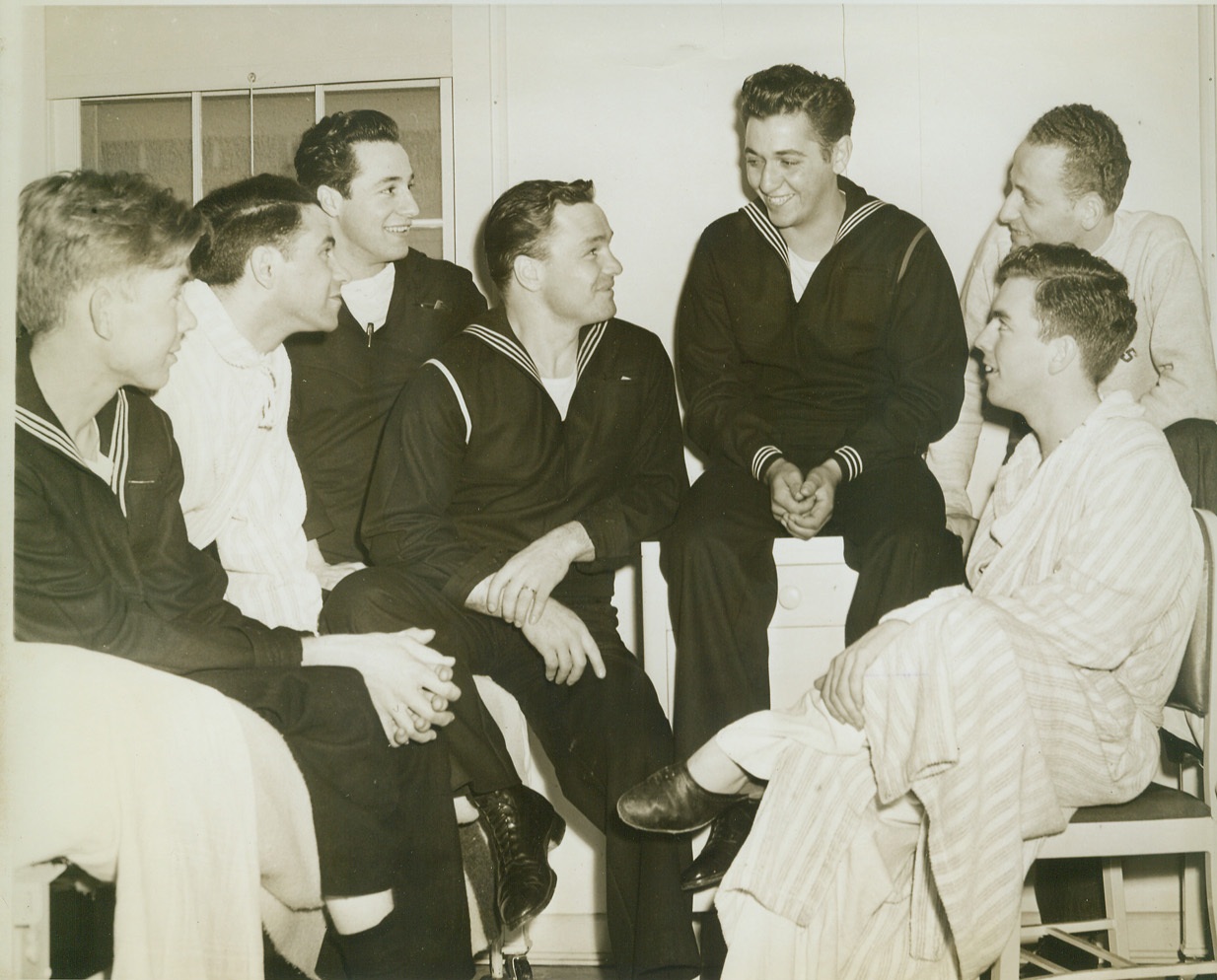
He Lives to Tell the Tale, 3/12/1943. Bethesda, MD.—Basil Izzi, of South Barry, Mass., who was one of the three survivors of five who drifted on a raft on the South Atlantic for 83 days, relates his experiences to fellow patients at the Naval Hospital here. Left to right: Dominic Hutchison, Mims, Fla.; Emil Heifitz, Cleveland, Ohio; Joseph Castelluci, Somerville, Mass.; Joseph Marinko, St. Louis, MO.; Izzi; Al Silver, Baltimore; and Ed Parker, Richmond, VA. Credit: ACME.;
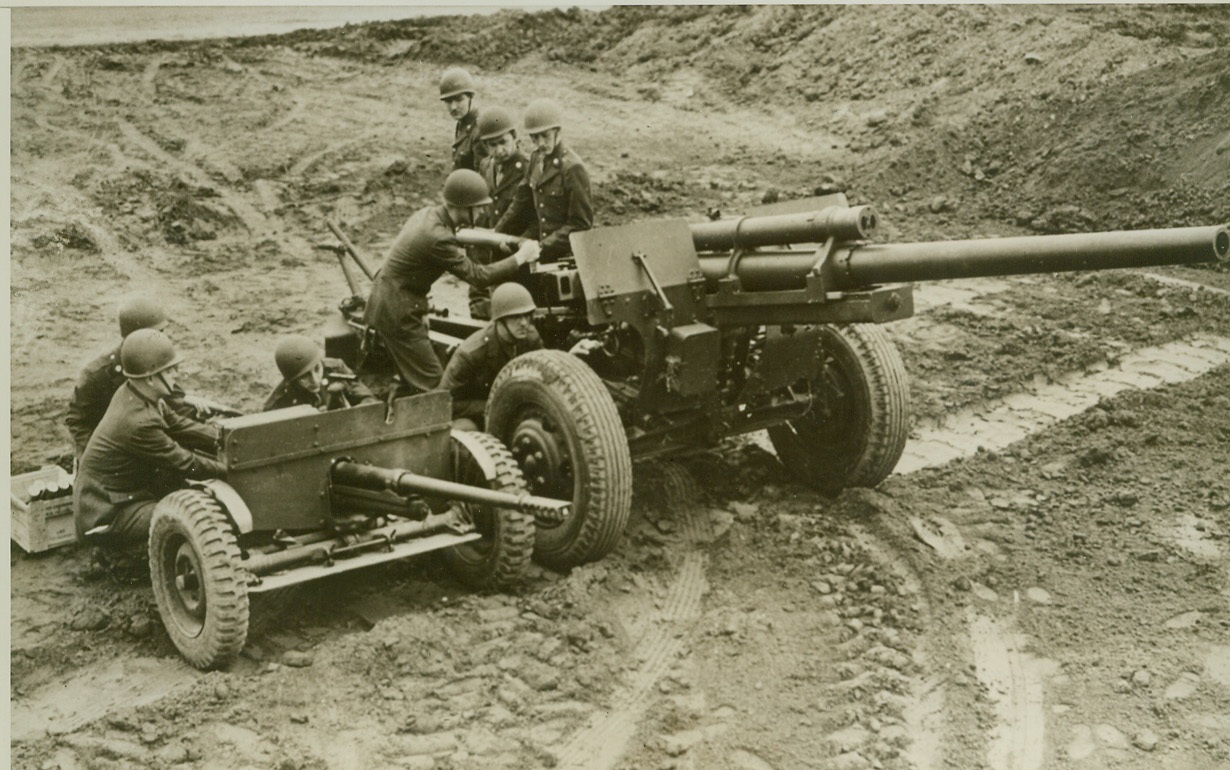
Death to Enemy Armored Forces, 3/1/1943. Aberdeen, MD.—These two U.S. Army anti-tank guns, shown at the proving ground of the Army Ordinance Department at Aberdeen are guaranteed to make it plenty tough for enemy tank and armored cars, the three-inch, high-velocity gun, (at right), can knock out even the heaviest of tanks with one shell at long range. At the left is the 37 mm weapon, using canister shot as an anti-personnel gun, was extremely effective against the Japs. The three-inch gun has been found superior to the German 88-mm cannon, in actual firing tests with armor plate targets. Credit: U.S. Army photo from ACME.;
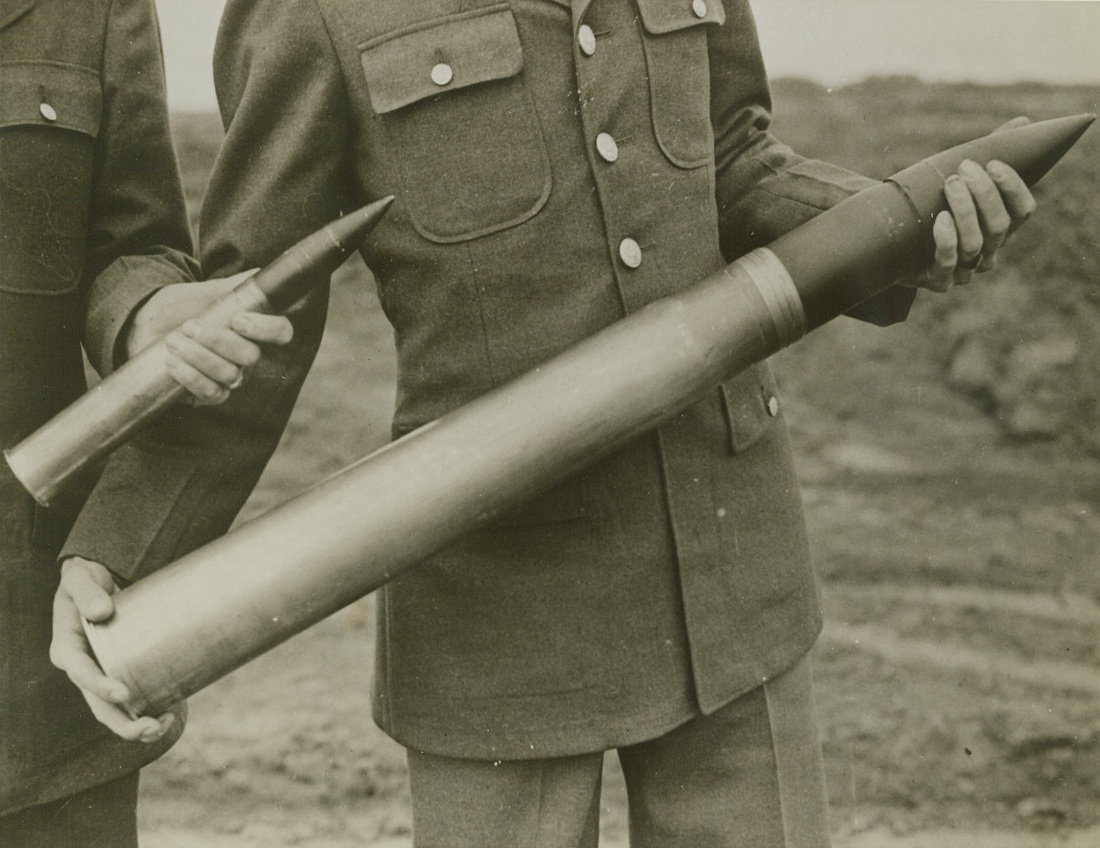
Big, and Little “Tank Busters”, 3/1/1943. Aberdeen, MD.—Shown at the U.S. Army Ordinance Department proving ground at Aberdeen, are these two deadly members of the Army’s “tank-busting” family. The three-inch, super-powered shell (lower), can knock out any enemy tank on which it makes a direct hit. The 37-mm. anti-tank shell, (upper), is used in smaller, high-velocity cannon against enemy scout cars. Both shells are known as “fixed ammunition,” meaning that their components (parts) are assembled as a complete unit. In firing tests against armor plate targets, the U.S. three-inch shell was found superior to the armor-piercing ammunition of the German 88-mm. gun. Credit: U.S. Army photo from ACME.;
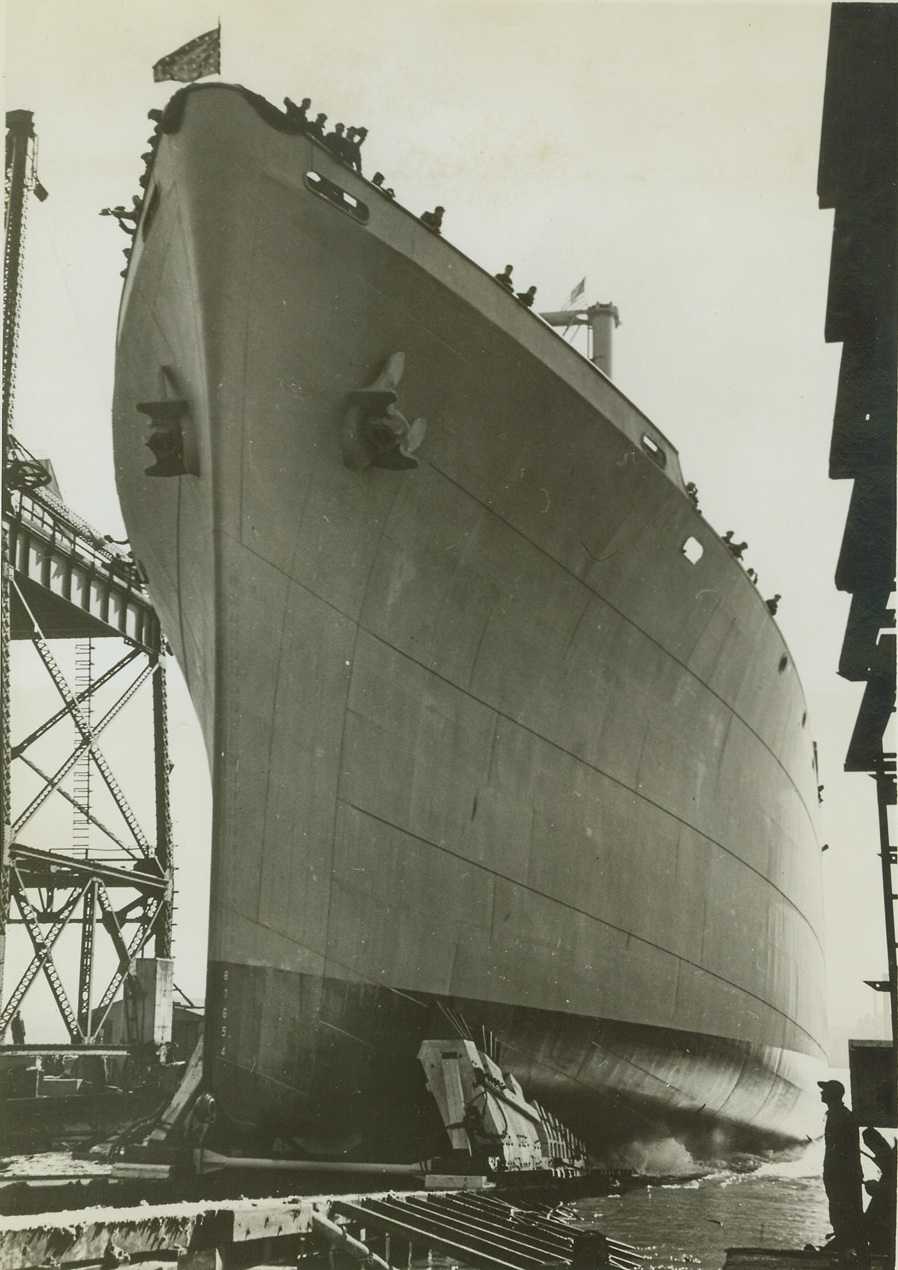
Named for Blue Ridge Mts., 3/7/1943, Kearny, N.J.—Sliding down the ways at Federal Shipbuilding and Dry Dock Company’s Kearny Shipyards, the U.S.S. Blue Ridge is one of the first two naval vessels to bear the name of an American mountain. The other ship, the U.S.S. Rocky Mt., was launched at the same time. Both are converted C-2 type cargo vessels, which will be assigned for special Navy duty. Mrs. David Arnott, wife of the Vice President and Chief Surveyor of the American Bureau of Shipping, sponsored the Blue Ridge at today’s (March 7) ceremonies, while Mrs. Robert C. Lee, wife of the president of the Propellor Club of the U.S., sponsored by the Rocky Mt. Credit: ACME.;
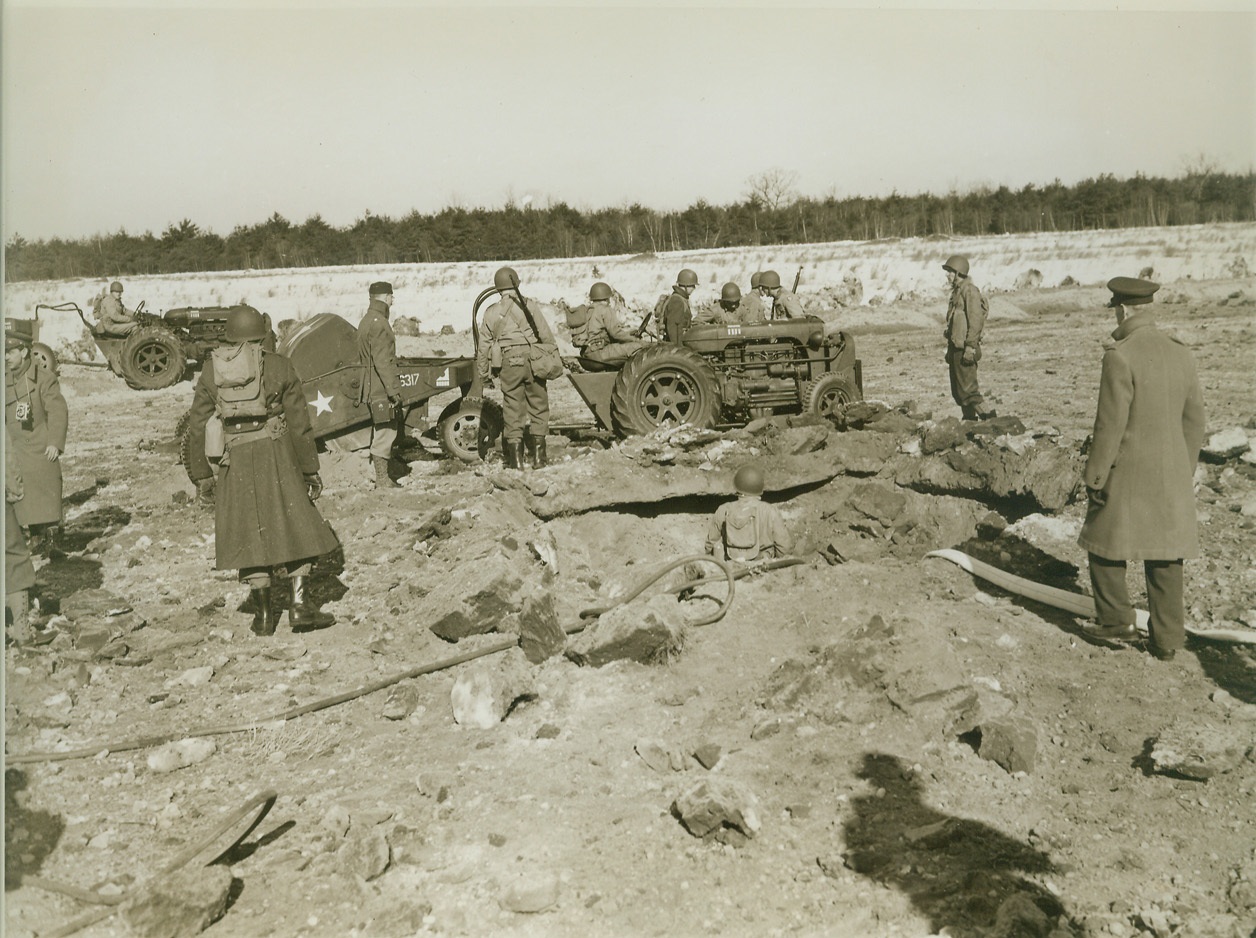
Getting to Work, 3/3/1943. Westover Field, Mass.—Their equipment unloaded from the planes that brought them to the site of a bomb explosion, airborne engineers, training at Westover Field, begin to repair the damaged earth runway. Credit: ACME.;
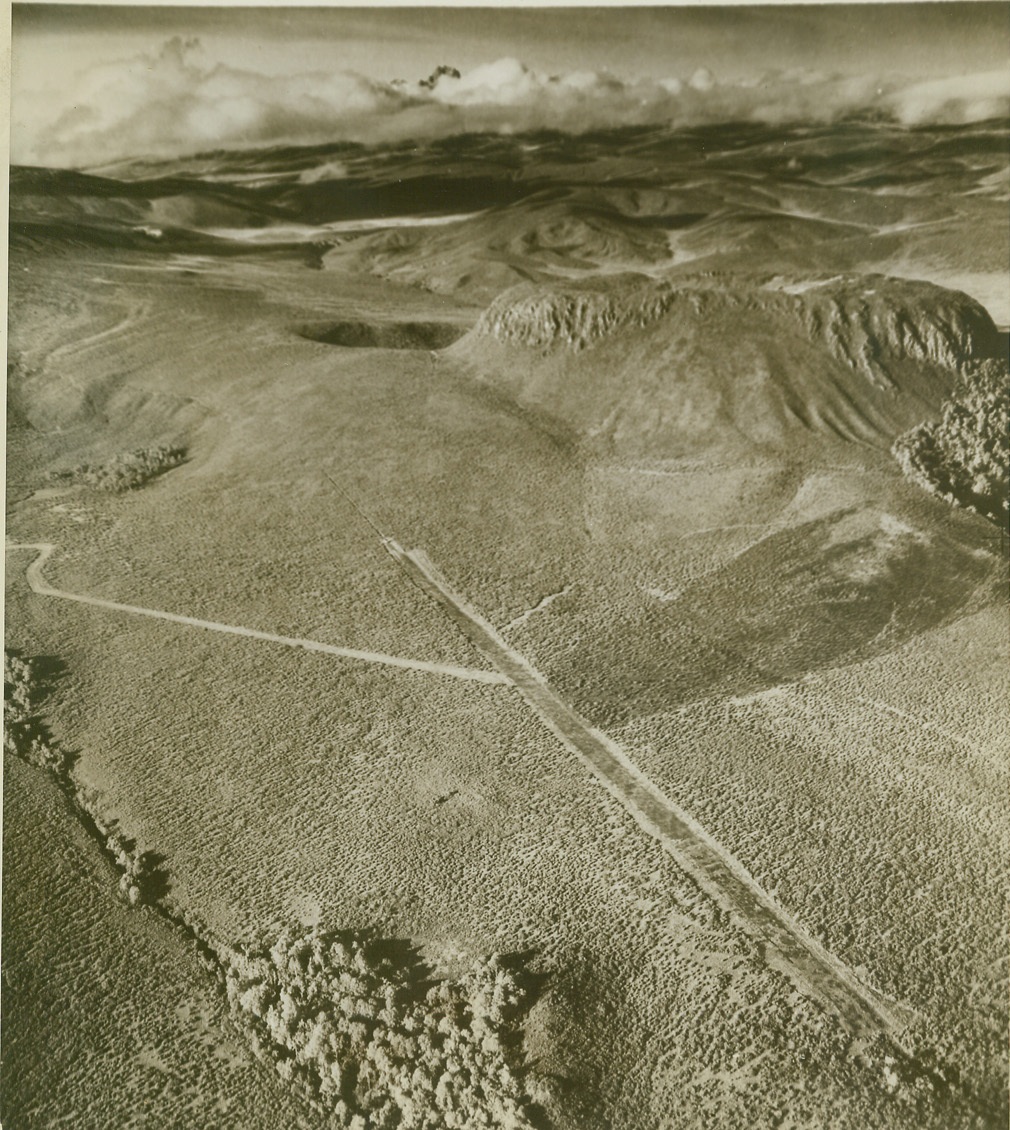
RIBBONS OF ROAD, 3/10/1943. MOUNT KENYA – Weaving across the rugged moorland on the slope of Mount Kenya like narrow strips of ribbon, this road and runway were built so that an RAF plane, forced down on the mountain, could return to its home base. Gathering rocks and stones to fill holes, and cutting heather and brush, 150 natives built the runway after four solid weeks of work. A road (at left) was cut from the marooned aircraft to the runway at the same time. Credit: OWI Radiophoto from ACME;
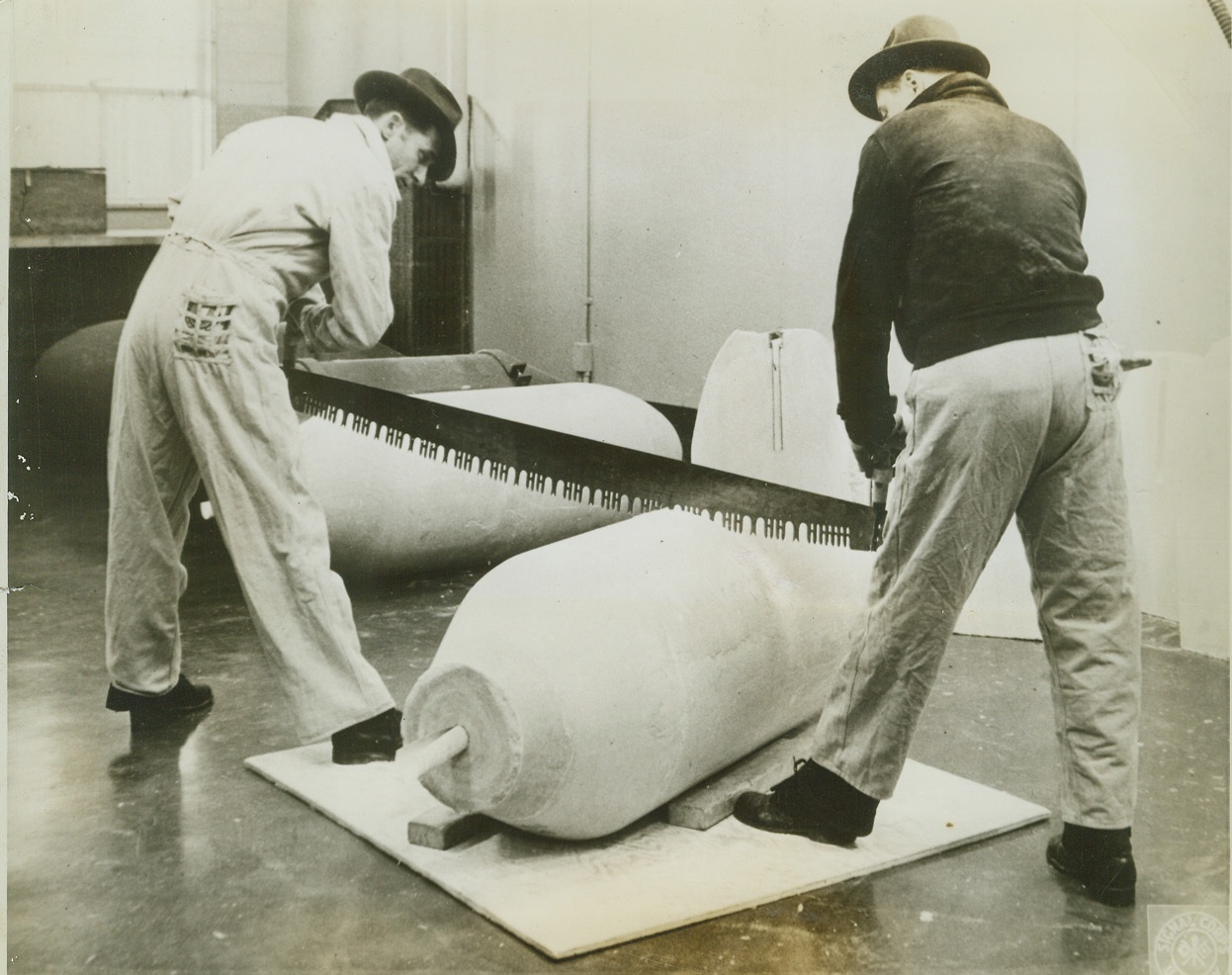
WE WOULDN’T WANT THIS JOB—WOULD YOU?, 3/12/1943. RAVENNA, OHIO—It isn’t as dangerous as it seems! These men two workers at the 30,000 acre governmental Ordnance plant here are sawing through the core of a one-ton bomb, said core being amatol, a high explosive that blow the steel of a bomb asunder and writes finis to Axis designs on world domination. Cores are subjected to this test during munitions making to determine solidity. Credit: OWI Radiophoto from ACME;





 Trash & Recycling
Trash & Recycling
 Online Payments
Online Payments
 City Documents
City Documents
 Parks
Parks
 Traffic Court
Traffic Court
 CITY PARKS
CITY PARKS
 Outdoor Recreation
Outdoor Recreation
 Volunteer
Volunteer
 Home
Home TRANSLATE
TRANSLATE
